
REGENTS IN ELA
The University of the State of New York
REGENTS HIGH SCHOOL EXAMINATION
REGENTS EXAMINATION
IN
ENGLISH LANGUAGE ARTS
Tuesday, June 12, 2018 — 9:15 a.m. to 12:15 p.m., only
The possession or use of any communications device is strictly prohibited
when taking this examination. If you have or use any communications device,
no matter how briefly, your examination will be invalidated and no score will be
calculated for you.
A separate answer sheet has been provided for you. Follow the instructions
for completing the student information on your answer sheet. You must also fill in
the heading on each page of your essay booklet that has a space for it, and write
your name at the top of each sheet of scrap paper.
The examination has three parts. For Part 1, you are to read the texts and
answer all 24 multiple-choice questions. For Part 2, you are to read the texts and
write one source-based argument. For Part 3, you are to read the text and write a
text-analysis response. The source-based argument and text-analysis response should
be written in pen. Keep in mind that the language and perspectives in a text may
reflect the historical and/or cultural context of the time or place in which it was
written.
When you have completed the examination, you must sign the statement
printed at the bottom of the front of the answer sheet, indicating that you had no
unlawful knowledge of the questions or answers prior to the examination and that
you have neither given nor received assistance in answering any of the questions
during the examination. Your answer sheet cannot be accepted if you fail to sign
this declaration.
DO NOT OPEN THIS EXAMINATION BOOKLET UNTIL THE SIGNAL IS GIVEN.
REGENTS IN ELA

Part 1
Directions (1–24): Closely read each of the three passages below. After each passage, there are several multiple-
choice questions. Select the best suggested answer to each question and record your answer on the separate
answer sheet provided for you. You may use the margins to take notes as you read.
5
10
15
20
25
30
Reading Comprehension Passage A
“That woman’s art-jargon
1
tires me,” said Clovis to his journalist friend. “She’s so fond
of talking of certain pictures as ‘growing on one,’ as though they were a sort of fungus.”
“That reminds me,” said the journalist, “of the story of Henri Deplis. Have I ever told
it [to] you?”
Clovis shook his head.
“Henri Deplis was by birth a native of the Grand Duchy of Luxemburg. On maturer
reflection he became a commercial traveller. His business activities frequently took him
beyond the limits of the Grand Duchy, and he was stopping in a small town of Northern
Italy when news reached him from home that a legacy
2
from a distant and deceased relative
had fallen to his share.
“It was not a large legacy, even from the modest standpoint of Henri Deplis, but it
impelled him towards some seemingly harmless extravagances. In particular it led him to
patronise local art as represented by the tattoo-needles of Signor Andreas Pincini. Signor
Pincini was, perhaps, the most brilliant master of tattoo craft that Italy had ever known, but
his circumstances were decidedly impoverished, and for the sum of six hundred francs he
gladly undertook to cover his client’s back, from the collar-bone down to the waistline, with
a glowing representation of the Fall of Icarus.
3
The design, when finally developed, was a
slight disappointment to Monsieur Deplis, who had suspected Icarus of being a fortress
taken by Wallenstein in the Thirty Years’ War, but he was more than satisfied with the
execution of the work, which was acclaimed by all who had the privilege of seeing it as
Pincini’s masterpiece.
“It was his greatest effort, and his last. Without even waiting to be paid, the illustrious
craftsman departed this life, and was buried under an ornate tombstone, whose winged
cherubs would have afforded singularly little scope
4
for the exercise of his favourite art.
There remained, however, the widow Pincini, to whom the six hundred francs were due.
And thereupon arose the great crisis in the life of Henri Deplis, traveller of commerce. The
legacy, under the stress of numerous little calls on its substance,
5
had dwindled to very
insignificant proportions, and when a pressing wine bill and sundry
6
other current accounts
had been paid, there remained little more than 430 francs to offer to the widow. The lady
was properly indignant, not wholly, as she volubly explained, on account of the suggested
writing-off of 170 francs, but also at the attempt to depreciate the value of her late
husband’s acknowledged masterpiece. In a week’s time Deplis was obliged to reduce his
offer to 405 francs, which circumstance fanned the widow’s indignation into a fury. She
cancelled the sale of the work of art, and a few days later Deplis learned with a sense of
1
art-jargon — language specific to the art world
2
legacy — inheritance
3
Fall of Icarus — In Greek mythology Icarus wore wings made of wax and feathers so he could fly. However, because
of his excessive pride and carelessness he flew too close to the sun. His wings melted and he plunged to his death
in the sea.
4
scope — opportunity
5
little calls on its substance — withdrawals from the inheritance
6
sundry — various
Regents Exam in ELA — June ’18 [2]

35
40
45
50
55
60
65
70
consternation
7
that she had presented it to the municipality of Bergamo, which had
gratefully accepted it. He left the neighbourhood as unobtrusively as possible, and was
genuinely relieved when his business commands took him to Rome, where he hoped his
identity and that of the famous picture might be lost sight of.
“But he bore on his back the burden of the dead man’s genius. On presenting himself one
day in the steaming corridor of a vapour bath, he was at once hustled back into his clothes
by the proprietor, who was a North Italian, and who emphatically refused to allow the
celebrated Fall of Icarus to be publicly on view without the permission of the municipality
of Bergamo. Public interest and official vigilance increased as the matter became more
widely known, and Deplis was unable to take a simple dip in the sea or river on the hottest
afternoon unless clothed up to the collar-bone in a substantial bathing garment. Later on
the authorities of Bergamo conceived the idea that salt water might be injurious to the
masterpiece, and a perpetual injunction
8
was obtained which debarred
9
the muchly harassed
commercial traveller from sea bathing under any circumstances. Altogether, he was
fervently thankful when his firm of employers found him a new range of activities in the
neighbourhood of Bordeaux. His thankfulness, however, ceased abruptly at the Franco-
Italian frontier. An imposing array of official force barred his departure, and he was sternly
reminded of the stringent law, which forbids the exportation of Italian works of art.
“A diplomatic parley ensued between the Luxemburgian and Italian Governments, and
at one time the European situation became overcast with the possibilities of trouble. But
the Italian Government stood firm; it declined to concern itself in the least with the
fortunes or even the existence of Henri Deplis, commercial traveller, but was immovable in
its decision that the Fall of Icarus (by the late Pincini, Andreas) at present the property of
the municipality of Bergamo, should not leave the country. …
“Meanwhile, the unhappy human background fared no better than before, and it was
not surprising that he drifted into the ranks of Italian anarchists. Four times at least he was
escorted to the frontier as a dangerous and undesirable foreigner, but he was always
brought back as the Fall of Icarus (attributed to Pincini, Andreas, early Twentieth Century).
And then one day, at an anarchist congress at Genoa, a fellow-worker, in the heat of debate,
broke a phial full of corrosive liquid over his back. The red shirt that he was wearing
mitigated
10
the effects, but the Icarus was ruined beyond recognition. His assailant was
severely reprimanded for assaulting a fellow-anarchist and received seven years’
imprisonment for defacing a national art treasure. As soon as he was able to leave the
hospital Henri Deplis was put across the frontier as an undesirable alien.
“In the quieter streets of Paris, especially in the neighbourhood of the Ministry of Fine
Arts, you may sometimes meet a depressed, anxious-looking man, who, if you pass him the
time of day, will answer you with a slight Luxemburgian accent. He nurses the illusion that
he is one of the lost arms of the Venus de Milo,
11
and hopes that the French Government
may be persuaded to buy him. On all other subjects I believe he is tolerably sane.”
—H.H. Munro (“Saki”)
excerpted and adapted from “The Background”
The Chronicles of Clovis, 1912
John Lane, The Bodley Head
7
consternation — alarmed amazement
8
injunction — restraint
9
debarred — prevented
10
mitigated — lessened
11
Venus de Milo — a famous statue of the goddess Venus
Regents Exam in ELA — June ’18 [3] [OVER]

1 Lines 11 through 13 and lines 25 through 29
reveal that Henri Deplis
(1) invests wisely
(2) behaves impulsively
(3) avoids confrontation
(4) resists change
2 The municipality of Bergamo owns the artwork
on Henri Deplis’
s back as a result of
(1) a harmless misunderstanding
(2) widow Pincini’
s vengeance
(3) a fair exchange
(4) Henri Deplis’
s pride
3
As used in line 36, the word “unobtrusively” most
nearly means
(1) reluctantly
(3) rebelliously
(2) indecisively (4) inconspicuously
4 The figurative language in line 39 implies that
Henri Deplis feels
(1) the tattoo is a curse to him
(2) responsible for the artist’s death
(3) the tattoo is a thing of beauty
(4) obligated to display the artwork
5 Lines 50 through 52 indicate that Henri Deplis’s
situation causes him to become
(1) successful (3) manipulative
(2) powerless (4) respected
6
It can be inferred that Henri Deplis joins the
“Italian anarchists” (line 60) because he
(1) is afraid for his future
(2) desires wealthy friends
(3) is unconcerned with international politics
(4) seeks gainful employment
7 Lines 65 through 68 support a central idea that
(1) people can achieve their personal goals
(2
) governments often choose stability over
change
(3) societies often value objects above individuals
(4) governments can develop reasonable
regulations
8 The phrase “nurses the illusion” (line 71) reveals
that Henri Deplis is
(1) fulfilling his ambitious dream
(2) searching for anonymity
(3) struggling with reality
(4) enjoying his freedom
9 The subject of Henri Deplis’s tattoo implies a
parallel to his
(1) social ignorance (3) sense of humility
(2) economic worth (4) loss of control
Regents Exam in ELA — June ’18 [4]

Reading Comprehension Passage B
Carmel Point
The extraordinary patience of things!
This beautiful place defaced with a crop of surburban houses —
How beautiful when we first beheld it,
Unbroken field of poppy and lupin
1
walled with clean cliffs;
5
No intrusion but two or three horses pasturing,
Or a few milch
2
cows rubbing their flanks on the outcrop
3
rock-heads —
Now the spoiler has come: does it care?
Not faintly. It has all time. It knows the people are a tide
That swells and in time will ebb, and all
10
Their works dissolve. Meanwhile the image of the pristine
4
beauty
Lives in the very grain of the granite,
Safe as the endless ocean that climbs our cliff. — As for us:
We must uncenter our minds from ourselves;
We must unhumanize our views a little, and become confident
15
As the rock and ocean that we were made from.
—Robinson Jeffers
The Collected Poetry of Robinson Jeffers, Volume Three, 1991
1
poppy and lupin — brightly colored wildflowers
2
milch — milk
3
outcrop — protruding
4
pristine — pure, unspoiled
10 The word “defaced” (line 2) suggests that the
narrator is
(1) suspicious (3) worried
(2) confused (4) critical
11 The description in lines 3 through 6 creates a
mood of
(1) despair (3)
tranquility
(2) amusement (4) negativity
12
The metaphor in lines 8 through 10 suggests that
(1) humanity’s impact is beneficial
(2) nature’s power is limited
(3) humanity’s influence is temporary
(4) nature’s significance is exaggerated
Stanford University Press
13 The words “uncenter” (line 13) and “unhumanize”
(line 14) suggest that people should
(1) become more tolerant
(2) recognize their superiority
(3) uphold their values
(4) become less egocentric
14 The narrator implies that humans are
(1) protective of their environment
(2) unaware of their insignificance
(3) perplexed by their surroundings
(4) satisfied with their indifference
Regents Exam in ELA — June ’18 [5] [OVER]

5
10
15
20
25
30
35
40
Reading Comprehension Passage C
Learning to Love Volatility
1
Several years before the financial crisis descended on us, I put forward the concept
of “black swans”: large events that are both unexpected and highly consequential. We never
see black swans coming, but when they do arrive, they profoundly shape our world: Think
of World War I, 9/11, the Internet, the rise of Google.
In economic life and history more generally, just about everything of consequence
comes from black swans; ordinary events have paltry
2
effects in the long term. Still, through
some mental bias, people think in hindsight that they “sort of” considered the possibility of
such events; this gives them confidence in continuing to formulate predictions. But our
tools for forecasting and risk measurement cannot begin to capture black swans. Indeed,
our faith in these tools make it more likely that we will continue to take dangerous,
uninformed risks.
Some made the mistake of thinking that I hoped to see us develop better methods for
predicting black swans. Others asked if we should just give up and throw our hands in the
air: If we could not measure the risks of potential blowups, what were we to do? The answer
is simple: We should try to create institutions that won’t fall apart when we encounter black
swans—or that might even gain from these unexpected events.
Fragility is the quality of things that are vulnerable to volatility. T
ake the coffee cup on
your desk: It wants peace and quiet because it incurs more harm than benefit from random
events. The opposite of fragile, therefore, isn’t robust or sturdy or resilient—things with
these qualities are simply difficult to break.
To deal with black swans, we instead need things that gain from volatility, variability
,
stress and disorder
. My (admittedly inelegant) term for this crucial quality is “antifragile.”
The only existing expression remotely close to the concept of antifragility is what we
derivatives traders
3
call “long gamma,” to describe financial packages that benefit from
market volatility. Crucially, both fragility and antifragility are measurable.
As a practical matter, emphasizing antifragility means that our private and public sectors
should be able to thrive and improve in the face of disorder. By grasping the mechanisms
of antifragility, we can make better decisions without the illusion of being able to predict
the next big thing. We can navigate situations in which the unknown predominates
4
and our
understanding is limited.
Herewith are five policy rules that can help us to establish antifragility as a principle of
our socioeconomic life.
Rule 1: Think of the economy as being more like a cat than a washing machine.
We are victims of the post-Enlightenment view that the world functions like a
sophisticated machine, to be understood like a textbook engineering problem and run by
wonks.
5
In other words, like a home appliance, not like the human body. If this were so, our
institutions would have no self-healing properties and would need someone to run and
micromanage them, to protect their safety, because they cannot survive on their own.
By contrast, natural or organic systems are antifragile: They need some dose of disorder
in order to develop. Deprive your bones of stress and they become brittle. This denial of
the antifragility of living or complex systems is the costliest mistake that we have made in
1
volatility — the amount of uncertainty or risk about the size of changes in investment values
2
paltry — insignificant
3
derivative traders — financial professionals who work buying and selling stock options, futures and other contracts
4
predominates — exerts control or influence
5
wonks — experts
Regents Exam in ELA — June ’18 [6]

45
50
55
60
65
70
75
80
modern times. Stifling natural fluctuations masks real problems, causing the explosions to
be both delayed and more intense when they do take place. As with the flammable material
accumulating on the forest floor in the absence of forest fires, problems hide in the absence
of stressors, and the resulting cumulative harm can take on tragic proportions. …
Rule 2: Favor businesses that benefit from their own mistakes, not those whose
mistakes percolate into the system.
Some businesses and political systems respond to stress better than others. The airline
industry is set up in such a way as to make travel safer after every plane crash. A tragedy
leads to the thorough examination and elimination of the cause of the problem. The same
thing happens in the restaurant industry, where the quality of your next meal depends on
the failure rate in the business—what kills some makes others stronger. Without the high
failure rate in the restaurant business, you would be eating Soviet-style cafeteria food for
your next meal out.
These industries are antifragile: The collective enterprise benefits from the fragility of
the individual components, so nothing fails in vain. These businesses have properties similar
to evolution in the natural world, with a well-functioning mechanism to benefit from
evolutionary pressures, one error at a time. …
Rule 3: Small is beautiful, but it is also efficient.
Experts in business and government are always talking about economies of scale. They
say that increasing the size of projects and institutions brings cost savings. But the
“efficient,” when too large, isn’
t so efficient. Size produces visible benefits but also hidden
risks; it increases exposure to the probability of large losses. Projects of $100 million seem
rational, but they tend to have much higher percentage overruns than projects of, say,
$10 million. Great size in itself, when it exceeds a certain threshold, produces fragility and
can eradicate all the gains from economies of scale. To see how large things can be fragile,
consider the difference between an elephant and a mouse: The former breaks a leg at the
slightest fall, while the latter is unharmed by a drop several multiples of its height. This
explains why we have so many more mice than elephants. …
Rule 4: T
rial and error beats academic knowledge.
Things that are antifragile love randomness and uncertainty, which also means—
crucially—that they can learn from errors. Tinkering by trial and error has traditionally
played a larger role than directed science in Western invention and innovation. Indeed,
advances in theoretical science have most often emerged from technological development,
which is closely tied to entrepreneurship.
6
Just think of the number of famous college
dropouts in the computer industry.
But I don’t mean just any version of trial and error. There is a crucial requirement to
achieve antifragility: The potential cost of errors needs to remain small; the potential gain
should be large. It is the asymmetry between upside and downside that allows antifragile
tinkering to benefit from disorder and uncertainty. …
America has emulated this earlier model, in the invention of everything from
cybernetics
7
to the pricing formulas for derivatives. They were developed by practitioners in
trial-and-error mode, drawing continuous feedback from reality. To promote antifragility,
we must recognize that there is an inverse relationship between the amount of formal
education that a culture supports and its volume of trial-and-error by tinkering. Innovation
doesn’t require theoretical instruction, what I like to compare to “lecturing birds on how to
fly.”
6
entrepreneurship — new business development and ownership
7
cybernetics — related to computer networks
Regents Exam in ELA — June ’18 [7] [OVER]

Rule 5: Decision makers must have skin in the game.
At no time in the history of humankind have more positions of power been assigned to
people who don’t take personal risks. But the idea of incentive in capitalism demands some
85
comparable form of disincentive. In the business world, the solution is simple: Bonuses that
go to managers whose firms subsequently fail should be clawed back, and there should be
additional financial penalties for those who hide risks under the rug. This has an excellent
precedent
8
in the practices of the ancients. The Romans forced engineers to sleep under a
bridge once it was completed.
90
Because our current system is so complex, it lacks elementary clarity: No regulator will
know more about the hidden risks of an enterprise than the engineer who can hide
exposures to rare events and be unharmed by their consequences. This rule would have
saved us from the banking crisis, when bankers who loaded their balance sheets with
exposures to small probability events collected bonuses during the quiet years and then
95
transferred the harm to the taxpayer, keeping their own compensation.
In these five rules, I have sketched out only a few of the more obvious policy
conclusions that we might draw from a proper appreciation of antifragility. But the
significance of antifragility runs deeper
. It is not just a useful heuristic
9
for socioeconomic
matters but a crucial property of life in general. Things that are antifragile only grow and
100
improve under adversity. This dynamic can be seen not just in economic life but in the
evolution of all things, from cuisine, urbanization and legal systems to our own existence as
a species on this planet. …
—Nassim Nicholas Taleb
excerpted from “Learning to Love Volatility”
The Wall Street Journal, November 16, 2012
8
precedent — established example
9
heuristic — formula
Regents Exam in ELA — June ’18 [8]

15 The author believes that “black swans” (line 2)
are
(1) used to anticipate failures
(2) unimportant setbacks
(3) unpredictable occurrences
(4) used to guarantee benefits
16 What is the tone of lines 15 and 16?
(1) insistent (3)
reverent
(2) sarcastic (4) pessimistic
17 The reference to “long gamma” (line 24) serves to
(1) introduce a political theory
(2) provide a relevant example
(3) oppose a previous argument
(4) support a scientific proposal
18 It can be inferred from lines 38 through 44 that
stressors
(1) should be seen as signals of faulty systems
(2) can be expected to occur in predictable
cycles
(3) must be carefully managed to avoid
instability
(4) should be viewed as opportunities to
improve performance
19
Lines 45 through 51 contribute to a central idea
by emphasizing the
(1) role of government in quality management
(2) dismissal of progressive practices
(3) importance of setbacks to industry success
(4) consequences of ignoring standards
20 Rule 3 suggests the most “efficient” way to manage
projects is to
(1) have an economic plan
(2) resist unnecessary growth
(3) encourage fragile economics
(4) revise corporate regulation
21 As used in line 76, the word “emulated” most
nearly means
(1) imitated (3)
accelerated
(2) discredited (4) ignored
22
The comparison drawn in lines 80 through 82
illustrates that innovation
(1) can be instinctive
(2) relies on education
(3) can be rigid
(4) depends on technology
23 The phrase “clawed back” (line 86) implies that
some managers
(1) are intolerant of traditional rules
(2) should be open to constructive criticism
(3) are wary of unconventional ideas
(4) should be accountable for careless decisions
24 Which statement best reflects a central idea
about disorder?
(1) “Things that are antifragile love randomness
and uncertainty
, which also means—crucial-
ly—that they can learn from errors” (lines 66
and 67)
(2) “There is a crucial requirement to achieve
antifragility: The potential cost of errors
needs to remain small; the potential gain
should be large” (lines 72 through 74)
(3) “At no time in the history of humankind
have more positions of power been assigned
to people who don’
t take personal risks”
(lines 83 and 84)
(4) “No regulator will know more about the hid-
den risks of an enterprise than the engineer
who can hide exposures to rare events” (lines
90 through 92)
Regents Exam in ELA — June ’18 [9] [OVER]
Part 2
Argument
Directions: Closely read each of the four texts provided on pages 11 through 18 and write a source-based
argument on the topic below. You may use the margins to take notes as you read and scrap paper to plan your
response. Write your argument beginning on page 1 of your essay booklet.
Topic: Is graffiti vandalism?
Your Task: Carefully read each of the four texts provided. Then, using evidence from at least three
of the texts,
write a well-developed argument regarding whether or not graffiti is vandalism. Clearly establish your claim,
distinguish your claim from alternate or opposing claims, and use specific, relevant, and sufficient evidence
from at least three of the texts to develop your argument. Do not simply summarize each text.
Guidelines:
Be sure to:
• Establish your claim regarding whether or not graffiti is vandalism
• Distinguish your claim from alternate or opposing claims
• Use specific, relevant, and sufficient evidence from at least three of the texts to develop your argument
• Identify each source that you reference by text number and line number(s) or graphic (for example:
T
ext 1, line 4 or T
ext 2, graphic)
• Organize your ideas in a cohesive and coherent manner
• Maintain a formal style of writing
• Follow the conventions of standard written English
T
exts:
T
ext 1 – What Is Street Art? Vandalism, Graffiti or Public Art – Part I
Text 2 – Graffiti Vandals Cost Public Millions
Text 3 – Is Urban Graffiti a Force for Good or Evil?
Text 4 – Art or Vandalism: Banksy, 5Pointz and the Fight for Artistic Expression
Regents Exam in ELA — June ’18 [10]

10
5
15
20
25
30
35
Text 1
What is Street Art? Vandalism, Graffiti or Public Art – Part I
What is Street Art?
There is as yet no simple definition of street art. It is an amorphous
1
beast encompassing
art which is found in or inspired by the urban environment. With anti-capitalist and rebellious
undertones, it is a democratic form of popular public art probably best understood by seeing
it in situ.
2
It is not limited to the gallery nor easily collected or possessed by those who may
turn art into a trophy.
Considered by some a nuisance, for others street art is a tool for communicating views
of dissent,
3
asking difficult questions and expressing political concerns.
Its definition and uses are changing: originally a tool to mark territorial boundaries of
urban youth today it is even seen in some cases as a means of urban beautification and
regeneration.
Whether it is regarded as vandalism or public art, street art has caught the interest of the
art world and its lovers of beauty.
Is street art vandalism?
In an interview with the Queens Tribune, New Y
ork City’s Queens Museum of Art
Executive Director Tom Finkelpearl said public art “is the best way for people to express
themselves in this city.” Finkelpearl, who helps organize socially conscious art exhibitions,
added, “Art gets dialogue going. That’
s very good.” However, he doesn’t find graffiti to be art,
and says, “I can’t condone vandalism… It’s really upsetting to me that people would need to
write their names over and over again in public space. It’s this culture of fame. I really think
it’s regrettable that they think that’s the only way to become famous.”
Is street art illegal?
The legal distinction between permanent graffiti and art is permission, but the topic
becomes even more complex regarding impermanent, nondestructive forms of graffiti (yarn
bombing, video projection, and street installation.)
With permission, traditional painted graffiti is technically considered public art. Without
permission, painters of public and private property are committing vandalism and are, by
definition, criminals. However, it still stands that most street art is unsanctioned, and many
artists who have painted without permission, (Banksy, Shepard Fairey) have been glorified
as legitimate and socially conscious artists. …
Broken W
indow Theory: Vandalism vs. Street Art
Vandalism is inexcusable destruction of property, and has been shown to have negative
repercussions on its setting. It has also been observed by criminologists to have a ‘snowball
effect’ of generating more negativity within its vicinity. Dr. James Q. W
ilson and Dr. George
Kelling studied the effects of disorder (in this case, a broken window) in an urban setting, and
found that one instance of neglect increases the likelihood of more broken windows and
graffiti will appear. Then, there is an observable increase in actual violent crime. The
researchers concluded there is a direct link between vandalism, street violence, and the
general decline of a society.
1
amorphous — hard to define
2
in situ — in its original place
3
dissent — differing opinion
Regents Exam in ELA — June ’18 [11] [OVER]
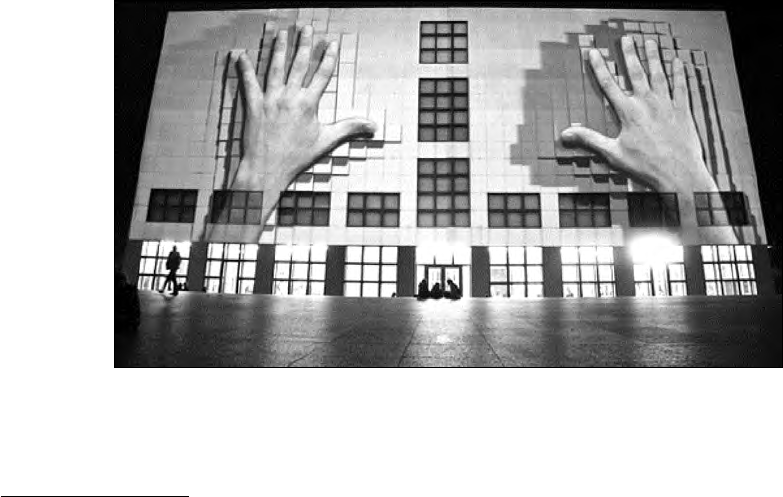
Their theory, named the Broken Window Theory and first published in 1982, argues that
crime is the inevitable result of disorder, and that if neglect is present in a place, whether it
is disrepair or thoughtless graffiti, people walking by will think no one cares about that place,
and the unfavorable damage is therefore acceptable.
Street Art and Gentrification
4
40
Thoughtful and attractive street art, however, has been suggested to have regenerative
effects on a neighborhood. In fact, the popular street artist Banksy, who has catapulted his
guerilla
5
street art pastime into a profitable career as an auctionable contemporary artist, has
come under criticism for his art contributing to the gentrification of neighborhoods.
Appropriate Media claims that:
45
“Banksy… sells his lazy polemics
6
to Hollywood movie stars for big
bucks… Graffiti artists are the performing spray-can monkeys for
gentrification. In collusion with property developers, they paint deprived
areas bright colours to indicate the latest funky inner city area ripe for
regeneration. Pushing out low income families in their wake, to be
50
replaced by middle class metrosexuals with their urban art collections.”
[Times Online] …
Video Projection
Digitally projecting a computer-manipulated image onto a surface via a light and
projection system.
4
gentrification — the process of renovation and revival of deteriorated urban neighborhoods that results in the
displacement of lower income residents by higher income residents
5
guerilla — combative
6
polemics — criticisms
Regents Exam in ELA — June ’18 [12]

Street Installation
Street installations are a growing trend within the ‘street art’ movement. Whereas
55
conventional street art and graffiti is done on surfaces or walls, ‘street installations’ use 3-D
objects and space to interfere with the urban environment. Like graffiti, it is non-permission
based and once the object or sculpture is installed it is left there by the artist. …
Yarn Bombing
Yarn Bombing is a type of street art that employs colourful displays of knitted or
crocheted cloth rather than paint or chalk. The practice is believed to have originated in the
60
U.S. with Texas knitters trying to find a creative way to use their leftover and unfinished
knitting projects, but has since spread worldwide. While other forms of graffiti may be
expressive, decorative, territorial, socio-political commentary, advertising or vandalism, yarn
bombing is almost exclusively about beautification and creativity.
—Erin Wooters Yip
excerpted from “What is Street Art? Vandalism, Graffiti or Public Art – Part I”
http://artradarjournal.com, January 21, 2010
Regents Exam in ELA — June ’18 [13] [OVER]

10
5
15
20
25
30
35
40
Text 2
Graffiti Vandals Cost Public Millions
There is a certain rhythm to Michael Parks’ job. He paints, they tag, he paints, they tag. …
It’s a silent tango between those who scrawl graffiti and those who are paid to remove it.
The dance pauses briefly when one side gives up. Maybe a tagger gets bored — or caught.
Maybe a painter moves on to something else.
For now, that won’t be Parks. He shows up as a “graffiti ranger” for Seattle Public Utilities
(SPU) every day, just as he has for the past six years, in a white uniform and orange vest. He
and a partner roam Seattle neighborhoods in a city-owned truck, their solvent cans, brushes
and paint drums clanging in the back.
They stop at stairwells, bridges, trash cans, postal boxes, retaining walls. Graffiti
disappears. And it all comes back the next week. …
In Seattle, rangers are only one faction. The parks department, Seattle’s Department of
T
ransportation, King County Metro Transit and Sound T
ransit all pay workers to erase the
mess. For years, Seattle police even had a “graffiti detective,” but he retired in 2007 and the
position never was filled.
The effort is expensive. Seattle Public Utilities spent about $1 million last year for graffiti
enforcement, removal, education and outreach, while King County Metro T
ransit spent
$734,000 last year to rid buses, tunnels, park and rides and bus shelters of graffiti.
Add it all up and, overall, city and county agencies are spending millions in tax dollars a
year trying to combat the ubiquitous
1
squiggles, tags, gang symbols and drawings that mar
public property.
Its persistence creates headaches for private-property owners required to get rid of it, and
anxiety from residents worried about neighborhood blight. …
No centralized front
It’s hard for officials to talk with any certainty about graffiti trends. Because so many city
agencies deal with it, no one keeps a centralized database of complaints.
And there are a lot.
Seattle Public Utilities has averaged about 7,300 a year since 2008, said Linda Jones,
manager of the graffiti-rangers team. Some are divvied up among the six rangers. The rest
are handed off to other city agencies, she said.
The rangers erased or painted out 445,000 square feet of graffiti in 2009. That’s almost
eight football fields.
Hate messages take first priority; those have to be gone in 24 hours. Everything else is
tackled within six to 10 days, Jones said. …
Certainly, graffiti seems to tattoo all urban landscapes. Look around Seattle and you’ll find
it everywhere: billboards, construction sites, businesses and homes.
Overhead highway signs and train cars hold particular appeal, evidence of the adrenaline
rush — and grudging respect of other taggers — that go along with the crime, officials say
.
In some cities, such as Los Angeles, these signs are wrapped with barbed wire to prevent
vandalism. But that’s not the case in W
ashington, said Jamie Holter
, spokeswoman for the
Washington state Department of Transportation.
To clean a freeway sign, workers have to shut down a lane at night, get in a truck and raise
a boom.
2
…
1
ubiquitous — found everywhere
2
boom — a maneuverable arm of a truck used to lift workers for aerial work
Regents Exam in ELA — June ’18 [14]

Last year, a 28-year-old Miami man made national news after he fell to his death while
tagging a sign on the Palmetto Expressway. In 1997, one prolific Seattle tagger severed a
foot while tagging a train in Golden Gardens. But that didn’t stop him. Records show he
45
pleaded guilty for tagging again in 1999 and 2000. …
Hard to catch …
Arrest numbers fluctuate wildly year to year. For instance, Seattle police made 234
graffiti-related arrests in 2008. That number fell to 41 last year.
“Usually [taggers] are on foot, so they can just drop the stuff and run,” police spokesman
Mark Jamieson said.
50
And property owners are left to clean it up.
Under the city’s Graffiti Nuisance Ordinance, if private businesses or homes get tagged
and owners don’t act promptly, SPU sends a letter asking them to remove it within 10 days.
Ignore the notice, and property owners could face fines of $100 per day with a maximum of
$5,000.
55
SPU sent 1,392 first-time warnings to property owners last year. About 75 percent
complied, Jones said. After a second warning, nearly all got rid of the graffiti, she said. …
—Sonia Krishnan
excerpted from “Graffiti V
andals Cost Public Millions”
www.seattletimes.com
, April 25, 2010
Regents Exam in ELA — June ’18 [15] [OVER]

Text 3
5
10
15
20
25
30
35
40
Is Urban Graffiti a Force for Good or Evil?
Ban it, legalise it, put it behind glass … no matter what city councils do, graffiti remains
the scapegoat for all manner of urban ills, from burglary on one extreme to gentrification on
the other. But it may have another effect on cities entirely.
In the spring of 2008, the T
ate Modern opened the world’s first major public museum
display of graffiti and street art, inviting six international artists to decorate its facade
1
with
enormous, eye-catching murals.
Meanwhile, just down the riverbank at Southwark crown court, eight members of
London’s well-known DPM crew
2
were tried for an estimated £1m
3
in graffiti-related
damages across the country, and sentenced to a total of 11 years in prison – the biggest
prosecution for graffiti that the UK [United Kingdom] has ever seen. …
Since its contemporary birth in 1960s Philadelphia, city leaders have tended to condemn
graffiti as mindless vandalism. Policing later began leaning towards the “broken window”
theory, which argues that if petty crime like graffiti is visibly ignored, suggesting general
neglect, it could inspire more serious offences. The UK spends £1bn
4
on graffiti removal each
year.
But as cities seek to “clean up”, could graffiti’s ephemeral
5
role within the urban
environment actually be good for cities?
For Ben Eine, a graffiti artist whose work was gifted to Barack Obama by David
Cameron,
6
graffiti leads not to drug deals and robberies, as the broken windows theory
suggests, but to something very different. “If they [councils] stopped painting over them,
they would get tagged and then they’d do silver stuff over it. And then eventually, people
would do nice paintings over it … The natural evolution of graffiti is that it will just turn out
looking nice,” he told the recent Graffiti Sessions academic conference. …
Embracing graffiti’s cultural value can do wonders for a city’s tourism industry, too. In
Bristol, the 2012 See No Evil festival saw 50,000 people flock to the streets; in Stavanger,
Norway, the city walls are transformed into a canvas for the highly successful annual NuArt
festival. Even without a dedicated event, for every painted wall in a city there is most likely
a tour to go with it. A three-hour graffiti walk around the streets of Shoreditch could set you
back £20, and in colourful Buenos Aires a tour of the decorated walls can cost $25 (£16).
Buenos Aires is a particularly fascinating example of a city where the walls talk, telling
tales of a turbulent past. Here, graffiti has been continuously harnessed as a tool of political
communication, resistance and activism by citizens caught up in a cycle of military
dictatorship, restored democracy and economic collapse. Although there are laws prohibiting
graffiti, the city has gained worldwide recognition for its urban art. Now a new bill proposes
to assign a registry of graffiti artists to designated spots in Buenos Aires, with the aim of
decreasing undesirable markings elsewhere.
A similar approach has been adopted in T
oronto, where a Graffiti Management Plan sees
that “graffiti vandalism” is removed by city staff, while “graffiti art and other street art that
adds vibrancy” may remain if commissioned by the building’s owner. T
oronto council has
even assigned an official panel of specialists to judge the value of graffiti, deciding whose
markings are artistically worthy to grace the city’s bricks. …
1
facade — front of a building
2
DPM crew — graffiti gang
3
£1m — one million British pounds
4
£1bn — one billion British pounds
5
ephemeral — short-lived
6
David Cameron — British Prime Minister 2010–2016
Regents Exam in ELA — June ’18 [16]

Legal or not, as graffiti seeps into the fabric of neighbourhoods, it becomes a natural fact
of everyday life in the city, a cultural practice appreciated and legitimised by young urban
dwellers. Simultaneously, it is harnessed by local authorities and property owners as a method
45
of cultural branding, to create the sort of “poor but sexy” neighbourhoods that work so well
for cities like Berlin. Active curation
7
of street art really got into full swing in pre-Olympic
London when the work of a local crew was scrubbed from the walls of the River Lea
Navigation to make way for street art by several international artists, specially commissioned
by the Olympic legacy’s public art body. …
50
From its roots as a means of visual communication for disenfranchised
8
youth to both
hide and be seen, graffiti has developed into a bona fide art form, a legitimate force for
economic, cultural and social good – and, as we continue to shift towards increasingly
sanitised urban environments, one of the few remaining ways we have to respond to our
surroundings in an expressive, public way. “Good” v “bad” graffiti might continue to be
55
disputed between fervid councillors,
9
but Eine says the public have moved on. “The whole
world is covered in graffiti. No one cares. It’s just part of urban noise.”
—Athlyn Cathcart-Keays
excerpted and adapted from “Is Urban Graffiti a Force for Good or Evil?”
www.theguardian.com, January 7, 2015
7
curation — to organize for presentation
8
disenfranchised — marginalized or powerless
9
fervid councillors — passionate community representatives
Regents Exam in ELA — June ’18 [17] [OVER]

5
10
15
20
25
30
35
40
Text 4
Art or Vandalism: Banksy, 5Pointz and the Fight for Artistic Expression
In 1974, Norman Mailer wrote, The Faith of Graffiti, one of the first literary works that
looked at the origins and importance of graffiti in modern urban culture. Mailer’s belief was
not widespread with many opponents looking at graffiti as no more than vandalism. The
battle between those two camps
1
has waged ever since, although the graffiti artists, (now
given the more politically correct name of street artist), have slowly begun to win the battle.
Artists like Banksy and Mr. Brainwash have actually made the public salivate with
anticipation as they await their next creative exploits. While often unsanctioned, street art
allows the artist to bypass the confines of the formal art world where only the elite can
participate. Communicating directly with the public allows street artists to present socially
relevant content while at the same time beautifying the bleak sprawl of urban decay.
Whether graffiti is art or crime has an implication in protecting the integrity of a street
artist’s work. If considered art, the creative works might be shielded under the Visual Arts
Rights Act (V
ARA). VARA protects the work of visual art, from intentional distortion,
mutilation or other modification. As a crime, these works can be washed away without further
consideration, as has been the fate of many.
“It’s a very frustrated feeling you get when the only people with good
photos of your work are the police department.”
—Banksy
Street artists across the country have been fighting back using the VARA argument.
5Pointz, an outdoor art exhibit space in Long Island City, New York, is considered to be the
world’
s premiere “graffiti Mecca.” Since 1993, with the property owner’s permission, artists
have been creating unique artistic works on numerous walls of a 200,000-square-foot factory.
5Pointz has now become a tourist attraction, with hundreds visiting each week. Now, the
building is supposed to be razed to make way for a luxury apartment complex. Sixteen artists
have sued to preserve the space citing VARA. They are currently seeking a temporary
injunction.
2
Los Angeles, often on the forefront of intellectual property issues, recently passed a new
murals ordinance making street art legal if you pay for a permit, get permission from the
location, and publicly post your intentions. Shepard Fairey, best known for his Obama Hope
poster and his Obey campaign, has teamed up with renowned graffiti artist, Risk to create a
major piece in Skid Row. Another work will be painted in the Arts District by culture-
jamming contemporary artist, Ron English.
Other artists thrive on the illegality of their work. Banksy recently hit New York City,
creating 17 works throughout various neighborhoods. Despite their aesthetic value, the
NYPD’s Vandal Squad want to question him in connection with the vandalism, and if they
catch him, he will be charged. The vandal squad is currently combing through hours of
surveillance footage looking for clues to Banksy’
s whereabouts. Mayor Bloomberg said that
any Banksy works on public property will be removed. …
So, while the battle rages on, it at least seems for the time being that street artists are
gaining public support and it may only be a matter of time before laws like the one in L.A.
are the norm.
—Steve Schlackman
excerpted from “Art or Vandalism: Banksy, 5Pointz and the Fight for Artistic Expression”
http://artlawjournal.com
, October 26, 2013
1
camps — groups
2
injunction — a judicial order that restrains a person from beginning or continuing an action that threatens the legal
rights of another
Regents Exam in ELA — June ’18 [18]
Part 3
Text-Analysis Response
Your Task: Closely read the text provided on pages 20 and 21 and write a well-developed, text-based response
of two to three paragraphs. In your response, identify a central idea in the text and analyze how the author’s use
of one writing strategy (literary element or literary technique or rhetorical device) develops this central idea.
Use strong and thorough evidence from the text to support your analysis. Do not simply summarize the text. You
may use the margins to take notes as you read and scrap paper to plan your response. Write your response in
the spaces provided on pages 7 through 9 of your essay booklet.
Guidelines:
Be sure to:
• Identify a central idea in the text
• Analyze how the author’s use of one
writing strategy (literary element or literary technique or rhetorical
device) develops this central idea. Examples include: characterization, conflict, denotation/connotation,
metaphor, simile, irony
, language use, point-of-view, setting, structure, symbolism, theme, tone, etc.
• Use strong and thorough evidence from the text to support your analysis
• Organize your ideas in a cohesive and coherent manner
• Maintain a formal style of writing
• Follow the conventions of standard written English
Regents Exam in ELA — June ’18 [19] [OVER]

5
10
15
20
25
30
35
40
Text
He always feels hot, I always feel cold. In the summer when it really is hot he does
nothing but complain about how hot he feels. He is irritated if he sees me put a jumper
1
on
in the evening.
He speaks several languages well; I do not speak any well. He manages — in his own
way — to speak even the languages that he doesn’t know.
He has an excellent sense of direction, I have none at all. After one day in a foreign city
he can move about in it as thoughtlessly as a butterfly. I get lost in my own city; I have to
ask directions so that I can get back home again. He hates asking directions; when we go by
car to a town we don’t know he doesn’
t want to ask directions and tells me to look at the
map. I don’t know how to read maps and I get confused by all the little red circles and he
loses his temper.
He loves the theatre, painting, music, especially music. I do not understand music at all,
painting doesn’t mean much to me and I get bored at the theatre. I love and understand
one thing in the world and that is poetry.
He loves museums, and I will go if I am forced to but with an unpleasant sense of effort
and duty. He loves libraries and I hate them.
He loves travelling, unfamiliar foreign cities, restaurants. I would like to stay at home
all the time and never move. …
He tells me I have no curiosity, but this is not true. I am curious about a few
, a very few,
things. And when I have got to know them I retain scattered impressions of them, or the
cadence
2
of phrase, or a word. But my world, in which these completely unrelated (unless
in some secret fashion unbeknown to me) impressions and cadences rise to the surface, is
a sad, barren place. His world, on the other hand, is green and populous and richly
cultivated; it is a fertile, well-watered countryside in which woods, meadows, orchards and
villages flourish.
Everything I do is done laboriously, with great difficulty and uncertainty. I am very lazy,
and if I want to finish anything it is absolutely essential that I spend hours stretched out on
the sofa. He is never idle, and is always doing something; when he goes to lie down in the
afternoons he takes proofs to correct or a book full of notes; he wants us to go to the cinema,
then to a reception, then to the theatre — all on the same day. In one day he succeeds in
doing, and in making me do, a mass of different things, and in meeting extremely diverse
kinds of people. If I am alone and try to act as he does I get nothing at all done, because I
get stuck all afternoon somewhere I had meant to stay for half an hour, or because I get lost
and cannot find the right street, or because the most boring person and the one I least
wanted to meet drags me off to the place I least wanted to go to. …
I don’
t know how to dance and he does.
I don’t know how to type and he does.
I don’t know how to drive. If I suggest that I should get a licence too he disagrees. He says
I would never manage it. I think he likes me to be dependent on him for some things. …
And so — more than ever — I feel I do everything inadequately or mistakenly. But if I
once find out that he has made a mistake I tell him so over and over again until he is
exasperated. I can be very annoying at times. …
When he was a young man he was slim, handsome and finely built; he did not have
a beard but long, soft moustaches instead, and he looked like the [British] actor Robert
1
jumper — sweater
2
cadence — rhythm
Regents Exam in ELA — June ’18 [20]

45
Donat. He was like that about twenty years ago when I first knew him, and I remember that
he used to wear an elegant kind of Scottish flannel shirt. I remember that one evening he
walked me back to the pensione
3
where I was living; we walked together along the Via
Nazionale.
4
I already felt that I was very old and had been through a great deal and had
made many mistakes, and he seemed a boy to me, light years away from me. I don’t
50
remember what we talked about on that evening walking along the Via Nazionale
; nothing
important, I suppose, and the idea that we would become husband and wife was light years
away from me. Then we lost sight of each other, and when we met again he no longer looked
like Robert Donat, but more like Balzac [French writer]. When we met again he still wore
his Scottish shirts but on him now they looked like garments for a polar expedition; now he
55
had his beard and on his head he wore his ridiculous crumpled woollen hat; everything
about him put you in mind of an imminent
5
departure for the North Pole. Because,
although he always feels hot, he has the habit of dressing as if he were surrounded by snow,
ice and polar bears; or he dresses like a Brazilian coffee-planter, but he always dresses
differently from everyone else.
60
If I remind him of that walk along the Via Nazionale
he says he remembers it, but
I know he is lying and that he remembers nothing; and I sometimes ask myself if it was us,
these two people, almost twenty years ago on the Via Nazionale; two people who conversed
so politely, so urbanely,
6
as the sun was setting; who chatted a little about everything
perhaps and about nothing; two friends talking, two young intellectuals out for a walk; so
65
young, so educated, so uninvolved, so ready to judge one another with kind impartiality; so
ready to say goodbye to one another for ever, as the sun set, at the corner of the street.
—Natalia Ginzburg
excerpted and adapted from “He and I”
The Little Virtues, 1962
Arcade Publishing
3
pensione — boarding house
4
Via Nazionale — a grand boulevard
5
imminent — upcoming or about to occur
6
urbanely — elegantly
Regents Exam in ELA — June ’18 [21]
Regents Exam in ELA — June ’18 [22]
Regents Exam in ELA — June ’18 [23]
REGENTS IN ELA
Printed on Recycled Paper
REGENTS IN ELA

FOR TEACHERS ONLY
The University of the State of New York
REGENTS HIGH SCHOOL EXAMINATION
ENGLISH LANGUAGE ARTS
Tuesday, June 12, 2018— 9:15 a.m. to 12:15 p.m., only
SCORING KEY AND RATING GUIDE
Mechanics of Rating
Updated information regarding the rating of this examination may be posted on the
New York State Education Department’s web site during the rating period. Check this web site
at http://www.p12.nysed.gov/assessment/
and select the link “Scoring Information” for any recently posted
information regarding this examination. This site should be checked before the rating process for this
examination begins and several times throughout the Regents Examination period.
The following procedures are to be used for rating papers in the Regents Examination in English
Language Arts. More detailed directions for the organization of the rating process and procedures for
rating the examination are included in the Information Booklet for Scoring the Regents Examination in
English Language Arts.
Scoring the Multiple-Choice Questions
For this exam all schools must use uniform scannable answer sheets provided by the regional
scanning center or large-city scanning center. The scoring key for this exam is provided below. If the
student’s responses for the multiple-choice questions are being hand scored prior to being
scanned, the scorer must be careful not to make any marks on the answer sheet except to record
the scores in the designated score boxes. Marks elsewhere on the answer sheet will interfere
with the accuracy of the scanning.
Before scannable answer sheets are machine scored, several samples must be both machine and
manually scored to ensure the accuracy of the machine-scoring process. All discrepancies must be
resolved before student answer sheets are machine scored. When machine scoring is completed, a sample of
the scored answer sheets must be scored manually to verify the accuracy of the machine-scoring process.
The University of the State of New York • THE STATE EDUCATION DEPARTMENT • Albany, New York 12234
1 . . . . . . 2 . . . . . . 6 . . . . . . 1 . . . . . . 10 . . . . . . 4 . . . . . . 15 . . . . . . 3 . . . . . . 20 . . . . . . 2 . . . . . .
2 . . . . . . 2 . . . . . . 7 . . . . . . 3 . . . . . . 11 . . . . . . 3 . . . . . . 16 . . . . . . 1 . . . . . . 21 . . . . . . 1 . . . . . .
3 . . . . . . 4 . . . . . . 8 . . . . . . 3 . . . . . . 12 . . . . . . 3 . . . . . . 17 . . . . . . 2 . . . . . . 22 . . . . . . 1 . . . . . .
4 . . . . . . 1 . . . . . . 9 . . . . . . 4 . . . . . . 13 . . . . . . 4 . . . . . . 18 . . . . . . 4 . . . . . . 23 . . . . . . 4 . . . . . .
5 . . . . . . 2 . . . . . . 14 . . . . . . 2 . . . . . . 19 . . . . . . 3 . . . . . . 24 . . . . . . 1 . . . . . .
Correct Answers
Part 1
ELA

Regents Exam in ELA Rating Guide — June ’18 [2]
ENGLISH LANGUAGE ARTS
Rating of Essay and Response Questions
(1) In training raters to score student essays and responses for each part of the examination, follow the
procedures outlined below:
Introduction to the Tasks
• Raters read the task and summarize it.
• Raters read the passages or passage and plan a response to the task.
• Raters share response plans and summarize expectations for student responses.
Introduction to the Rubric and Anchor Papers
• Trainer reviews rubric with reference to the task.
• Trainer reviews procedures for assigning holistic scores (i.e., by matching evidence from the response
to the language of the rubric and by weighing all qualities equally).
• Trainer leads review of each anchor paper and commentary. (Note: Anchor papers are ordered from
high to low within each score level.)
Practice Scoring Individually
• Raters score a set of five practice papers individually. Raters should score the five papers independently
without looking at the scores provided after the five papers.
• Trainer records scores and leads discussion until raters feel comfortable enough to move on to actual
scoring. (Practice papers for Parts 2 and 3 only contain scores, not commentaries.)
(2) When actual rating begins, each rater should record his or her individual rating for a student’s essay and
response on the rating sheets provided in the Information Booklet, not directly on the student’s essay or
response or answer sheet. Do not correct the student’s work by making insertions or changes of any kind.
(3) Both the 6-credit essay and the 4-credit response must be rated by at least two raters; a third rater will be
necessary to resolve scores that differ by more than one point. Teachers may not score their own
students’ answer papers. The scoring coordinator will be responsible for coordinating the movement of
papers, calculating a final score for each student’s essay or response, and recording that information on the
student’s answer paper.
Schools are not permitted to rescore any of the open-ended questions on any Regents Exam
after each question has been rated the required number of times as specified in the rating guide,
regardless of the final exam score. Schools are required to ensure that the raw scores have been
added correctly and that the resulting scale score has been determined accurately.

Regents Exam in ELA Rating Guide — June ’18 [3]
Criteria
6
Essays at this Level:
5
Essays at this Level:
4
Essays at this Level:
3
Essays at this Level:
2
Essays at this Level:
1
Essays at this Level:
Content and Analysis: the
extent to which the essay
conveys complex ideas and
information clearly and
accurately in order to
support claims in an
analysis of the texts
introduce a precise and insightful
claim, as directed by the task
-demonstrate in-depth and
insightful analysis of the texts, as
necessary to support the claim
and to distinguish the claim from
alternate or opposing claims
-introduce a precise and
thoughtful claim, as directed by
the task
-demonstrate thorough analysis of
the texts, as necessary to
support the claim and to
distinguish the claim from
alternate or opposing claims
-introduce a precise claim, as
directed by the task
-demonstrate appropriate and
accurate analysis of the texts, as
necessary to support the claim
and to distinguish the claim from
alternate or opposing claims
-introduce a reasonable claim, as
directed by the task
-demonstrate some analysis of
the texts, but insufficiently
distinguish the claim from
alternate or opposing claims
-introduce a claim
-demonstrate confused or
unclear analysis of the texts,
failing to distinguish the claim
from alternate or opposing
claims
do not introduce a claim
-do not demonstrate
analysis of the texts
Command of Evidence: the
extent to which the essay
presents evidence from the
provided texts to support
analysis
-present ideas fully and
thoughtfully, making highly
effective use of a wide range of
specific and relevant evidence to
support analysis
-demonstrate proper citation of
sources to avoid plagiarism when
dealing with direct quotes and
paraphrased material
-present ideas clearly and
accurately, making effective use
of specific and relevant evidence
to support analysis
-demonstrate proper citation of
sources to avoid plagiarism when
dealing with direct quotes and
paraphrased material
-present ideas sufficiently,
making adequate use of specific
and relevant evidence to support
analysis
-demonstrate proper citation of
sources to avoid plagiarism when
dealing with direct quotes and
paraphrased material
-present ideas briefly, making use
of some specific and relevant
evidence to support analysis
-demonstrate inconsistent citation
of sources to avoid plagiarism
when dealing with direct quotes
and paraphrased material
-present ideas inconsistently
and/or inaccurately, in an
attempt to support analysis,
making use of some evidence
that may be irrelevant
-demonstrate little use of
citations to avoid plagiarism
when dealing with direct quotes
and paraphrased material
-present little or no
evidence from the texts
-do not make use of
citations
Coherence, Organization,
and Style: the extent to
which the essay logically
organizes complex ideas,
concepts, and information
using formal style and
precise language
-exhibit skillful organization of
ideas and information to create a
cohesive and coherent essay
-establish and maintain a formal
style, using sophisticated
language and structure
-exhibit logical organization of
ideas and information to create a
cohesive and coherent essay
-establish and maintain a formal
style, using fluent and precise
language and sound structure
-exhibit acceptable organization
of ideas and information to create
a coherent essay
-establish and maintain a formal
style, using precise and
appropriate language and
structure
-exhibit some organization of
ideas and information to create a
mostly coherent essay
-establish but fail to maintain a
formal style, using primarily
basic language and structure
-exhibit inconsistent
organization of ideas and
information, failing to create a
coherent essay
-lack a formal style, using
some language that is
inappropriate or imprecise
-exhibit little organization
of ideas and information
-are minimal, making
assessment unreliable
-use language that is
predominantly
incoherent, inappropriate,
or copied directly from
the task or texts
Control of Conventions:
the extent to which the essay
demonstrates command of
conventions of standard
English grammar, usage,
capitalization, punctuation,
and spelling
-demonstrate control of
conventions with essentially no
errors, even with sophisticated
language
-demonstrate control of
conventions, exhibiting
occasional errors only when using
sophisticated language
-demonstrate partial control of
conventions, exhibiting occasional
errors that do not hinder
comprehension
-demonstrate emerging control
of conventions, exhibiting
occasional errors that
hinder comprehension
-demonstrate a lack of control
of conventions, exhibiting
frequent errors that make
comprehension difficult
-are minimal, making
assessment of
conventions unreliable
• An essay that addresses fewer texts than required by the task can be scored no higher than a 3.
• An essay that is a personal response and makes little or no reference to the task or texts can be scored no higher than a 1.
• An essay that is totally copied from the task and/or texts with no original student writing must be scored a 0.
• An essay that is totally unrelated to the task, illegible, incoherent, blank, or unrecognizable as English must be scored a 0.
THE STATE EDUCATION DEPARTMENT / THE UNIVERSITY OF THE STATE OF NEW YORK / ALBANY, NY 12234
New York State Regents Examination in English Language Arts
Part 2 Rubric
Writing From Sources: Argument
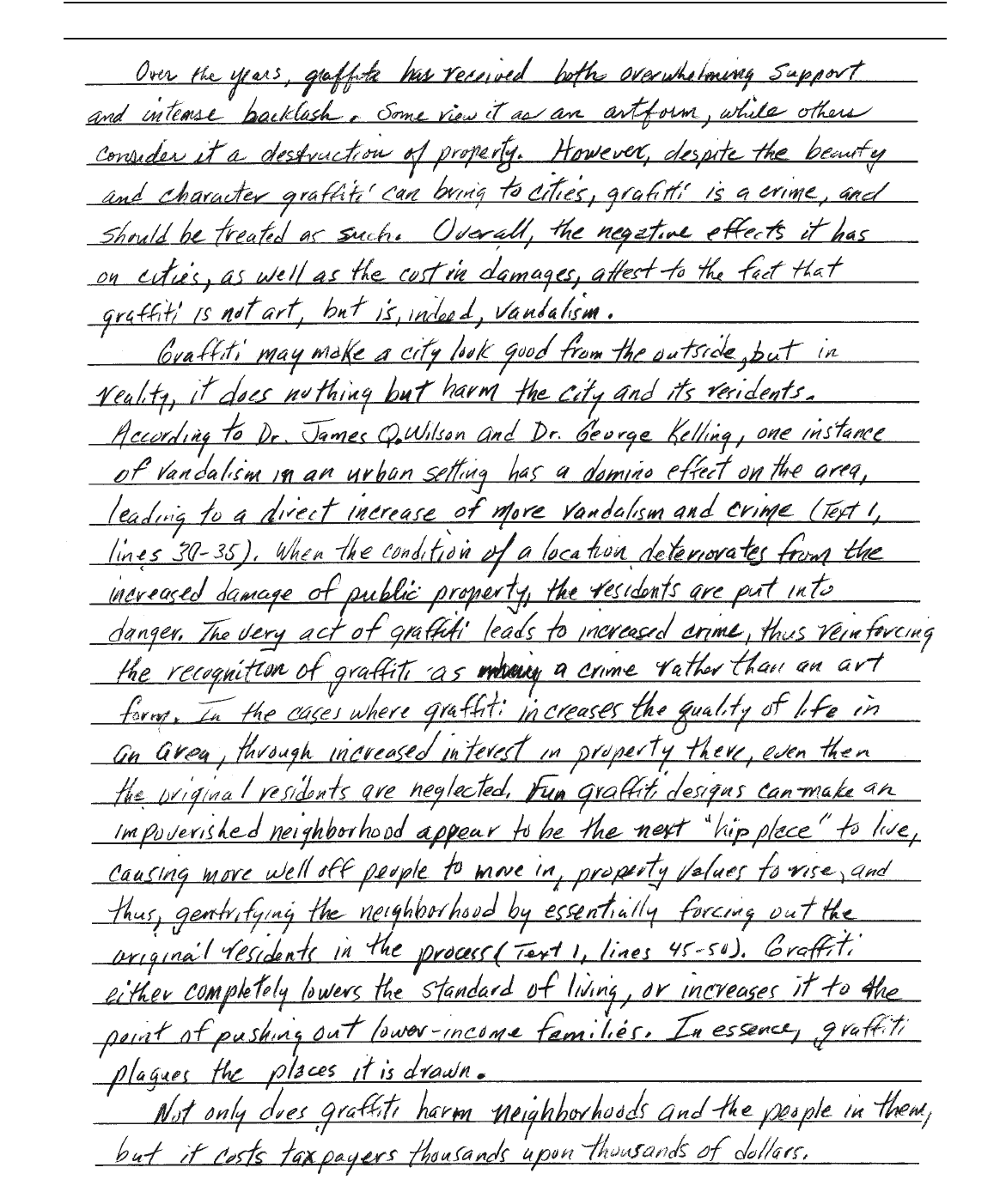
Regents Exam in ELA Rating Guide — June ’18 [4]
Anchor Paper – Part 2 – Level 6 – A
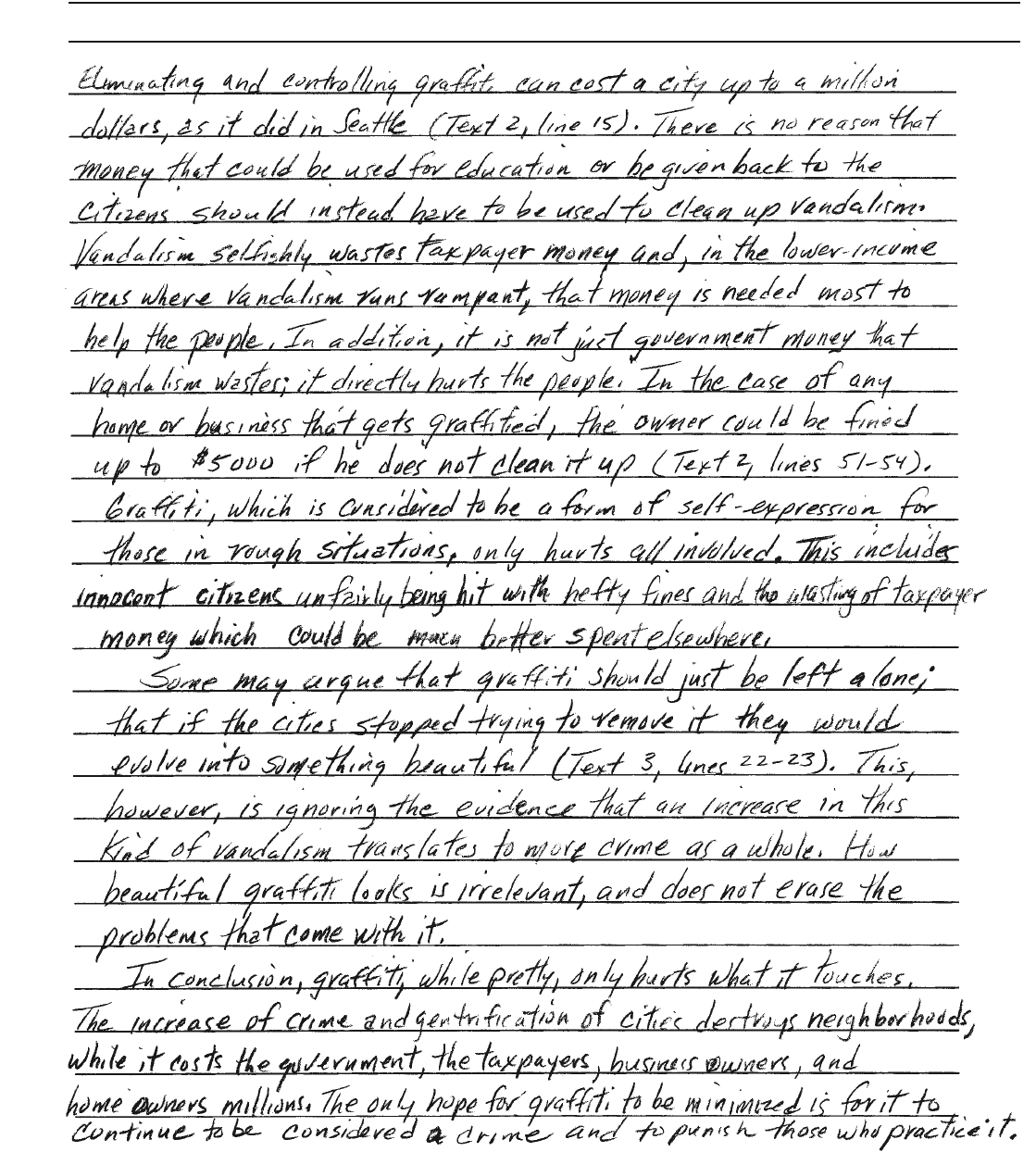
Regents Exam in ELA Rating Guide — June ’18 [5]
Anchor Paper – Part 2 – Level 6 – A

Regents Exam in ELA Rating Guide — June ’18 [6]
Anchor Level 6–A
The essay introduces a precise and insightful claim, as directed by the task (Overall, the negative effects it has on cities, as well as the
cost in damages, attest to the fact that graffiti is not art, but is, indeed, vandalism). The essay demonstrates in-depth and insightful
analysis of the texts, as necessary to support the claim (The very act of graffiti leads to increased crime, thus reinforcing the
recognition of graffiti as a crime rather than an art form and Vandalism selfishly wastes taxpayer money and, in the lower-income
areas where vandalism runs rampant, that money is needed most to help the people) and to distinguish the claim from alternate or
opposing claims (Some may argue that graffiti should just be left alone; that if the cities stopped trying to remove it they would evolve
into something beautiful). The essay presents ideas fully and thoughtfully, making highly effective use of a wide range of specific and
relevant evidence to support analysis (Fun graffiti designs can make an impoverished neighborhood appear to be the next “hip place”
to live, causing more well off people to move in, property values to rise, and thus, gentrifying the neighborhood by essentially forcing
out the original residents in the process and In addition, it is not just government money that vandalism wastes; it directly hurts the
people. In the case of any home or business that gets graffitied, the owner could be fined up to $5000 if he does not clean it up). The
essay demonstrates proper citation of sources to avoid plagiarism when dealing with direct quotes and paraphrased material [(Text 1,
lines 45-50) and (Text 3, lines 22-23)]. The essay exhibits skillful organization of ideas and information to create a cohesive and
coherent essay with an opening paragraph that states the claim and references the counterclaim, three body paragraphs that discuss the
harmful effects of graffiti (Graffiti either completely lowers the standard of living, or increases it to the point of pushing out lower-
income families and controlling graffiti can cost a city up to a million dollars), and a summative conclusion (The only hope for graffiti
to be minimized is for it to continue to be considered a crime and to punish those who practice it). The essay establishes and maintains
a formal style, using sophisticated language (Over the years, graffiti has received both overwhelming support and intense backlash)
and structure (Not only does graffiti harm neighborhoods and the people in them, but it costs taxpayers thousands upon thousands of
dollars). The essay demonstrates control of conventions with essentially no errors, even with sophisticated language.
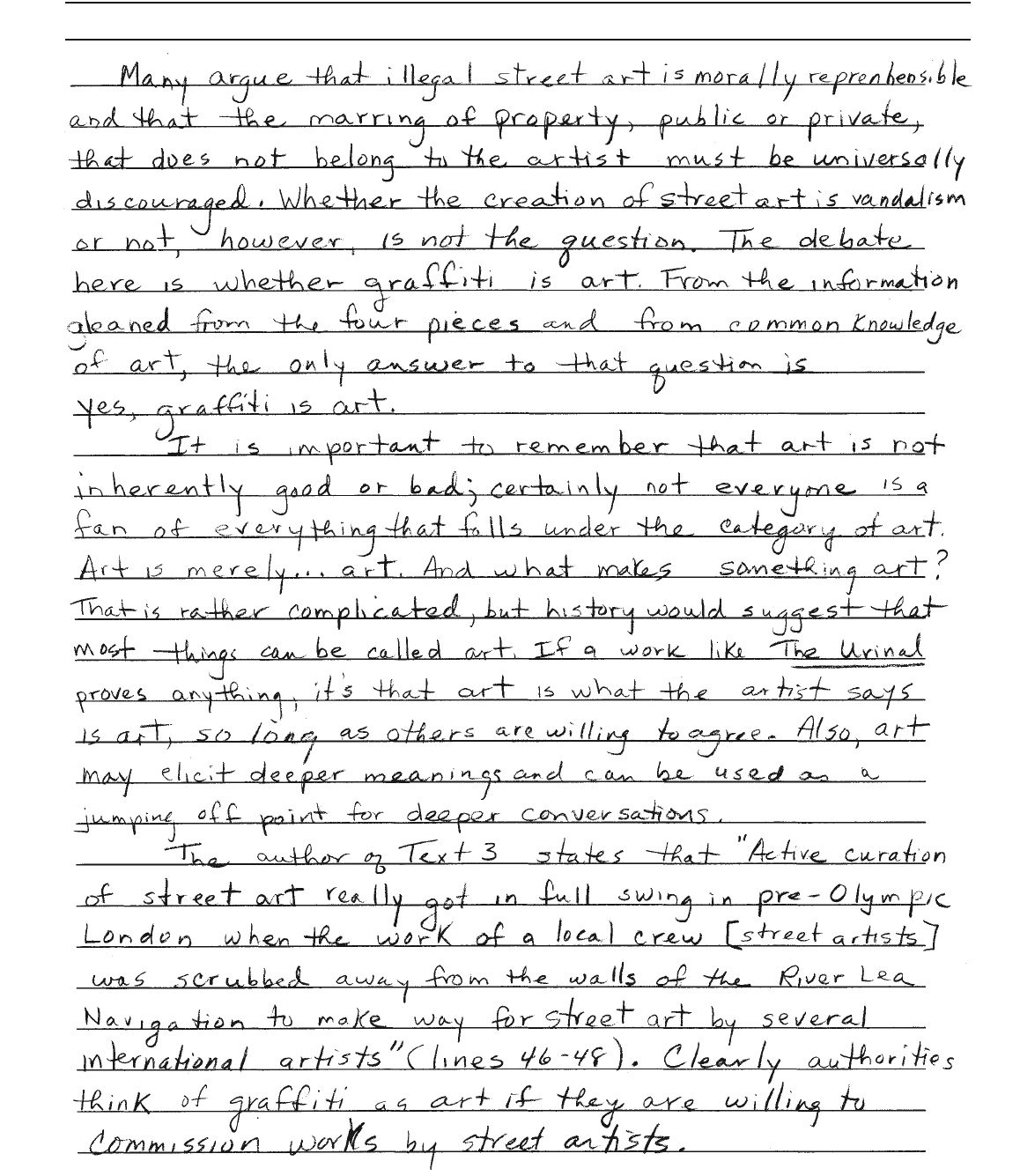
Regents Exam in ELA Rating Guide — June ’18 [7]
Anchor Paper – Part 2 – Level 6 – B
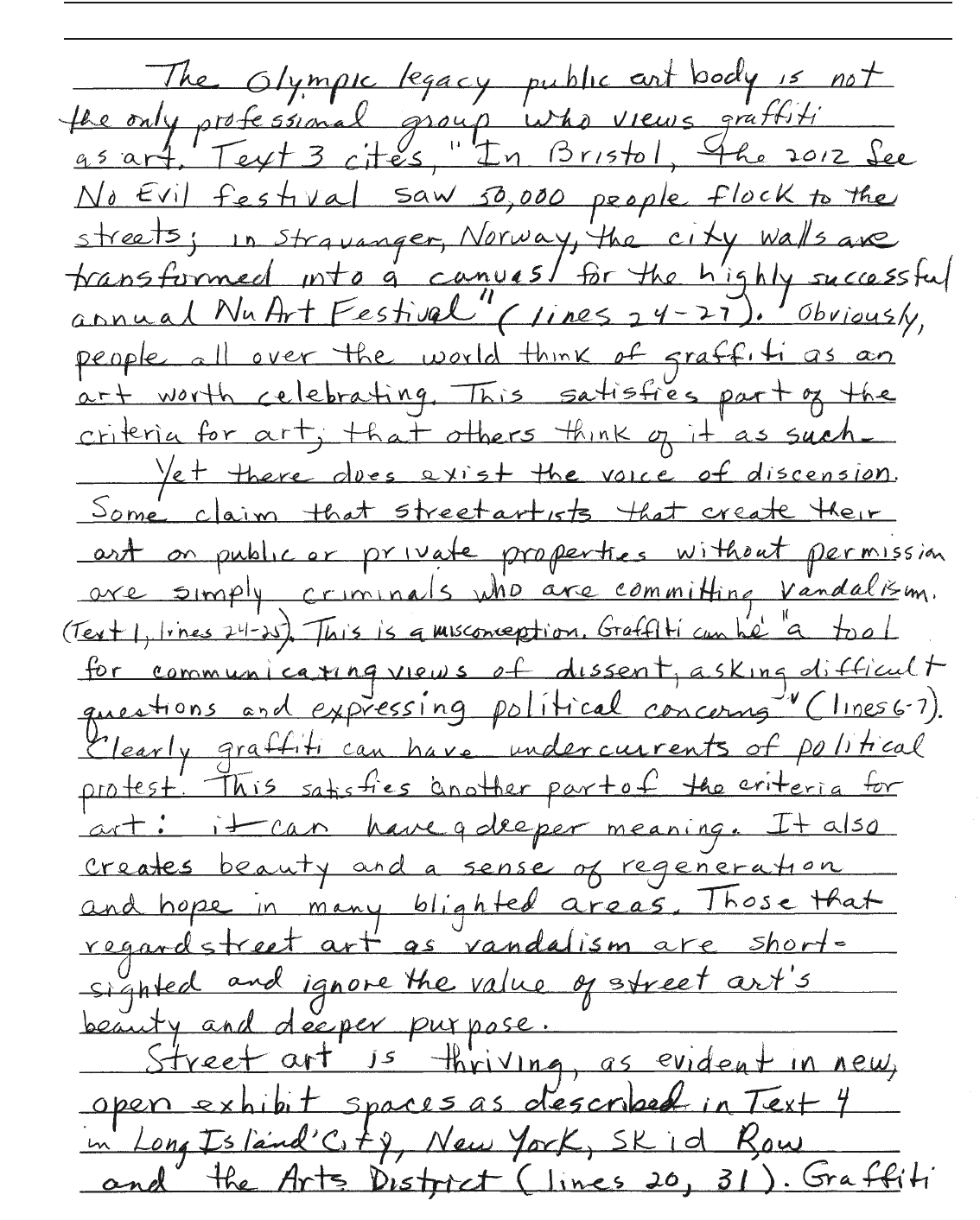
Regents Exam in ELA Rating Guide — June ’18 [8]
Anchor Paper – Part 2 – Level 6 – B

Regents Exam in ELA Rating Guide — June ’18 [9]
Anchor Paper – Part 2 – Level 6 – B
Anchor Level 6–B
The essay introduces a precise and insightful claim, as directed by the task (The debate here is whether graffiti is art. From the
information gleaned from the four pieces and from common knowledge of art, the only answer to that question is yes, graffiti is art).
The essay demonstrates in-depth and insightful analysis of the texts, as necessary to support the claim (Clearly authorities think of
graffiti as art if they are willing to commission works by street artists) and to distinguish the claim from alternate or opposing claims
(Some claim that street artists that create their art on public or private properties without permission are simply criminals who are
committing vandalism and Those that regard street art as vandalism are short-sighted and ignore the value of street art’s beauty and
deeper purpose). The essay presents ideas fully and thoughtfully, making highly effective use of a wide range of specific and relevant
evidence to support analysis (Graffiti can be “a tool for communicating views of dissent, asking difficult questions and expressing
political concerns” … Clearly graffiti can have undercurrents of political protest and Street art is thriving, as evident in new, open
exhibit spaces as described in Text 4 … Graffiti has gained acceptance as an art form in places like Buenos Aires, Toronto, and
Berlin). The essay demonstrates proper citation of sources to avoid plagiarism when dealing with direct quotes and paraphrased
material [(Text 1, lines 24-25) and The author of Text 3 states … (lines 46-48)]. The essay exhibits skillful organization of ideas and
information to create a cohesive and coherent essay with an opening paragraph that clearly states the claim and references the
counterclaim, a second paragraph that defines art, followed by four paragraphs that exemplify how people around the world are
embracing graffiti as art while refuting the voice of discension, ending with a summative conclusion (Quite simply, graffiti is art and
Graffiti is undeniably an authentic form of artistic expression). The essay establishes and maintains a formal style, using sophisticated
language (Many argue that illegal street art is morally reprehensible and that … the artist must be universally discouraged) and
structure (If a work like The Urinal
proves anything, it’s that art is what the artist says is art, so long as others are willing to agree and
It also creates beauty and a sense of regeneration and hope in many blighted areas). The essay demonstrates control of conventions,
exhibiting occasional errors (Clearly authorities, discension, fullfills, street artists brings) only when using sophisticated language.

Regents Exam in ELA Rating Guide — June ’18 [10]
Anchor Paper – Part 2 – Level 5 – A

Regents Exam in ELA Rating Guide — June ’18 [11]
Anchor Paper – Part 2 – Level 5 – A
Regents Exam in ELA Rating Guide — June ’18 [12]
Anchor Level 5–A
The essay introduces a precise and thoughtful claim, as directed by the task (many have jumped to the defense of graffiti artists by
passing legislation and using the softer label “street artists.” Nevertheless, graffiti is still nothing more than brightly-colored
vandalism). The essay demonstrates thorough analysis of the texts, as necessary to support the claim (Graffiti artists who don’t bother
to get permission from building owners are just creating a taxpayer and property-owner burden) and to distinguish the claim from
alternate or opposing claims (Legislation has come out … but it is misguided and Such legislation will only reinforce graffiti artists’
notion that they have rights to vandalize their cities. In the end … property rights must always come first). The essay presents ideas
clearly and accurately, making effective use of specific and relevant evidence to support analysis (Seattle spent $1 million getting rid of
graffiti on public buildings and vehicles, catching and punishing the perpetrators, and attempting to prevent future crimes and The
Visual Arts Rights Act protects public art … The act is being used to protest the renovation of a building). The essay demonstrates
proper citation of sources to avoid plagiarism when dealing with direct quotes and paraphrased material [(Text 1, line 18) and (Text 4,
lines 20-26)]. The essay exhibits logical organization of ideas and information, first introducing the idea that graffiti has been a
problem for decades and declaring that it is vandalism, followed by two paragraphs of support focusing on both its selfish and criminal
nature, one paragraph that exemplifies and dismisses the counterclaim, and concluding with a brief summation to create a cohesive and
coherent essay. The essay establishes and maintains a formal style, using fluent and precise language and sound structure (This does
not encompass the burden put on private property owners, who have to remove their unwanted graffiti under risk of fines and This can
then escalate). The essay demonstrates control of conventions with essentially no errors, other than one misplaced modifier and one
instance of lack of agreement (owner … they … their), even when using sophisticated language.
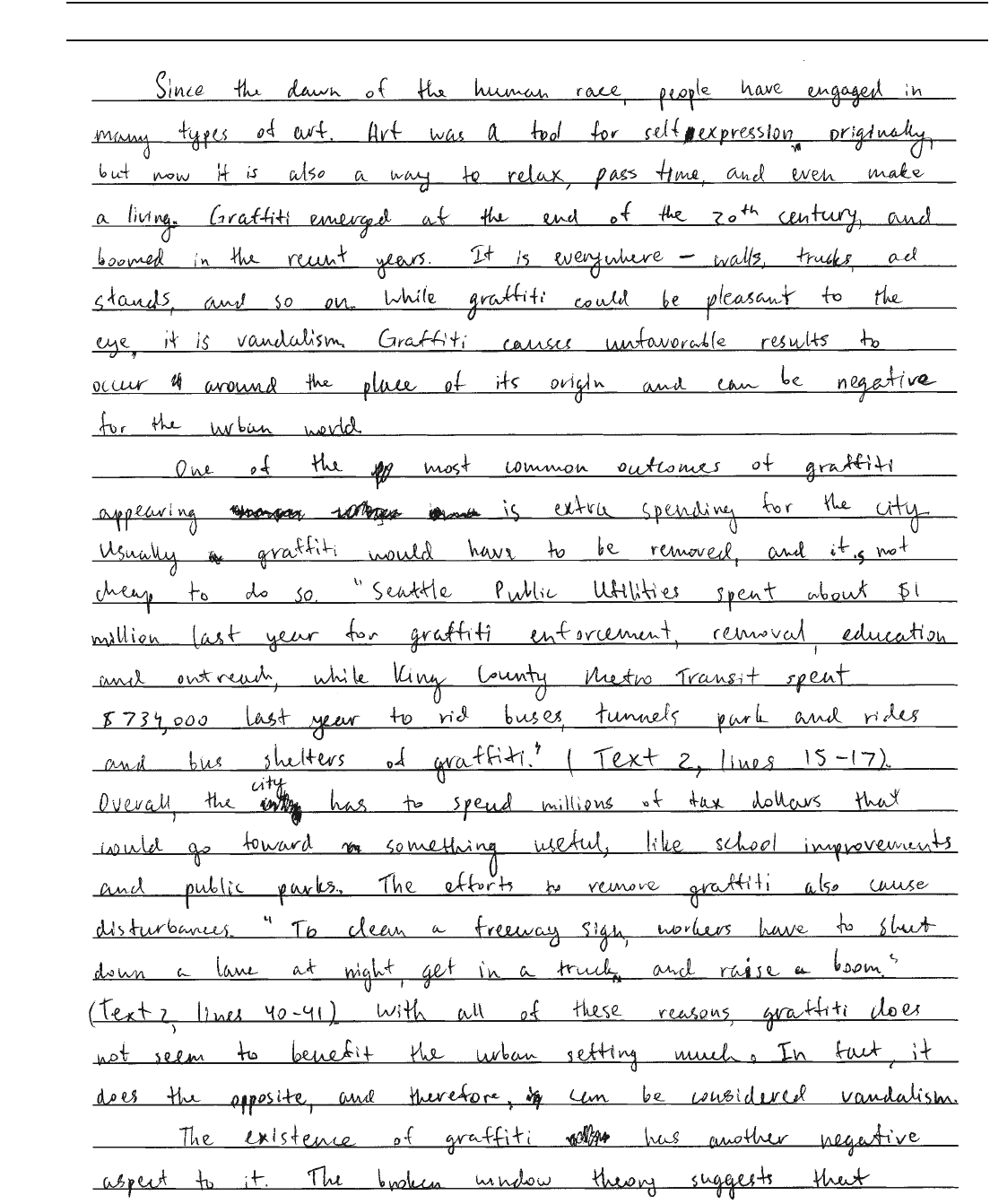
Regents Exam in ELA Rating Guide — June ’18 [13]
Anchor Paper – Part 2 – Level 5 – B

Regents Exam in ELA Rating Guide — June ’18 [14]
Anchor Paper – Part 2 – Level 5 – B
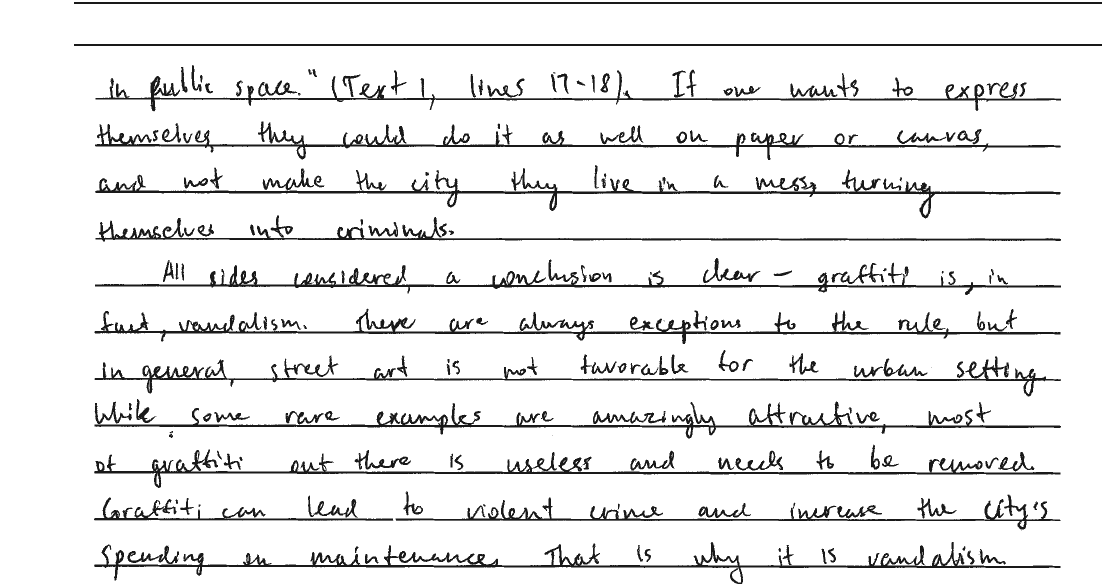
Regents Exam in ELA Rating Guide — June ’18 [15]
Anchor Paper – Part 2 – Level 5 – B
Anchor Level 5–B
The essay introduces a precise and thoughtful claim, as directed by the task (While graffiti could be pleasant to the eye, it is vandalism.
Graffiti causes unfavorable results to occur around the place of its origin and can be negative for the urban world). The essay
demonstrates thorough analysis of the texts, as necessary to support the claim (The broken window theory suggests that graffiti causes
other crimes to occur, setting off a chain reaction and This is why graffiti is vandalism – it causes unrest in the city and limits what it
can do for its people) and to distinguish the claim from alternate or opposing claims (There is, however, a positive end of the spectrum
and If one wants to express themselves, they could do it as well on paper or canvas, and not make the city they live in a mess). The
essay presents ideas clearly and accurately, making effective use of specific and relevant evidence to support analysis (The efforts to
remove graffiti also cause disturbances. “To clean a freeway sign, workers have to shut down a lane at night … and raise a boom” and
with the purchase of a permit, graffiti becomes street art and is a tourist attraction. “Buenos Aires is a particularly fascinating
example … the city has gained worldwide recognition for its urban art”). The essay demonstrates proper citation of sources to avoid
plagiarism when dealing with direct quotes and paraphrased material [(Text 2, lines 15-17) and (Text 1, lines 30-35)]. The essay
exhibits logical organization of ideas and information to create a cohesive and coherent essay with an introduction that presents the
issue and makes the claim that graffiti is vandalism, followed by two body paragraphs that discuss the common outcomes and negative
aspect stemming from acts of graffiti, a third body paragraph that addresses the counterclaim, and a conclusion that reiterates the claim
that graffiti is, in fact, vandalism. The essay establishes and maintains a formal style, using fluent and precise language and sound
structure (Since the dawn of the human race, people have engaged in many types of art and In fact, it does the opposite, and therefore,
can be considered vandalism). The essay demonstrates control of conventions, exhibiting occasional errors (likelyhood; rates, a lot;
one … themselves, they) only when using sophisticated language.
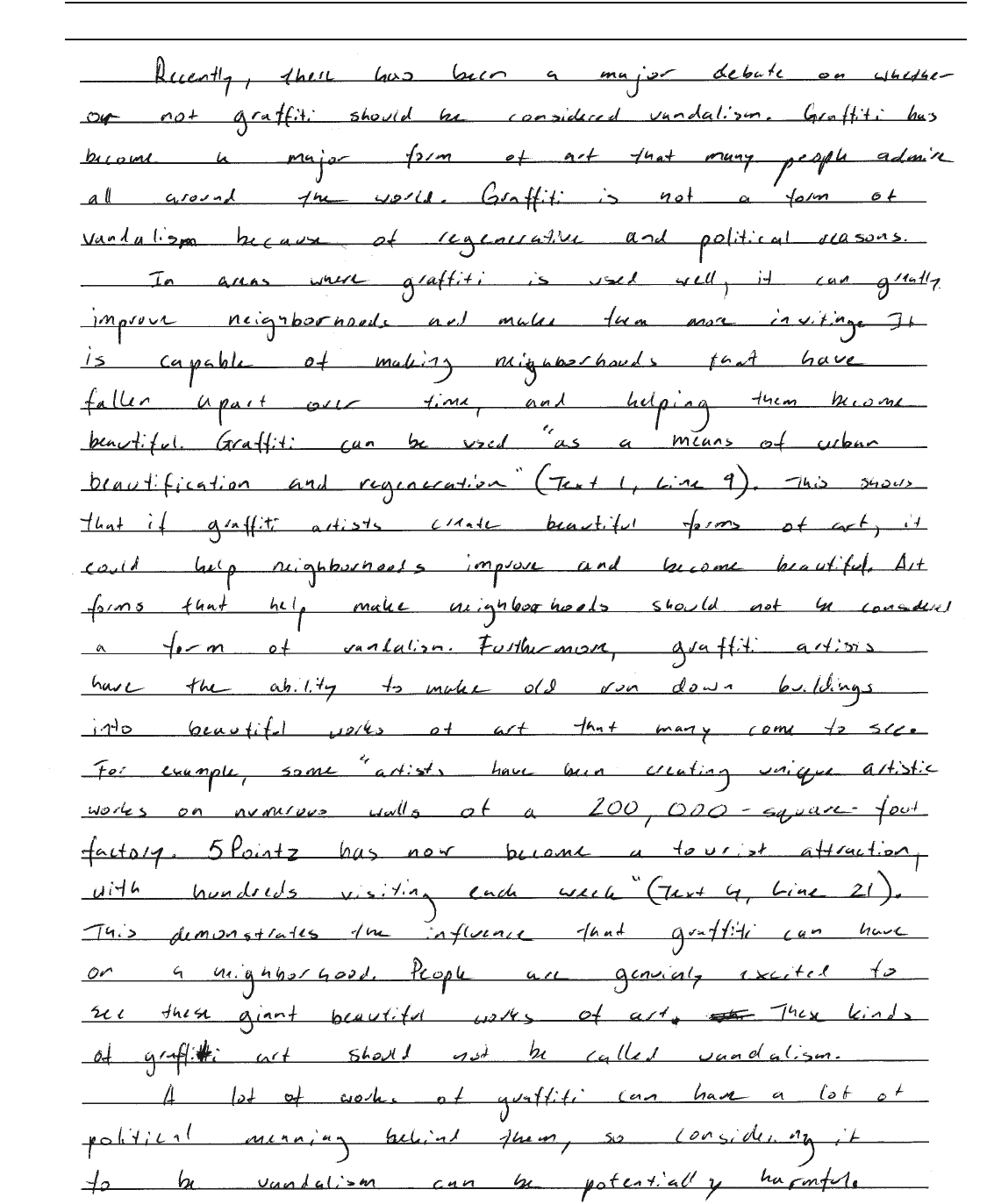
Regents Exam in ELA Rating Guide — June ’18 [16]
Anchor Paper – Part 2 – Level 5 – C
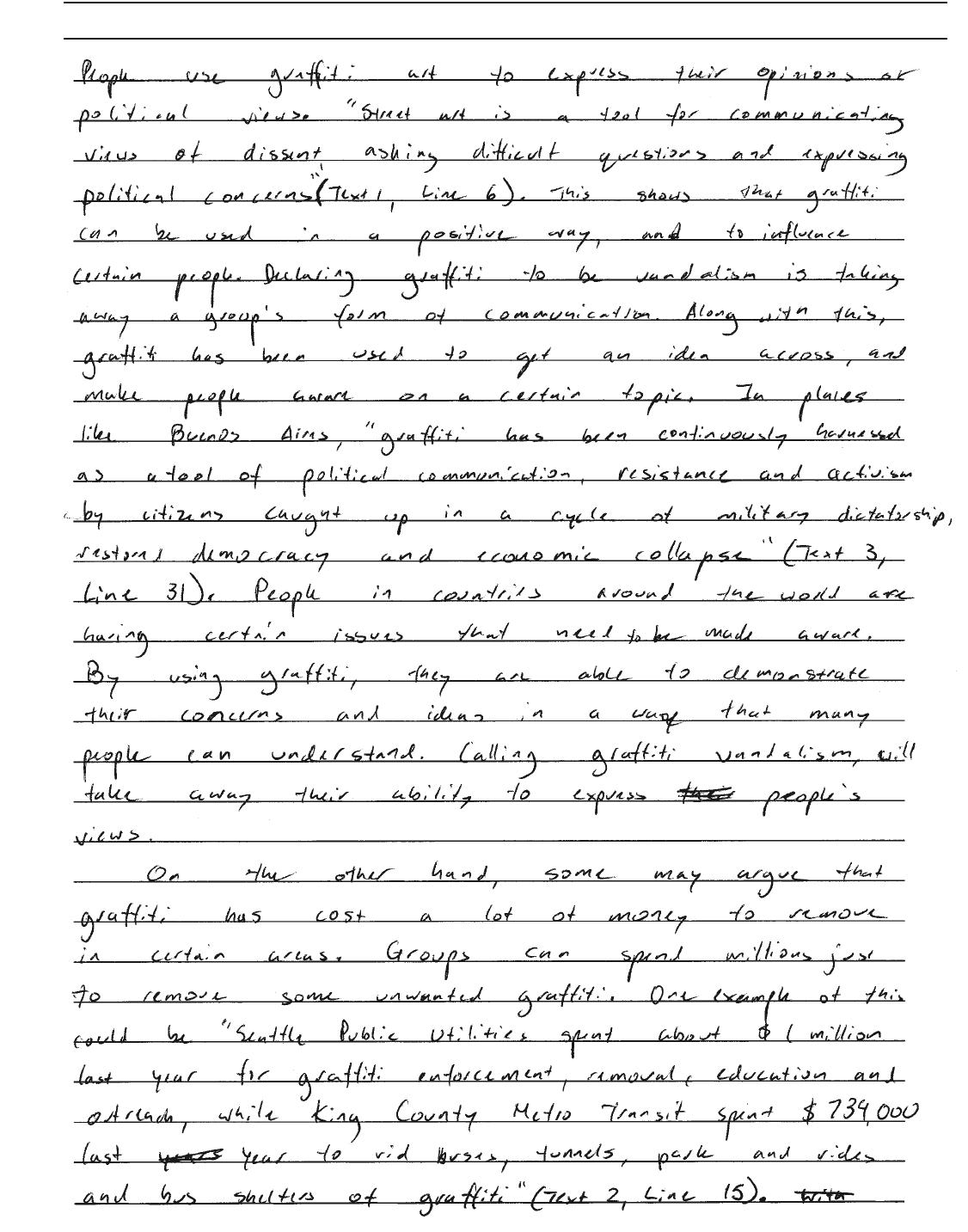
Anchor Paper – Part 2 – Level 5 – C
Regents Exam in ELA Rating Guide — June ’18 [17]
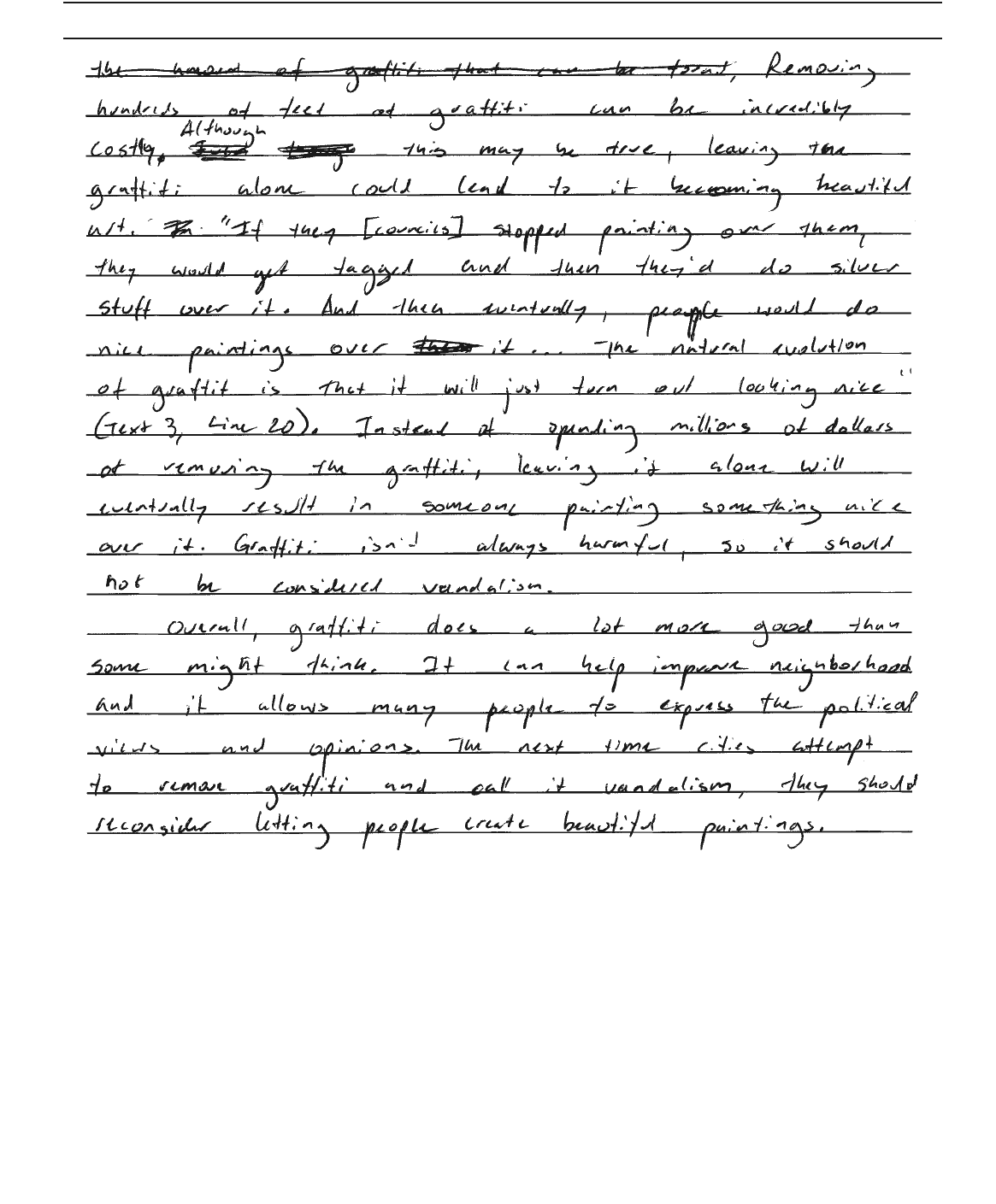
Regents Exam in ELA Rating Guide — June ’18 [18]
Anchor Paper – Part 2 – Level 5 – C
Anchor Level 5–C
The essay introduces a precise and thoughtful claim, as directed by the task (Graffiti is not a form of vandalism because of regenerative
and political reasons). The essay demonstrates a thorough analysis of the texts, as necessary to support the claim (This shows that if
graffiti artists create beautiful forms of art, it could help neighborhoods improve and become beautiful) and to distinguish the claim
from alternate or opposing claims (On the other hand, some may argue that graffiti has cost a lot of money to remove in certain areas
and Although this may be true, leaving the graffiti alone could lead to it becoming beautiful art). The essay presents ideas clearly and
accurately, making effective use of specific and relevant evidence to support analysis (Graffiti can be used “as a means of urban
beautification and regeneration” and One example of this could be “Seattle Public Utilities spent about $1 million last year … to rid
buses, tunnels, park and rides and bus shelters of graffiti”). The essay demonstrates proper citation of sources to avoid plagiarism
when dealing with direct quotes and paraphrased material [(Text 4, Line 21) and (Text 3, Line 20)]. The essay exhibits acceptable
organization of ideas and information to create a coherent essay, with an introduction that states the claim, two body paragraphs that
focus on the positive aspects of graffiti as a way to greatly improve neighborhoods and demonstrates concerns and ideas of people
around the world, one paragraph that refutes the counterclaim that removing … graffiti can be incredibly costly and a summative
conclusion. The essay establishes and maintains a formal style, using precise and appropriate language and structure (Graffiti isn’t
always harmful, so it should not be considered vandalism). The essay demonstrates control of conventions, exhibiting occasional errors
(genuialy, aware on, dollars of removing) only when using sophisticated language.
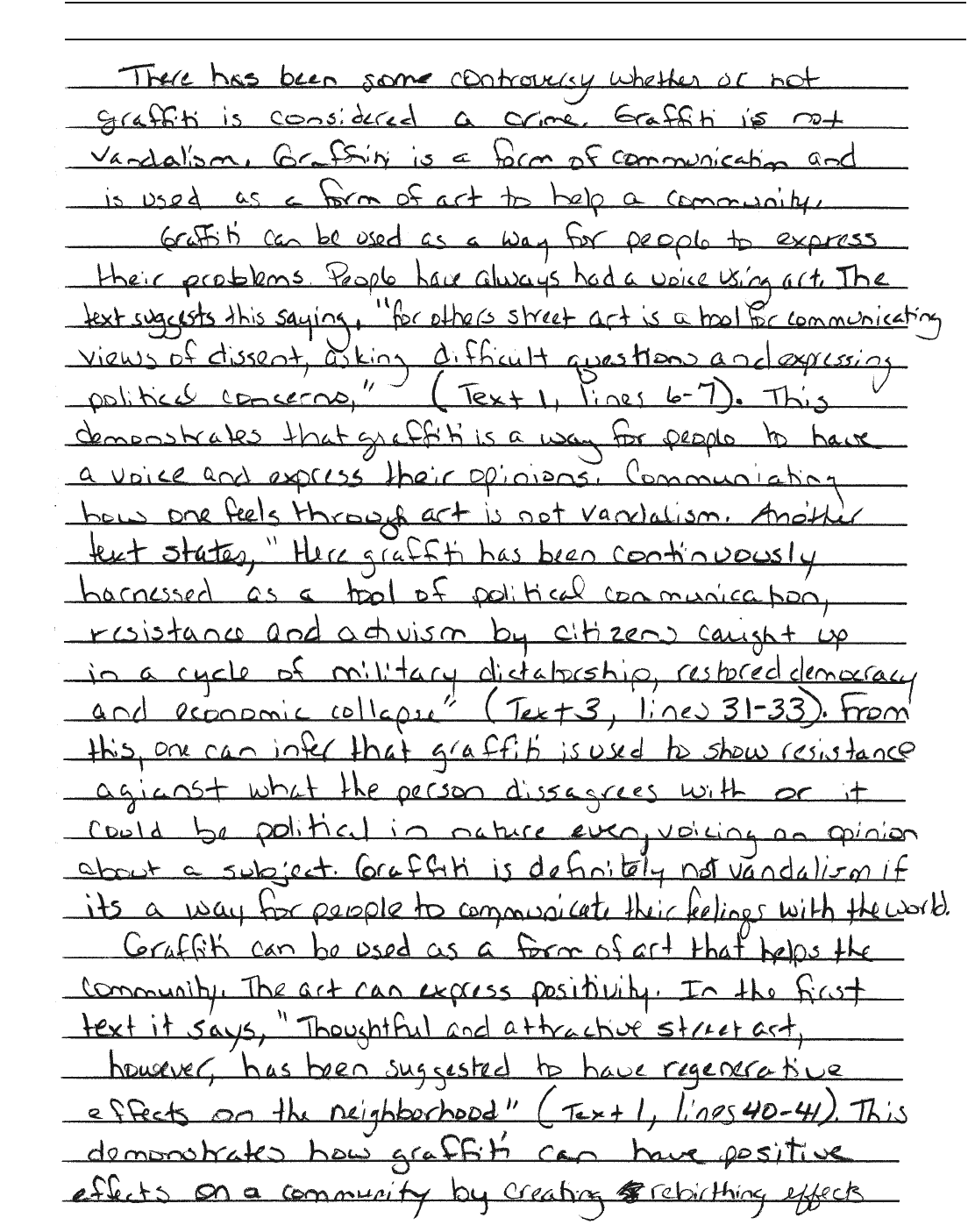
Regents Exam in ELA Rating Guide — June ’18 [19]
Anchor Paper – Part 2 – Level 4 – A

Regents Exam in ELA Rating Guide — June ’18 [20]
Anchor Paper – Part 2 – Level 4 – A

Regents Exam in ELA Rating Guide — June ’18 [21]
Anchor Level 4–A
The essay introduces a precise claim, as directed by the task (Graffiti is not vandalism. Graffiti is a form of communication and is used
as a form of art to help a community). The essay demonstrates appropriate and accurate analysis of the texts, as necessary to support
the claim (This demonstrates that graffiti is a way for people to have a voice and express their opinions) and to distinguish the claim
from alternate or opposing claims (Although some people may think graffiti is vandalism its not. Instead, graffiti helps the culture and
increases tourism). The essay presents ideas clearly and accurately, making effective use of specific and relevant evidence to support
analysis (Graffiti can be used as a form of art that helps the community … In the first text it says, “Thoughtful and attractive street art,
however, has been suggested to have regenerative effects on the neighborhood” and “5Pointz has now become a tourist attraction,
with hundreds visiting each week” … From this, one can infer graffiti positively impacts places by increasing tourism). The essay
demonstrates proper citation of sources to avoid plagiarism when dealing with direct quotes and paraphrased material [(Text 1, lines 6-
7) and (Text 3, lines 31-33)]. The essay exhibits acceptable organization of ideas and information to create a coherent essay with an
opening paragraph that introduces the claim, two paragraphs of support, a paragraph that refutes the counterclaim, and a conclusion
that reiterates the original claim (In conclusion graffiti is not vandalism. Graffi is a way for communication, its a form of art that
impacts the community positively, and it increases tourism). The essay establishes and maintains a formal style, using precise and
appropriate language and structure (This demonstrates how graffiti can have positive effects on a community by creating rebirthing
effects that draw people to it). The essay demonstrates partial control of conventions, exhibiting occasional errors (Communiating,
agianst, dissagrees; its just, In conclusion graffiti) that do not hinder comprehension.

Regents Exam in ELA Rating Guide — June ’18 [22]
Anchor Paper – Part 2 – Level 4 – B
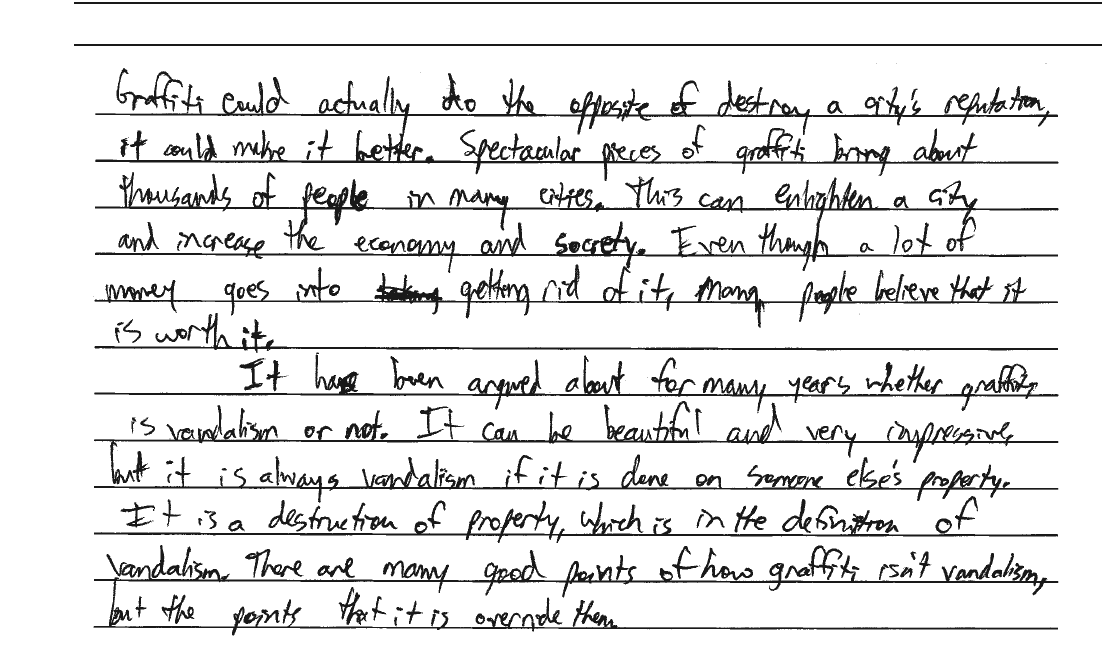
Regents Exam in ELA Rating Guide — June ’18 [23]
Anchor Paper – Part 2 – Level 4 – B
Anchor Level 4–B
The essay introduces a precise claim, as directed by the task (When you are painting on objects that don’t belong to you, it is without a
doubt considered vandalism). The essay demonstrates appropriate and accurate analysis of the texts, as necessary to support the claim
(One big reason that graffiti is vandalism and should be against the law is because it costs a lot of money to get rid of) and to
distinguish the claim from alternate or opposing claims (On the contrary, graffiti could be seen as beautiful street art). The essay
presents ideas sufficiently, making adequate use of specific and relevant evidence to support analysis (Spectacular pieces of graffiti
bring about thousands of people in many cities. This can enlighten a city and increase the economy). The essay demonstrates proper
citation of sources to avoid plagiarism when dealing with direct quotes and paraphrased material [(Text 2, ln. 15-17) and (Text 3, ln.
27-28)]. The essay exhibits acceptable organization of ideas and information to create a coherent essay with an opening paragraph that
introduces the claim, followed by one body paragraph that provides evidence to support the claim, another paragraph that addresses the
counterclaim, and a summative conclusion that reaffirms the original claim (It is a destruction of property, which is in the definition of
vandalism). The essay establishes and maintains a formal style, using precise and appropriate language and structure (So not only does
it cost a lot to take care of, but when it is there, it damages the town and its reputation) that is sometimes colloquial (Graffiti looks
trashy … in a sketchy area). The essay demonstrates partial control of conventions, exhibiting occasional errors [symbol, or; It … they;
(text 1, ln. 37-39) Graffi; of destroy a city’s reputation] that do not hinder comprehension.
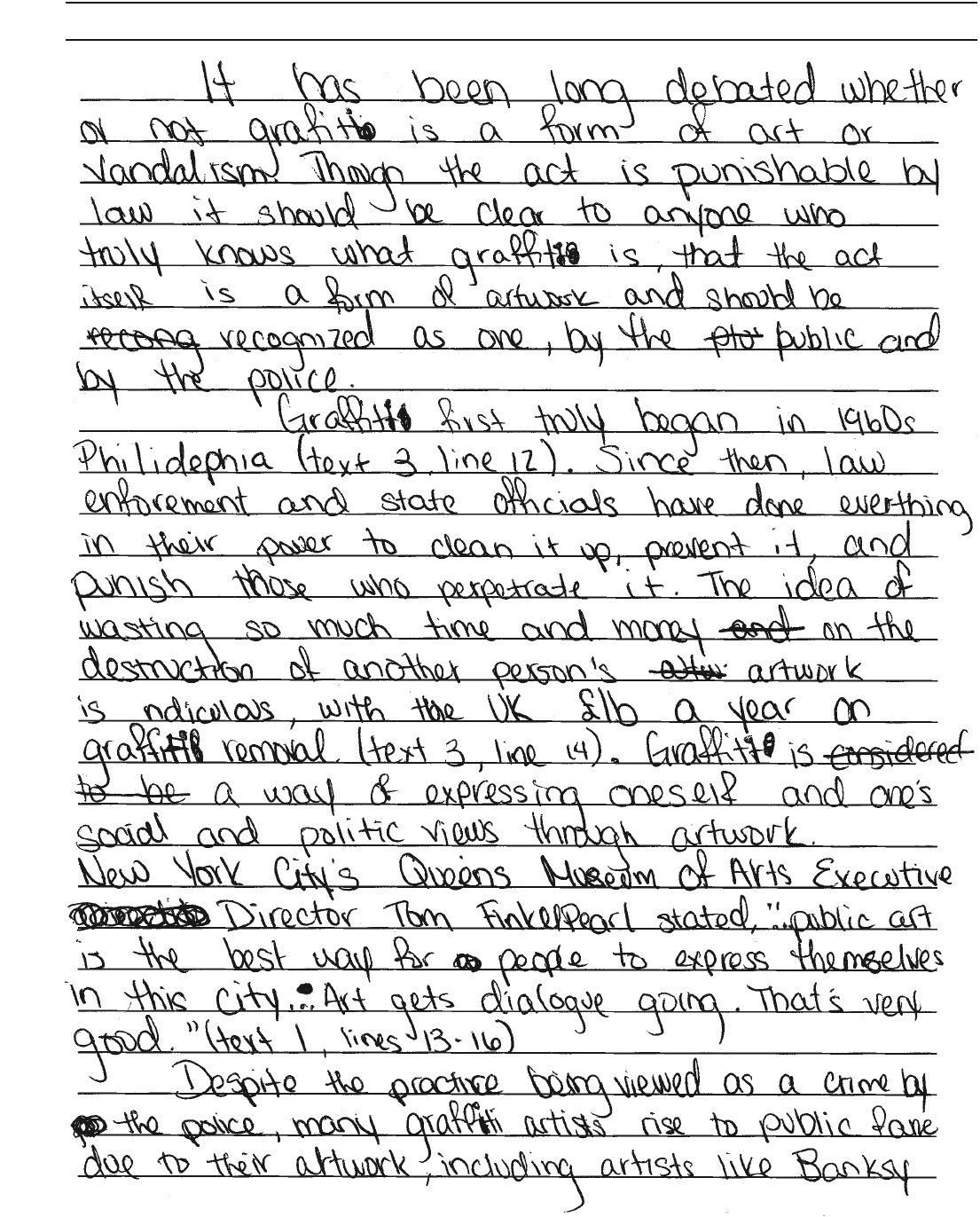
Regents Exam in ELA Rating Guide — June ’18 [24]
Anchor Paper – Part 2 – Level 4 – C
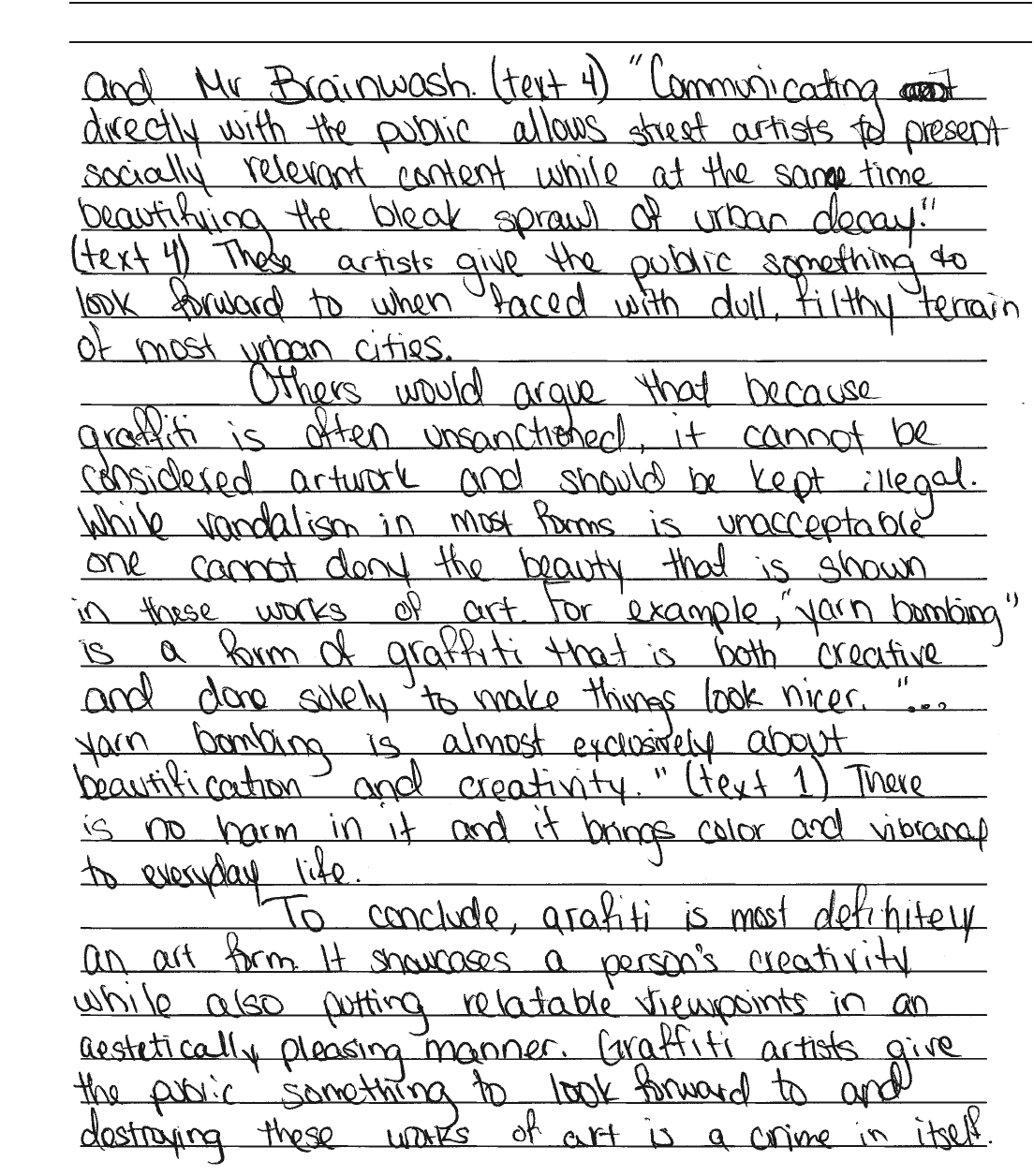
Regents Exam in ELA Rating Guide — June ’18 [25]
Anchor Paper – Part 2 – Level 4 – C

Regents Exam in ELA Rating Guide — June ’18 [26]
Anchor Level 4–C
The essay introduces a precise claim, as directed by the task (it should be clear to anyone who truly knows what graffiti is, that the act
itself is a form of artwork and should be recognized as one). The essay demonstrates appropriate and accurate analysis of the texts, as
necessary to support the claim (Graffiti is a way of expressing oneself and one’s … views through artwork and Despite the practice
being viewed as a crime … many graffiti artists rise to public fame due to their artwork) and to distinguish the claim from alternate or
opposing claims (Others would argue that because graffiti is often unsanctioned, it cannot be considered artwork). The essay presents
ideas sufficiently, making adequate use of specific and relevant evidence to support analysis (“Communicating directly with the public
allows street artists to present socially relevant content” and For example, “yarn bombing” is a form of graffiti that is both creative
and done soley to make things look nicer). The essay demonstrates inconsistent citation of sources to avoid plagiarism when dealing
with direct quotes and paraphrased material [(text 3, line 12), (text 1, lines 13-16) and (text 4)]. The essay exhibits acceptable
organization of ideas and information to create a coherent essay with an opening paragraph that introduces the claim, two paragraphs
that support the claim, followed by a paragraph that presents and refutes the counterclaim, and a conclusion that reiterates the original
claim (grafiti is most definitely an art form). The essay establishes and maintains a formal style, using precise and appropriate language
and structure (It showcases a person’s creativity while also putting relatable viewpoints in an aestetically pleasing manner). The essay
demonstrates emerging control of conventions, exhibiting occasional errors [law it; one, by; Philidephia; enforement; everthing;
unacceptable one; .” (text 1); aestetically] that hinder comprehension.

Regents Exam in ELA Rating Guide — June ’18 [27]
Anchor Paper – Part 2 – Level 3 – A
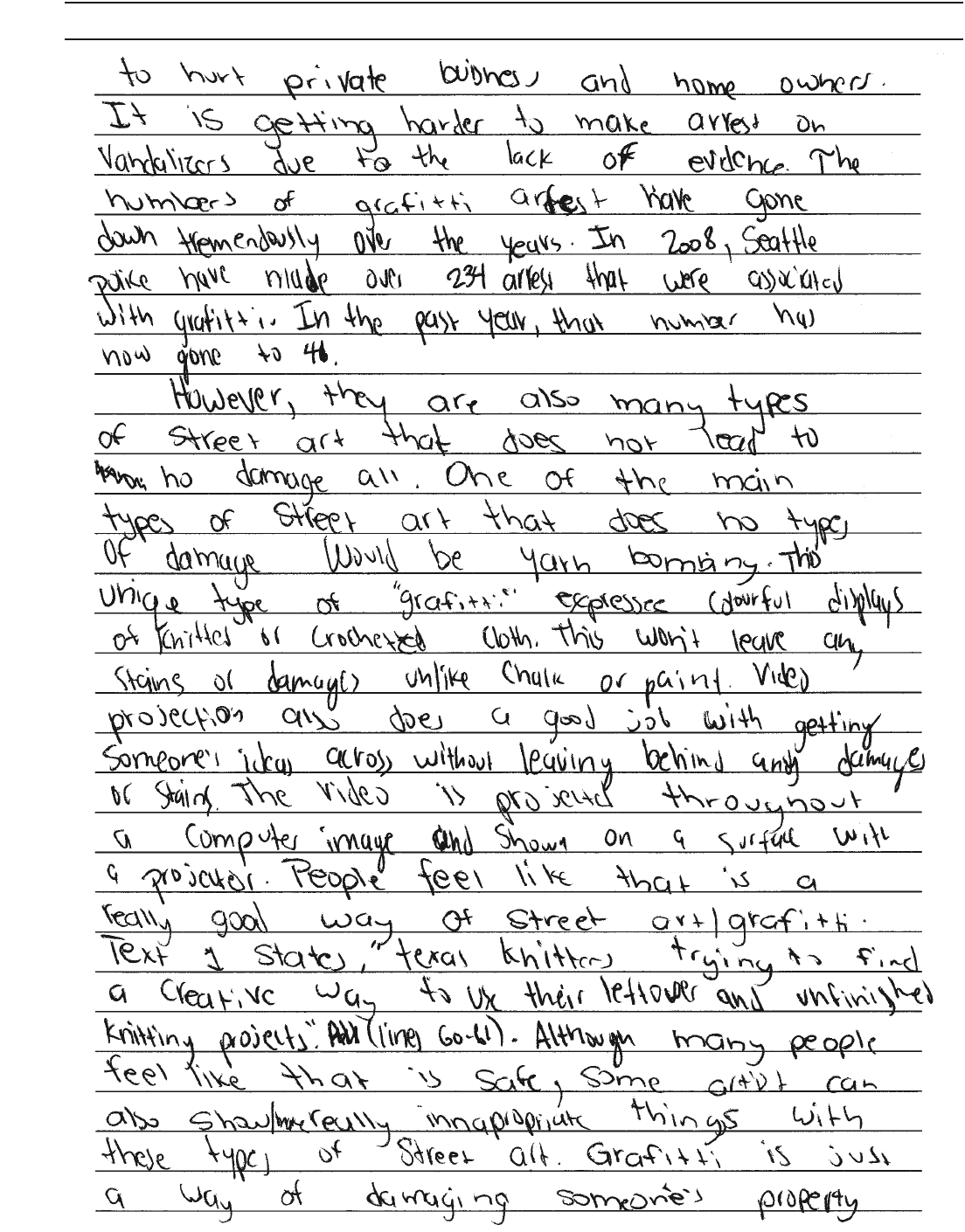
Regents Exam in ELA Rating Guide — June ’18 [28]
Anchor Paper – Part 2 – Level 3 – A

Regents Exam in ELA Rating Guide — June ’18 [29]
Anchor Paper – Part 2 – Level 3 – A
Anchor Level 3–A
The essay introduces a reasonable claim, as directed by the task (The viewpoints on Graffiti are often on the negative side … Street art
often damages government owned properties which can lead to alot of expence trying to fix it). The essay demonstrates appropriate and
accurate analysis of the texts, as necessary to support the claim (This shows how vandalizers are beginning to hurt private buisness and
This quote from the article makes it clear that grafitti can be very harmful to one’s life) and to distinguish the claim from alternate or
opposing claims (However, they are also many types of street art that does not lead to no damage all). The essay presents ideas
sufficiently, making adequate use of specific and relevant evidence to support analysis (The grafitti artist would also affect the buisness
owner as well … If private businesses or homes get tagged and owners don’t act prompty … property owners could face fines and The
numbers of grafitti arrest have gone down tremendously over the years. In 2008, Seattle police have made over 234 arrest that were
associated with grafitti. In the past year, that number has now gone to 41). The essay demonstrates inconsistent citation of sources to
avoid plagiarism when dealing with direct quotes and paraphrased material, properly citing some texts [In text 1 … (lines 17-18) and
text two states … (lines 51-54 )], while other direct references are not identified. The essay exhibits acceptable organization of ideas
and information to create a coherent essay, with an introduction that introduces the claim, followed by one body paragraph that focuses
on the criminal and harmful aspects of graffiti, a second body paragraph that addresses the counterclaim and a conclusion that reiterates
the claim that grafitti would be considered vandalism. The essay establishes but fails to maintain a formal style, using primarily basic
language and structure (People would write their names on anything just for somewhat “fame” and It would take to owner a long time).
The essay demonstrates partial control of conventions, exhibiting occasional errors (alot, expence, claims “It’s, buisness, does not lead
to no, make arrest on, innapropriate) that hinder comprehension. The essay addresses fewer texts than required by the task and can be
scored no hi
g
her than a 3.
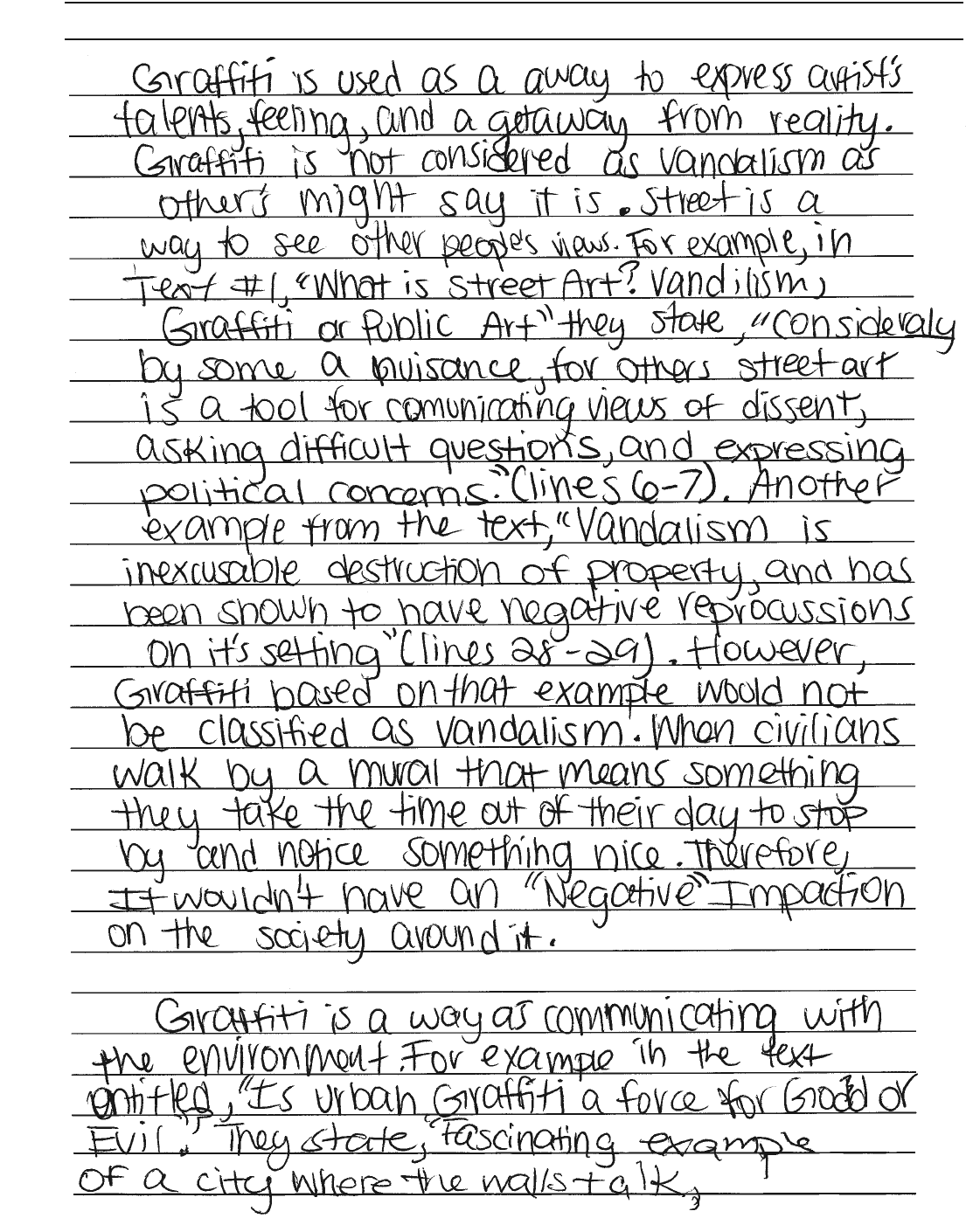
Regents Exam in ELA Rating Guide — June ’18 [30]
Anchor Paper – Part 2 – Level 3 – B
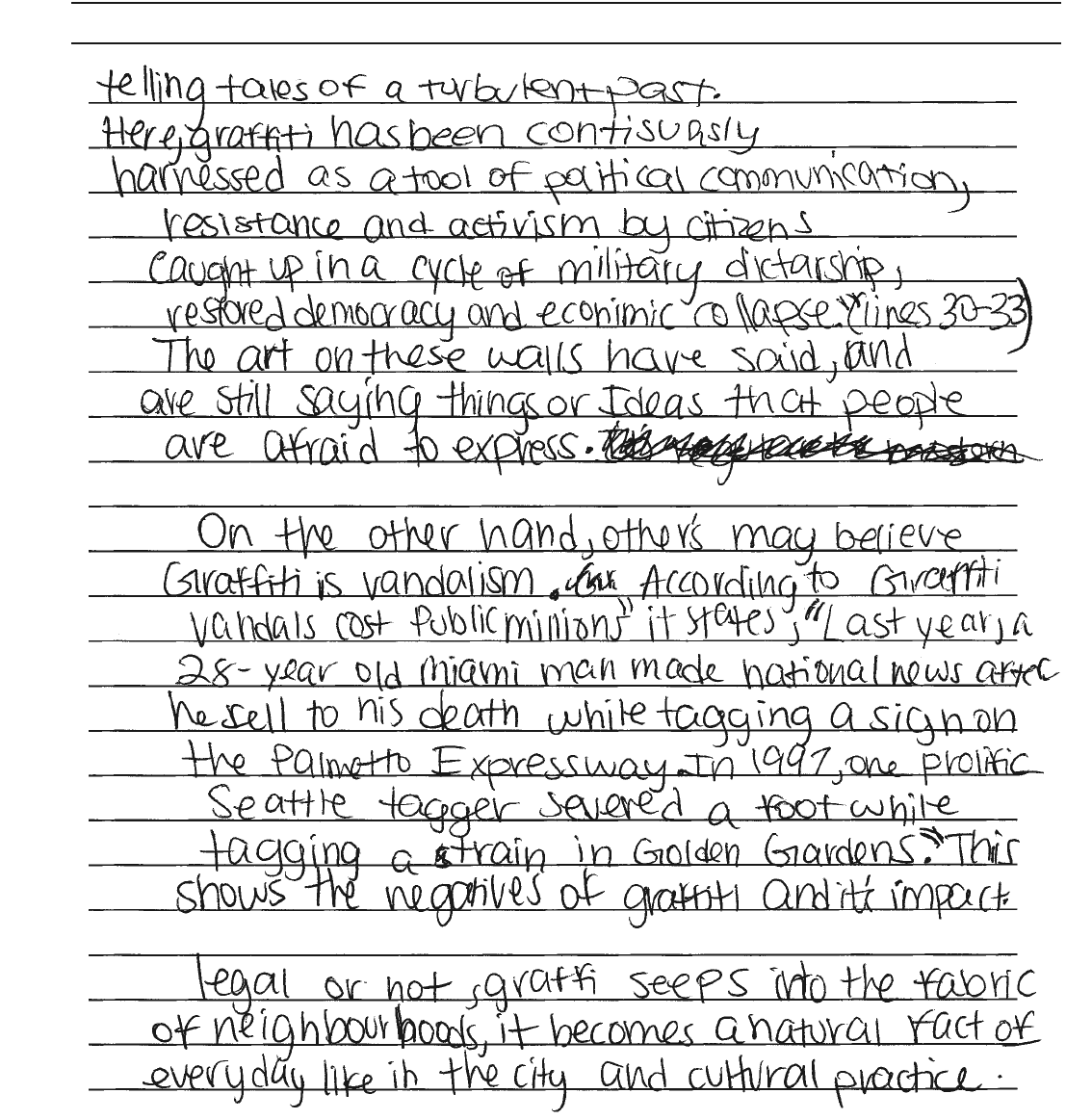
Regents Exam in ELA Rating Guide — June ’18 [31]
Anchor Paper – Part 2 – Level 3 – B

Regents Exam in ELA Rating Guide — June ’18 [32]
Anchor Level 3–B
The essay introduces a reasonable claim, as directed by the task (Graffiti is not considered as vandalism as other’s might say it is.
Street [art] is a way to see other people’s views). The essay demonstrates some analysis of the texts (When civilians walk by a mural
that means something they take the time out of their day to stop by and notice something nice), but insufficiently distinguishes the
claim from alternate or opposing claims (On the other hand, other’s may believe Graffiti is vandalism … In 1997, one prolific Seattle
tagger severed a foot). The essay presents ideas briefly, making use of some specific and relevant evidence to support analysis (“Street
art is a tool for comunicating views of dissent, asking difficult questions, and expressing political concerns” … Graffiti based on that
example would not be classified as vandilism). The essay demonstrates inconsistent citation of sources to avoid plagiarism when
dealing with direct quotes and paraphrased material. While sometimes citing both text and line numbers (Text #1 … lines 6-7), the
essay sometimes identifies evidence by title alone or, as in the last paragraph, is completely copied with no source referencing at all.
The essay exhibits some organization of ideas and information to create a mostly coherent essay by first introducing the claim and both
sides of the issue, followed by a second paragraph of support and a third paragraph that addresses the counterclaim, concluding with a
totally copied general comment about graffiti. The essay establishes but fails to maintains a formal style, using primarily basic
language and structure (an for “a”, The art on these walls have said, and are still saying things or Ideas that people are afraid to
express and This shows the negatives of graffiti and it’s impact). The essay demonstrates emerging control of conventions, exhibiting
occasional errors (other’s; Art” they; reprocussions; it’s setting; something they; “Negative”; contisuasly, dictarship; legal) that
hinder comprehension.

Regents Exam in ELA Rating Guide — June ’18 [33]
Anchor Paper – Part 2 – Level 3 – C

Regents Exam in ELA Rating Guide — June ’18 [34]
Anchor Paper – Part 2 – Level 3 – C
Anchor Level 3–C
The essay introduces a reasonable claim, as directed by the task, first stating that although some may argue that Graffiti shouldnt be
prohibited; but I agree otherwise, and later clarifying the claim by stating that I believe that graffiti isnt vandalism. The essay
demonstrates some analysis of the texts, but insufficiently distinguishes the claim from alternate or opposing claims (Graffiti shall be
prohibited in america today to here some of our talented citizens out). The essay presents ideas briefly, making use of some specific
and relevant evidence to support analysis, referring to the existence of “gang symbols” and “mindless vandalism,” identifying graffiti
as a sign of “beautification” and “creativity,” and mentioning Norman Mailer’s book. The essay demonstrates inconsistent citation of
sources to avoid plagiarism when dealing with direct quotes and paraphrased material by broadly identifying texts (In Passages 2 and 3
and In Passages 1 and 4), but not referencing line numbers. The essay exhibits some organization of ideas and information to create a
mostly coherent essay, first addressing positive aspects of graffiti, then presenting a paragraph that primarily explains the negative
perceptions of graffiti and counters with another paragraph that explains its purpose and benefits, and follows with a one-sentence
summative conclusion. The essay lacks a formal style, using language and structure that is sometimes imprecise (It let’s people internal
thought’s and state of mind come out because it maybe some who wont hear them out). The essay demonstrates a lack of control of
conventions, exhibiting frequent errors (many society’s, wont, potray’s Passage 3 they, one’s that’s, an piece, illistrates, miller it is)
that make comprehension difficult.
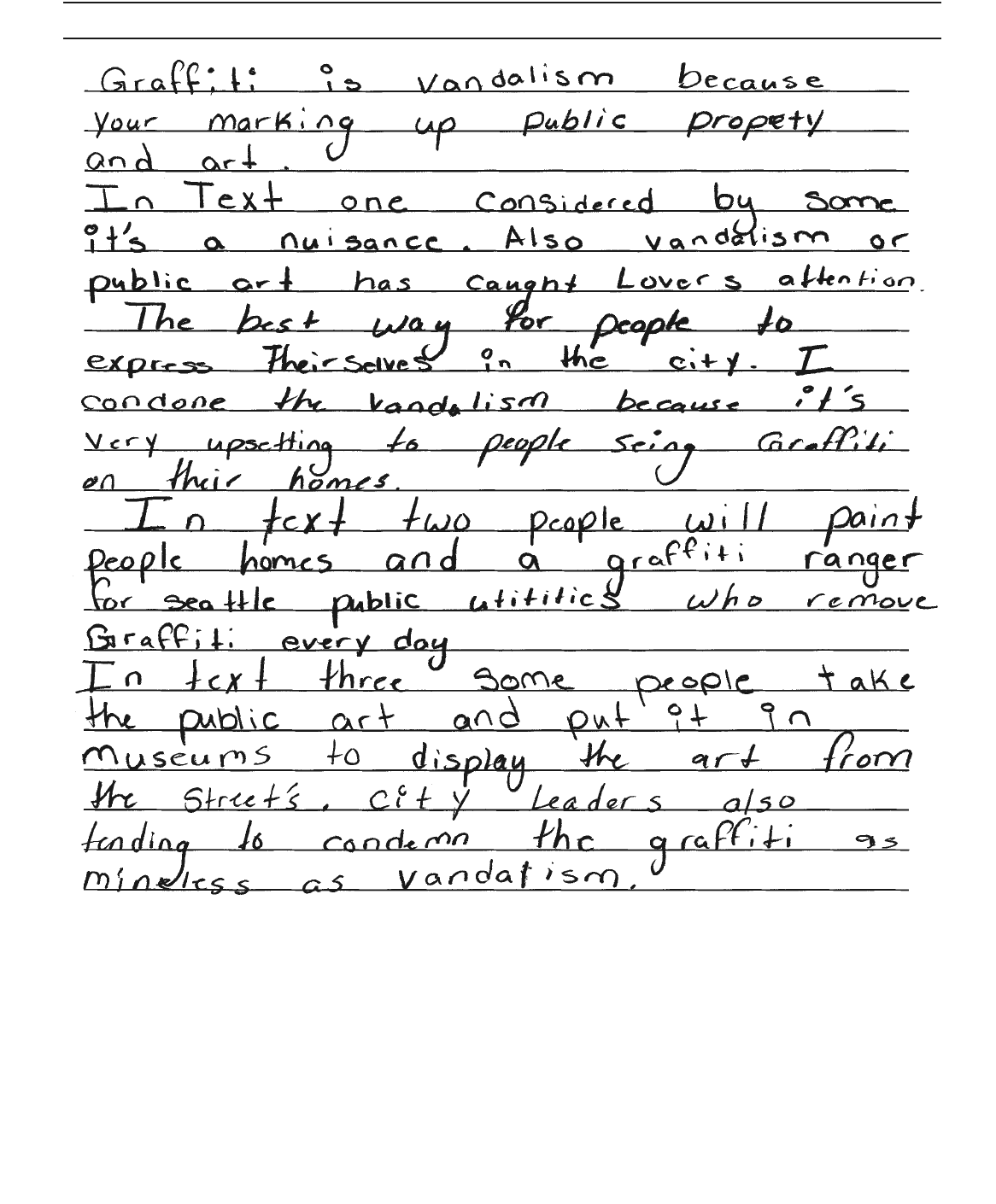
Regents Exam in ELA Rating Guide — June ’18 [35]
Anchor Paper – Part 2 – Level 2 – A
Anchor Level 2–A
The essay introduces a claim (Graffiti is vandalism because your marking up public proprety and art). The essay demonstrates a
confused and unclear analysis of the texts (people will paint people homes and a graffiti ranger for seattle public utitities who remove
Graffiti every day), failing to distinguish the claim from alternate or opposing claims. The essay presents ideas inconsistently and
inaccurately, in an attempt to support analysis (I condone the vandalism because it’s very upsetting to people seing Graffiti on their
homes), making use of some evidence that may be irrelevant (public art has caught Lovers attention). The essay demonstrates
inconsistent use of citations to avoid plagiarism when dealing with direct quotes and paraphrased material, only referring to a text by
number (In Text one, In text two, In text three). The essay exhibits inconsistent organization of ideas and information, failing to create a
coherent essay, with a one-sentence statement of the claim, and then a paragraph devoted to each of three texts. There is no conclusion.
The essay lacks a formal style, using some language that is imprecise (your for “you’re”, considered by some it’s, theirselves for
“themselves”, I condone the vandalism, leaders also tending to, mineless for “mindless”). The essay demonstrates emerging control of
conventions, exhibiting occasional errors (proprety, seing, people homes and, seattle public utilities who remove, street’s, also tending)
that hinder comprehension.
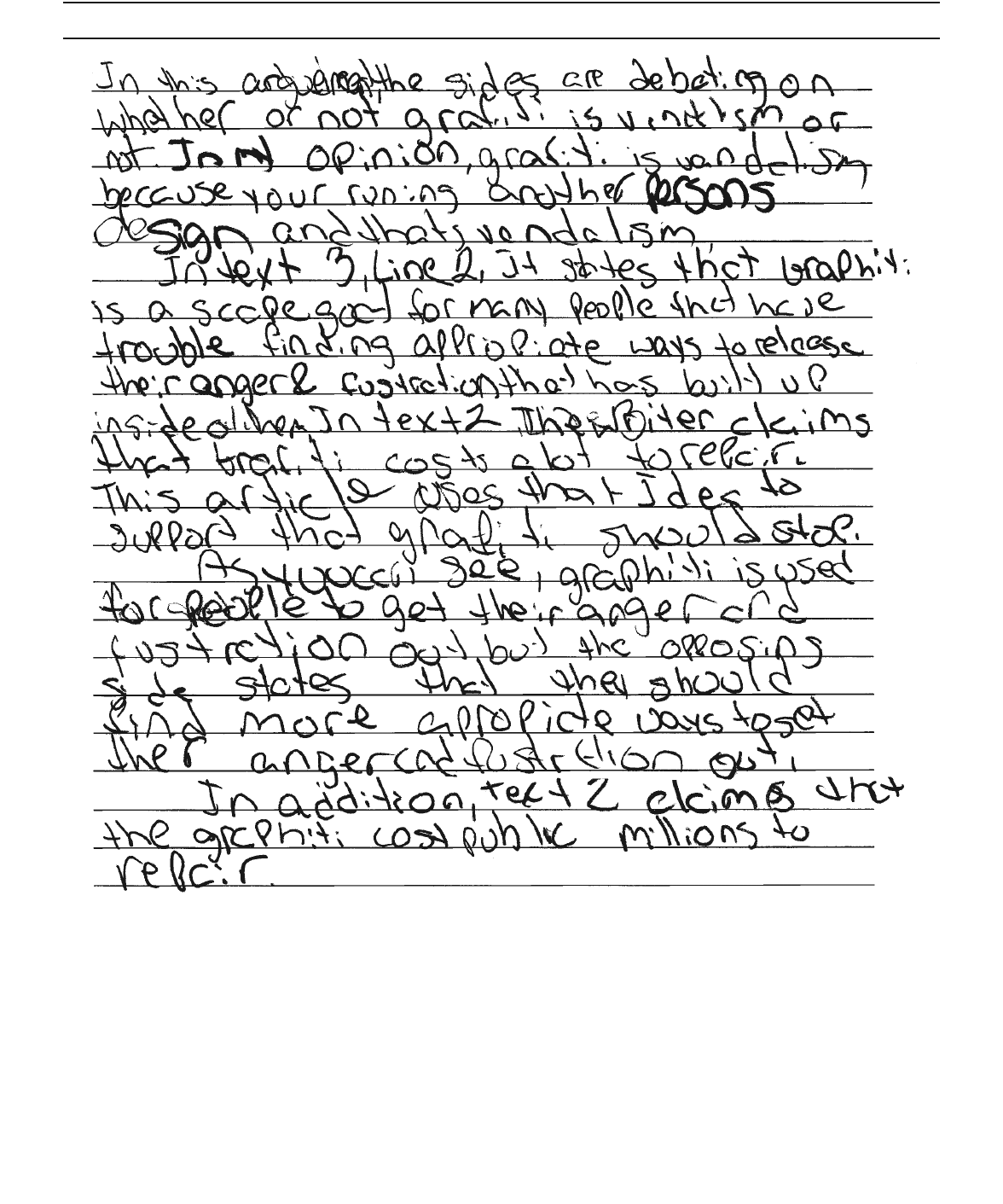
Regents Exam in ELA Rating Guide — June ’18 [36]
Anchor Paper – Part 2 – Level 2 – B
Anchor Level 2–B
The essay introduces a claim (In my opinion, grafiti is vendelsim). The essay demonstrates a confused and unclear analysis of the texts
(your runing another persons design), failing to distinguish the claim from alternate or opposing claims by merely reversing an
unfounded proposed argument (As you can see, graphiti is used for people to get their anger and fustration out but the opposing side
states that they should find more appropriate ways to get their anger and fustration out). The essay presents ideas inconsistently by
introducing, but never developing, the idea of graffiti being vandalism because it ruins another person’s design, and inaccurately
(Graphiti is a scapegoat for many people … to release their anger & fustration). The essay demonstrates inconsistent use of citations
when dealing with direct quotes and paraphrased material, giving one complete citation (Text 3, Line 2) and twice identifying a
reference as text 2. The essay exhibits inconsistent organization, first introducing a claim that includes a proposed argument in defense
of the claim, followed by two independent statements of support unrelated to the initial argument, and an apparent attempt at a
counterclaim, ending with a paraphrase of an earlier statement of support. The essay lacks a formal style, using some language that is
imprecise (your for “you’re” and the graphiti cost public). The essay demonstrates a lack of control of conventions, exhibiting frequent
errors (vendilism, runing, persons, thats, graphiti, appropiate, fustration, grafiti, out but) that make comprehension difficult.
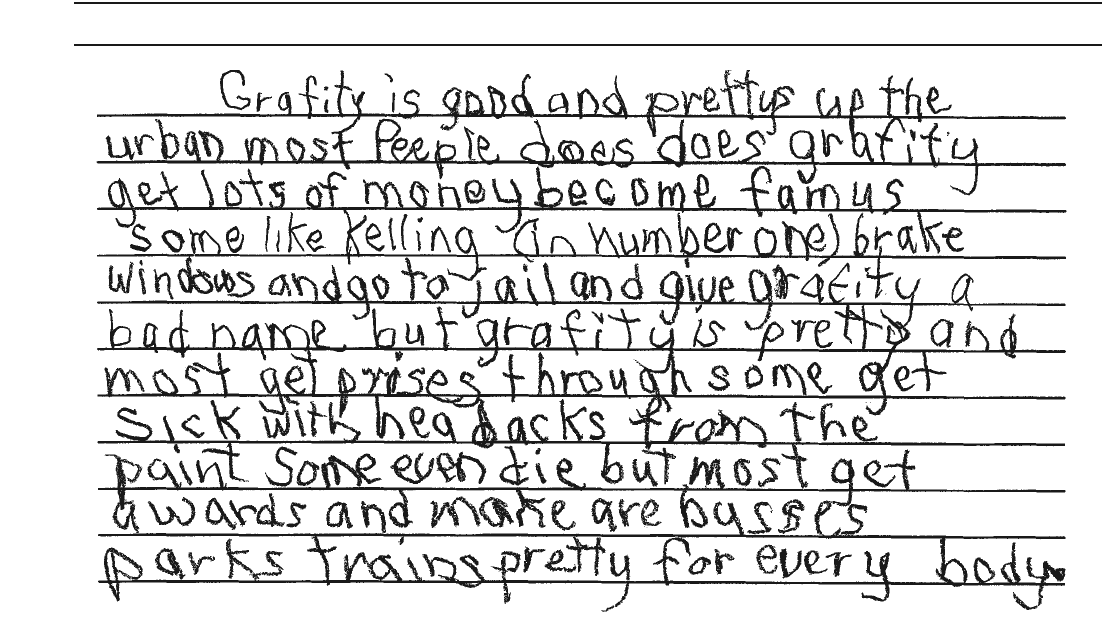
Regents Exam in ELA Rating Guide — June ’18 [37]
Anchor Paper – Part 2 – Level 2 – C
Anchor Level 2–C
The essay introduces a claim (Grafity is good) but does not demonstrate analysis of the texts beyond simple references to graffiti’s
ability to beautify an area (prettys up the urban) and to receive recognition (most get awards). There is no reference to an alternate or
opposing claim. The essay presents ideas inconsistently and inaccurately (some like kelling … brake windows and go to jail and give
grafity a bad name), in an attempt to support analysis, making use of some evidence that may be irrelevant (most get prises through
some get sick with headacks). The essay demonstrates little use of citations to avoid plagiarism when dealing with direct quotes and
paraphrased material, supplying only one text reference [(in number one)]. The essay exhibits inconsistent organization of ideas and
information, failing to create a coherent essay through the repetition of ideas (prettys up, is pretty, pretty for every body) and the
absence of punctuation. The essay lacks a formal style, using some language that is imprecise (most Peeple does does grafity get lots of
money become famus, prises for “prizes”, through for “though”, are for “our”). The essay demonstrates a lack of control of
conventions, exhibiting frequent errors (Grafity, urban most Peeple does, money become famus some, headacks busses parks trains)
that make comprehension difficult.
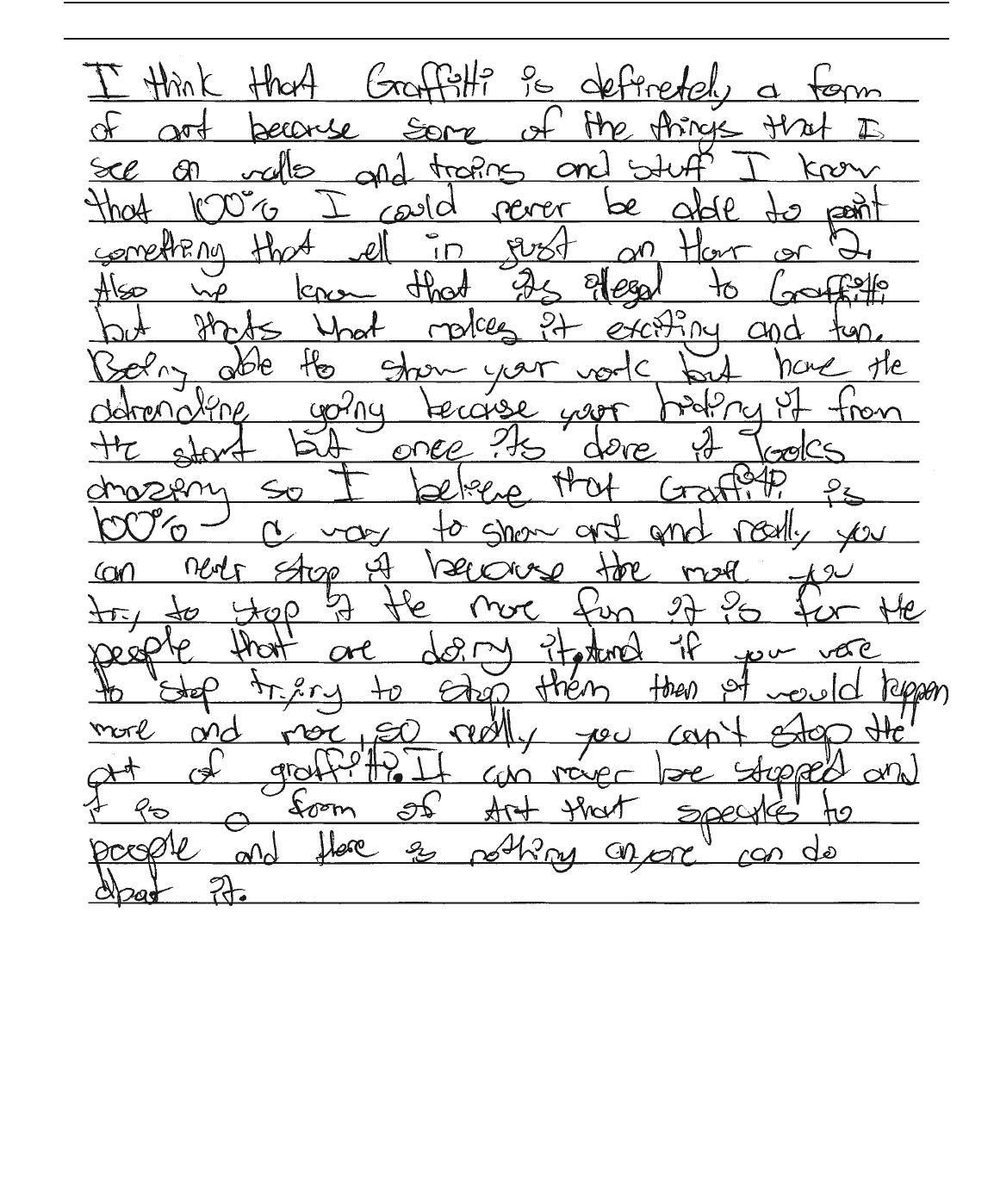
Regents Exam in ELA Rating Guide — June ’18 [38]
Anchor Paper – Part 2 – Level 1 – A
Anchor Level 1–A
The essay introduces a claim (I think that Graffiti is definetely a form of art), but does not demonstrate analysis of the texts. The essay
presents little evidence from the texts (Also we know that its illegal to Graffiti) but does not make use of citations. The essay exhibits
inconsistent organization of ideas and information, failing to create a coherent essay, consisting of one paragraph of loosely related
opinions about the difficulty, excitement, and fun associated with graffiti. The essay lacks a formal style, using some language that is
imprecise (and stuff, that 100%, Hour or 2, your for “you’re”) and the lack of punctuation from Being able to out of graffiti
compromises sentence structure. The essay demonstrates a lack of control of conventions, exhibiting frequent errors (Graffitti,
definetely, its illegal, stop it the more) and shifting to second person (we know and the more you try) that make comprehension
difficult. The essay is a personal response which makes little reference to the texts and can be scored no higher than a 1.

Regents Exam in ELA Rating Guide — June ’18 [39]
Anchor Paper – Part 2 – Level 1 – B
Anchor Level 1–B
The essay does not introduce a claim and does not demonstrate analysis of the texts. The essay presents no evidence from the text
beyond a general reference to graffiti. The essay does not make use of citations. The essay is minimal, making assessment of
coherence, organization, and style unreliable. The essay is minimal, making assessment of conventions unreliable.

Regents Exam in ELA Rating Guide — June ’18 [40]
Part 2 – Practice Paper – A
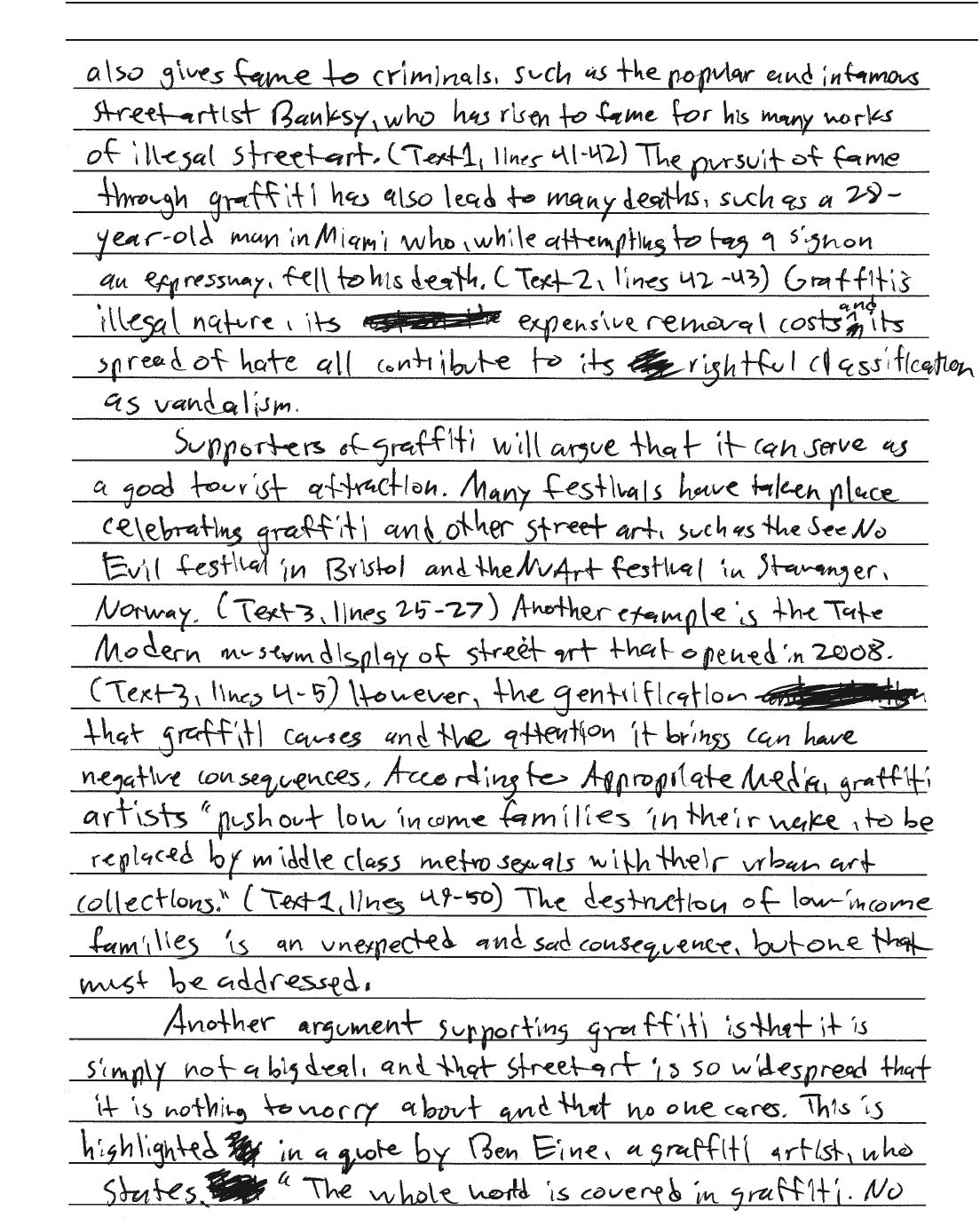
Regents Exam in ELA Rating Guide — June ’18 [41]
Part 2 – Practice Paper – A
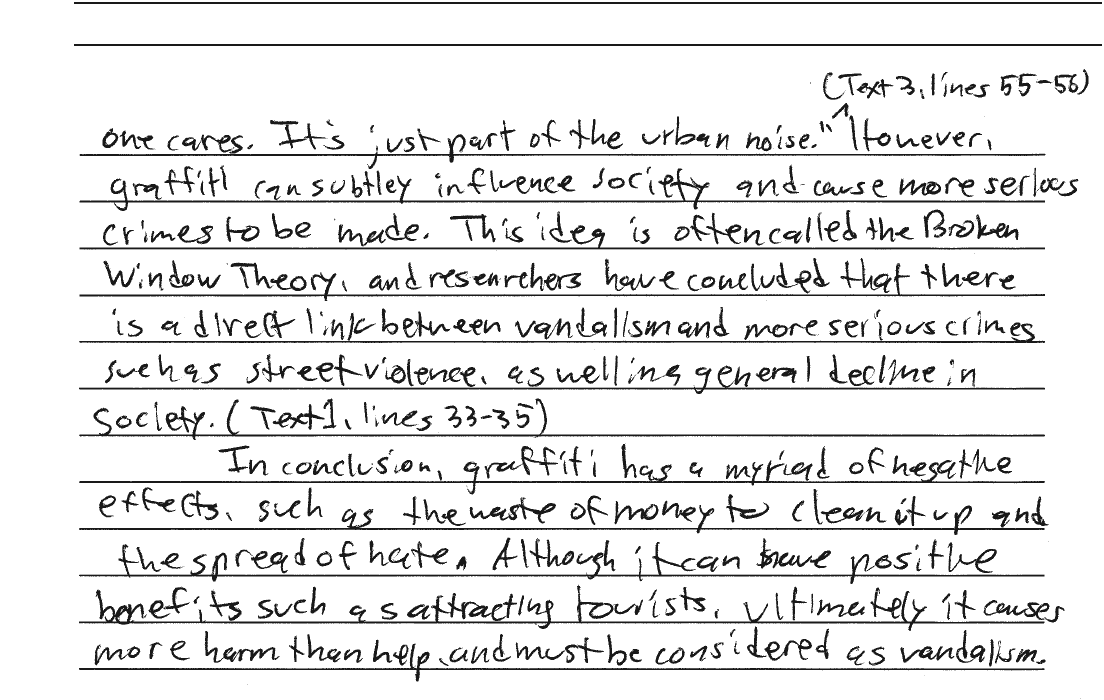
Regents Exam in ELA Rating Guide — June ’18 [42]
Part 2 – Practice Paper – A

Regents Exam in ELA Rating Guide — June ’18 [43]
Part 2 – Practice Paper – B

Regents Exam in ELA Rating Guide — June ’18 [44]
Part 2 – Practice Paper – C
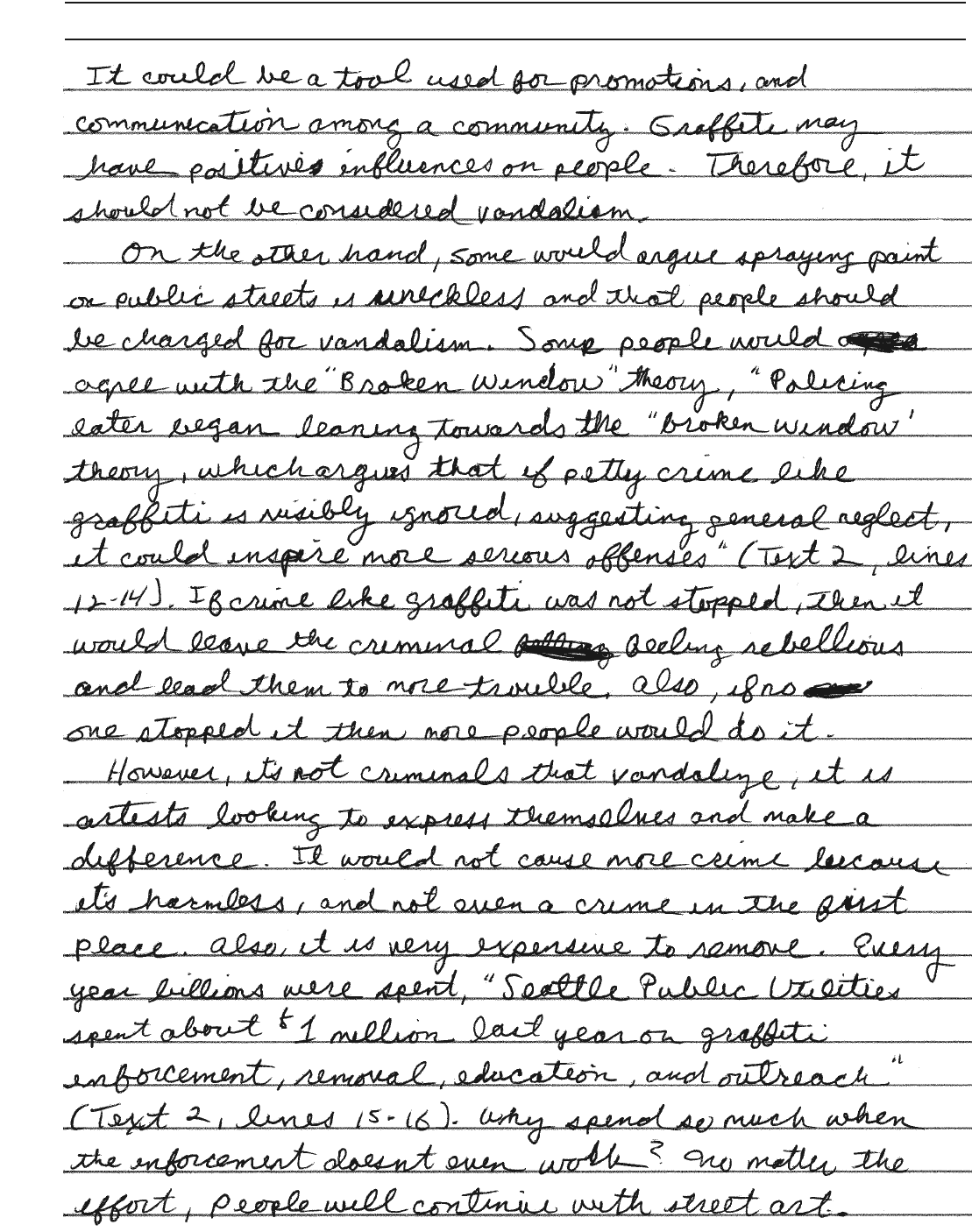
Regents Exam in ELA Rating Guide — June ’18 [45]
Part 2 – Practice Paper – C
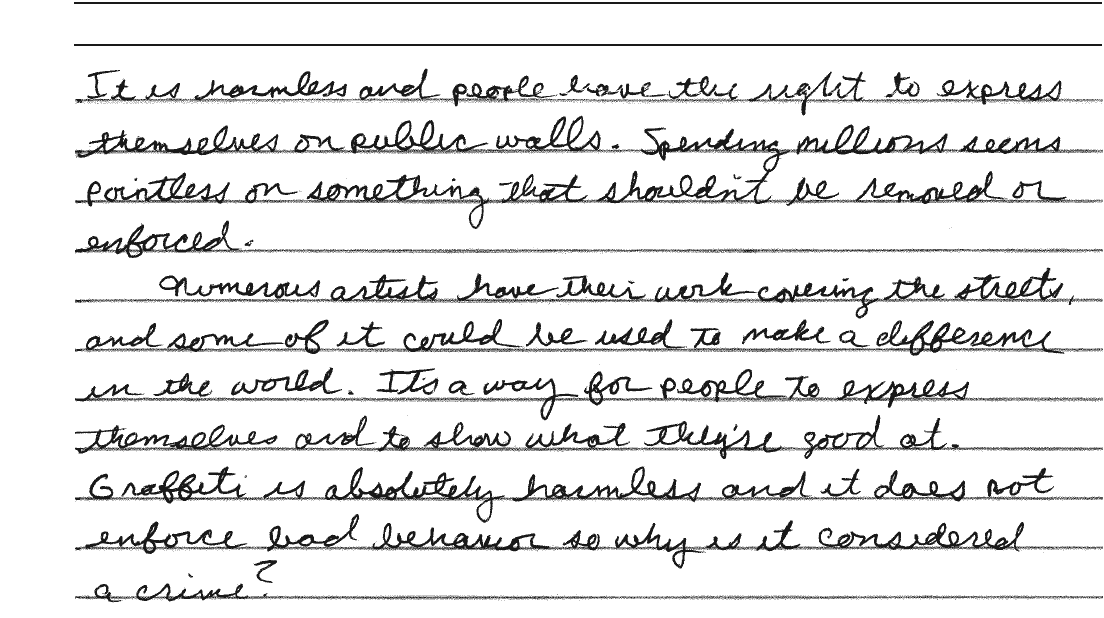
Regents Exam in ELA Rating Guide — June ’18 [46]
Part 2 – Practice Paper – C
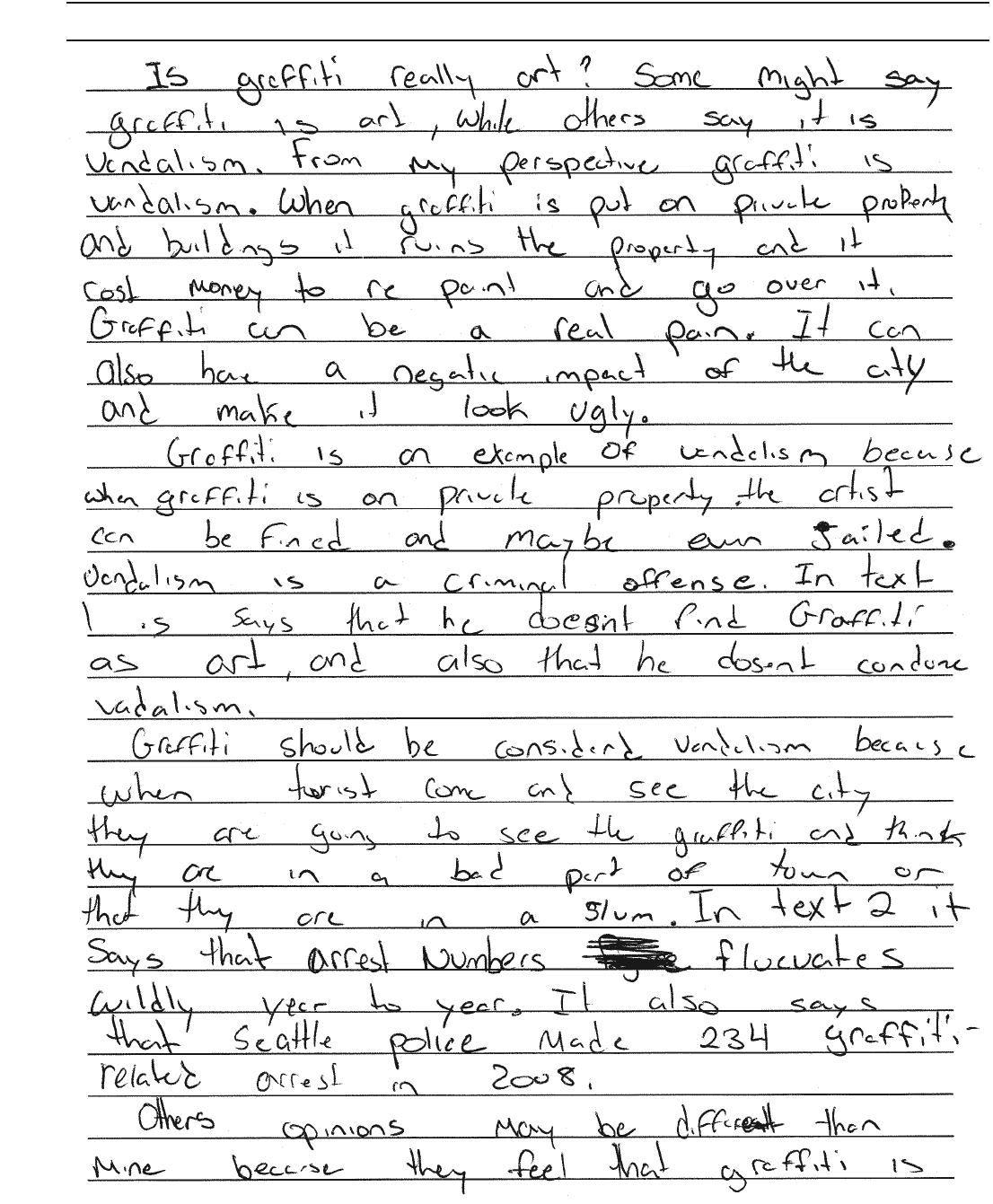
Regents Exam in ELA Rating Guide — June ’18 [47]
Part 2 – Practice Paper – D
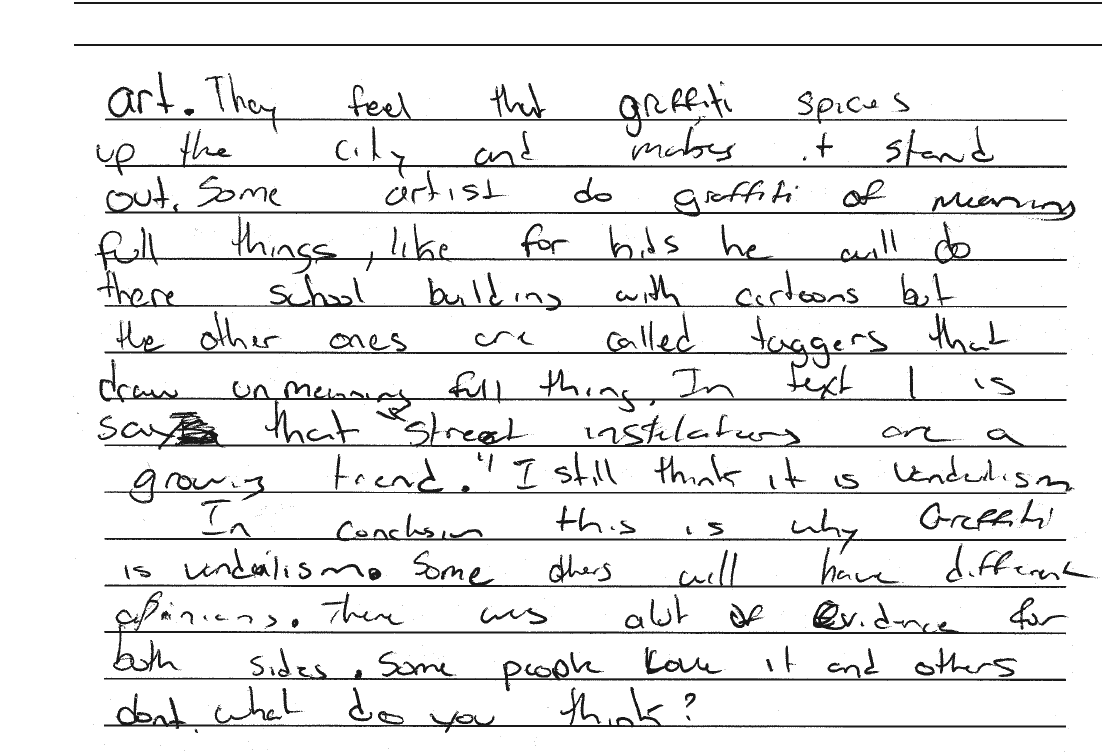
Regents Exam in ELA Rating Guide — June ’18 [48]
Part 2 – Practice Paper – D

Regents Exam in ELA Rating Guide — June ’18 [49]
Part 2 – Practice Paper – E

Regents Exam in ELA Rating Guide — June ’18 [50]
Part 2 – Practice Paper – E
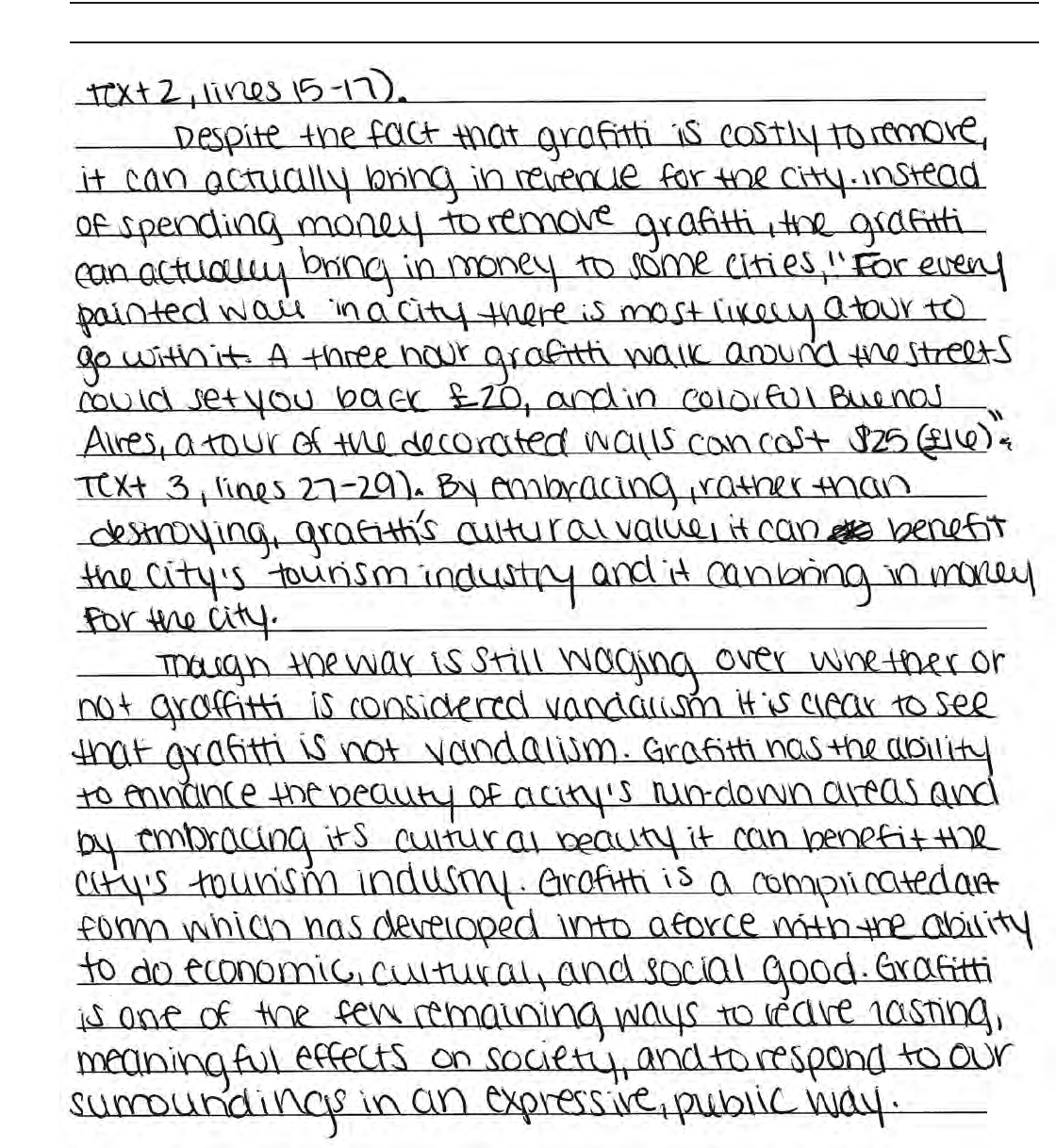
Regents Exam in ELA Rating Guide — June ’18 [51]
Part 2 – Practice Paper – E

Regents Exam in ELA Rating Guide — June ’18 [52]
Practice Paper A – Score Level 6
Holistically, this essay best fits the criteria for Level 6.
Practice Paper B – Score Level 2
Holistically, this essay best fits the criteria for Level 2.
Practice Paper C – Score Level 4
Holistically, this essay best fits the criteria for Level 4.
Practice Paper D – Score Level 3
Holistically, this essay best fits the criteria for Level 3.
Practice Paper E – Score Level 5
Holistically, this essay best fits the criteria for Level 5.

Regents Exam in ELA Rating Guide — June ’18 [53]
Criteria
4
Responses at this Level:
3
Responses at this Level:
2
Responses at this Level:
1
Responses at this Level:
Content and Analysis: the
extent to which the response
conveys complex ideas and
information clearly and
accurately in order to
respond to the task and
support an analysis of the
text
-introduce a well-reasoned central idea
and a writing strategy that clearly
establish the criteria for analysis
-demonstrate a thoughtful analysis of the
author’s use of the writing strategy to
develop the central idea
introduce a clear central idea and a
writing strategy that establish the criteria
for analysis
-demonstrate an appropriate analysis of
the author’s use of the writing strategy to
develop the central idea
-introduce a central idea and/or a writing
strategy
-demonstrate a superficial analysis of the
author’s use of the writing strategy to
develop the central idea
-introduce a confused or incomplete
central idea or writing strategy
and/or
-demonstrate a minimal analysis of the
author’s use of the writing strategy to
develop the central idea
Command of Evidence: the
extent to which the response
presents evidence from the
provided text to support
analysis
-present ideas clearly and consistently,
making effective use of specific and
relevant evidence to support analysis
-present ideas sufficiently, making
adequate use of relevant evidence to
support analysis
-present ideas inconsistently,
inadequately, and/or inaccurately in an
attempt to support analysis, making use
of some evidence that may be irrelevant
-present little or no evidence from the text
Coherence, Organization,
and Style: the extent to which
the response logically
organizes complex ideas,
concepts, and information
using formal style and
precise language
-exhibit logical organization of ideas and
information to create a cohesive and
coherent response
-establish and maintain a formal style,
using precise language and sound
structure
-exhibit acceptable organization of ideas
and information to create a
coherent response
-establish and maintain a formal style,
using appropriate language and structure
-exhibit inconsistent organization of ideas
and information, failing to create a
coherent response
-lack a formal style, using language that
is basic, inappropriate, or imprecise
-exhibit little organization of ideas and
information
-use language that is predominantly
incoherent, inappropriate, or copied
directly from the task or text
-are minimal, making assessment
unreliable
Control of Conventions:
the extent to which the
response demonstrates
command of conventions of
standard English grammar,
usage, capitalization,
punctuation, and spelling
-demonstrate control of conventions
with infrequent errors
-demonstrate partial control of
conventions with occasional errors that
do not hinder comprehension
-demonstrate emerging control of
conventions with some errors that hinder
comprehension
-demonstrate a lack of control of
conventions with frequent errors that
make comprehension difficult
-are minimal, making assessment of
conventions unreliable
• A response that is a personal response and makes little or no reference to the task or text can be scored no higher than a 1.
• A response that is totally copied from the text with no original writing must be given a 0.
• A response that is totally unrelated to the task, illegible, incoherent, blank, or unrecognizable as English must be scored a 0.
THE STATE EDUCATION DEPARTMENT / THE UNIVERSITY OF THE STATE OF NEW YORK / ALBANY, NY 12234
New York State Regents Examination in English Language Arts
Part 3 Rubric
Text Analysis: Exposition
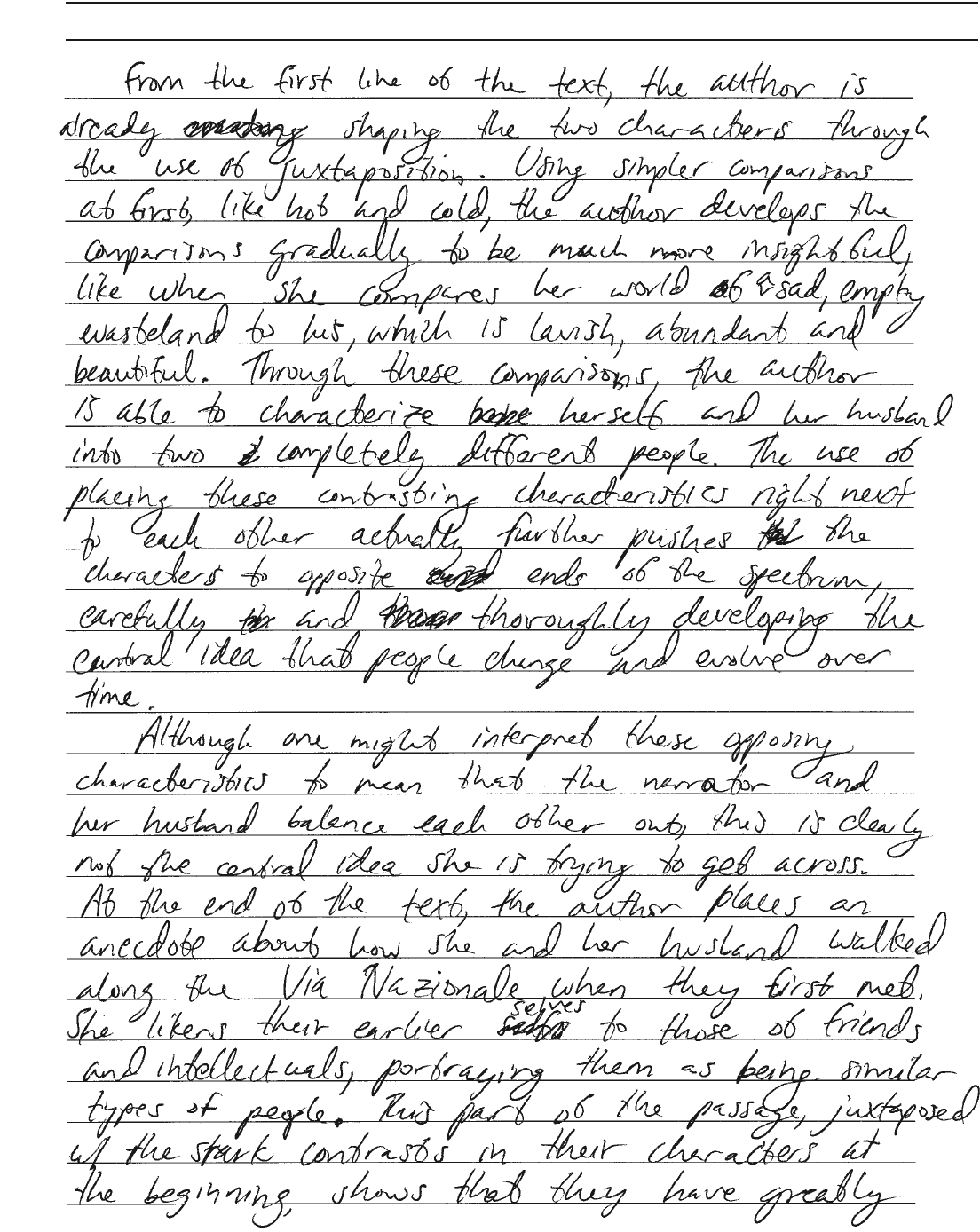
Regents Exam in ELA Rating Guide — June ’18 [54]
Anchor Paper – Part 3 – Level 4 – A
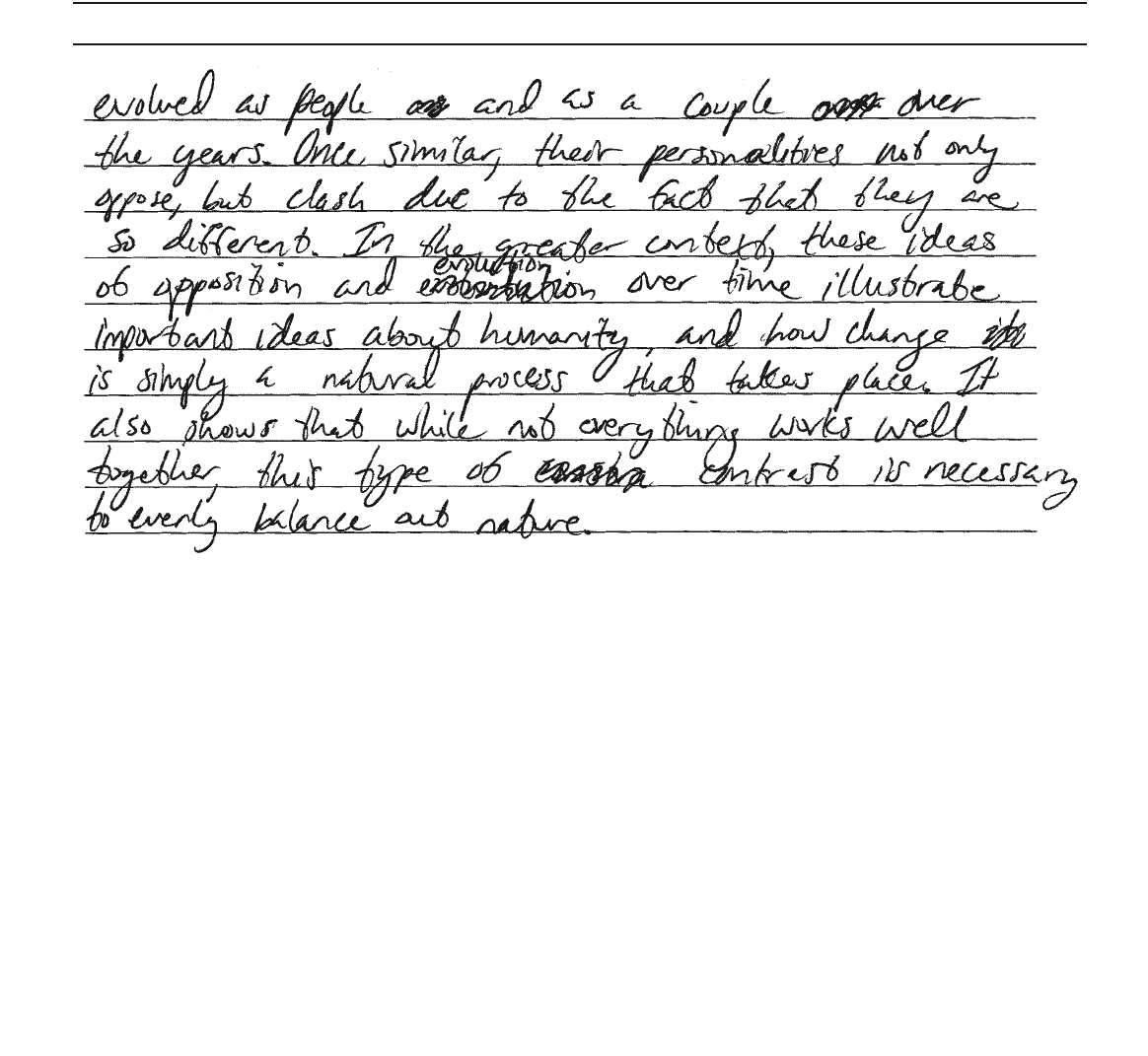
Regents Exam in ELA Rating Guide — June ’18 [55]
Anchor Paper – Part 3 – Level 4 – A
Anchor Level 4–A
The response introduces a well-reasoned central idea that people change and evolve over time and a writing strategy (From the first
line of the text, the author is already shaping the two characters through the use of juxtaposition) that clearly establish the criteria for
analysis. The response demonstrates a thoughtful analysis of the author’s use of juxtaposition to develop the central idea (the stark
contrasts in their characters at the beginning, shows that they have greatly evolved as people). The response presents ideas clearly and
consistently, making effective use of specific and relevant evidence to support analysis (Using simpler comparisons … like hot and
cold, the author develops the comparisons gradually … like when she compares her world … to his … and At the end of the text, the
author places an anecdote … She likens their earlier selves to those of friends and intellectuals, portraying them as being similar types
of people). The response exhibits logical organization of ideas and information, first introducing the author’s gradual development of
contrasting characteristics between the husband and wife to develop the central idea that people change in the first paragraph and
developing the recognition of the evolution of the relationship in the second paragraph which closes with the idea that while not
everything works well together, this type of contrast is necessary to evenly balance out nature, to create a cohesive and coherent
response. The response establishes and maintains a formal style, using precise language and sound structure (She likens their earlier
selves to those of friends and In the greater context, these ideas of opposition and evolution over time illustrate important ideas). The
response demonstrates control of conventions with infrequent errors.

Regents Exam in ELA Rating Guide — June ’18 [56]
Anchor Paper – Part 3 – Level 4 – B
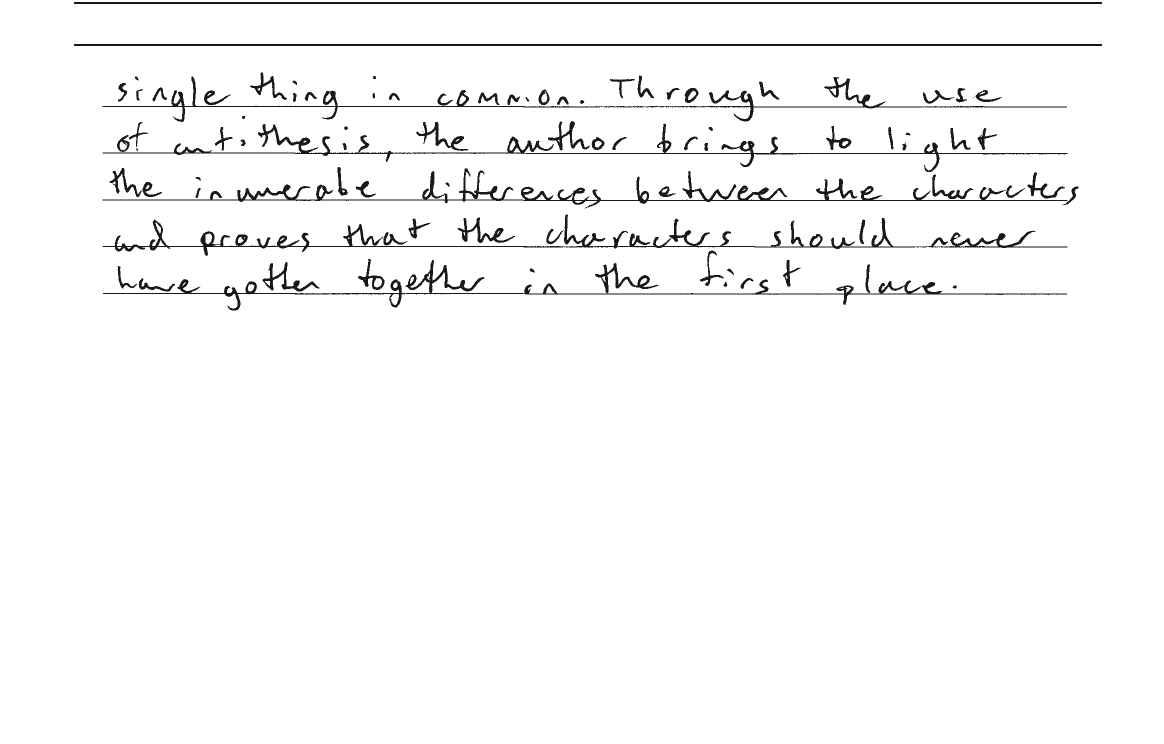
Regents Exam in ELA Rating Guide — June ’18 [57]
Anchor Paper – Part 3 – Level 4 – B
Anchor Level 4–B
The response introduces a well-reasoned central idea (If two people are very unalike, however, they probably are not meant to be
together) and a writing strategy (This is true of the text, in which the author utilizes antithesis to prove that the two main characters
were never meant to be together) that clearly establish the criteria for analysis. The response demonstrates a thoughtful analysis of the
author’s use of antithesis to develop the central idea (For instance, in the text, antithesis is used very often to prove that the main
characters are incredibally different). The response presents ideas clearly and consistently, making effective use of specific and
relevant evidence to support analysis (The man “always feels hot” while the woman “always feels cold.” The man “loves travelling”
while the woman wants “to stay at home”, and the list goes on. People this different shouldn’t be together now and should never have
gotten together in the first place). The response exhibits an acceptable organization of ideas and information to create a coherent
response by first introducing both the central idea and writing strategy, then presenting examples of how antithesis highlights the
differences in the characters and concluding with a summative analysis (Through the use of antithesis, the author brings to light the
inumerable differences between the characters and proves that the characters should never have gotten together in the first place). The
response establishes and maintains a formal style, using appropriate language and structure (This should come as no surprise,
considering their myriad of differences and while people with differences can, and do, have successful relationships, they have to at
least have something in common). The response demonstrates control of conventions with infrequent errors (incredibally; at home”,
and; inumerable).
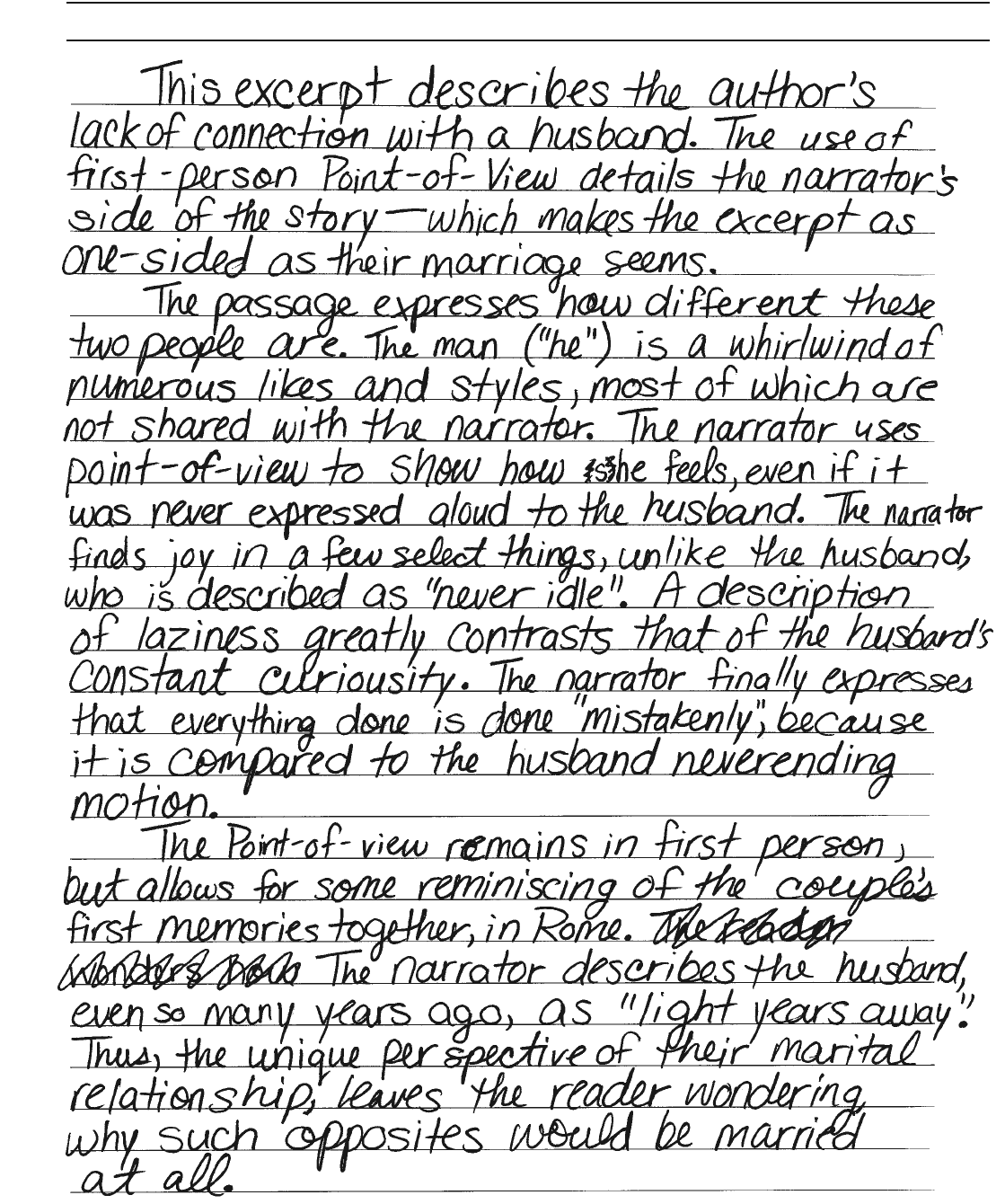
Regents Exam in ELA Rating Guide — June ’18 [58]
Anchor Paper – Part 3 – Level 3 – A

Regents Exam in ELA Rating Guide — June ’18 [59]
Anchor Level 3–A
The response introduces a clear central idea (This excerpt describes the author’s lack of connection with a husband and expresses how
different these two people are) and a writing strategy (The use of first-person Point-of-View details the narrator’s side of the story -
which makes the excerpt as one-sided as their marriage seems and the narrator uses point-of-view to show how she feels) that establish
the criteria for analysis. The response demonstrates an appropriate analysis of the author’s use of point of view to develop the central
idea (A description of laziness greatly contrasts that of the husband’s constant curiousity and The narrator finally expresses that
everything done is done “mistakenly,” because it is compared to the husband neverending motion). The response presents ideas
sufficiently, making adequate use of relevant evidence to support analysis [The man (“he”) is a whirlwind of numerous likes and styles,
most of which are not shared with the narrator and The narrator finds joy in a few select things, unlike the husband, who is described as
“never idle”]. The response exhibits logical organization of ideas and information to create a cohesive and coherent response by first
introducing the central idea and the writing strategy, then presenting examples of the contrasts between the husband and wife followed
by a concluding paragraph that reiterates the writing strategy, describing even the couple’s early interaction as “light years away”, giving
the reader a unique perspective of their marital relationship. The response establishes and maintains a formal style, using precise
language and sound structure (The Point-of-view remains in first person, but allows for some reminiscing of the couple’s first memories
together, in Rome). The response demonstrates partial control of conventions with occasional errors (Point-of-View; curiousity;
mistakenly”, because; together, in Rome) that do not hinder comprehension.

Regents Exam in ELA Rating Guide — June ’18 [60]
Anchor Paper – Part 3 – Level 3 – B

Regents Exam in ELA Rating Guide — June ’18 [61]
Anchor Paper – Part 3 – Level 3 – B
Anchor Level 3–B
The response introduces a clear central idea and a writing strategy that establish the criteria for analysis (In this excerpt the author is
about to express the central idea that your happiness shouldn’t be dictated by another person through strong word choice). The
response demonstrates an appropriate analysis of the author’s use of diction to develop the central idea (Through the use of the words
“inadequately” and “mistakenly” this person feels like everything she does is wrong and The author chose the words “sad” and
“barren” to express the mental state of mind this person is living in). The response presents ideas sufficiently, making adequate use of
relevant evidence to support analysis (No one should ever feel as if they are in a “sad, barren place” and but being told or forced what
to wear is a problem; “He is irritated if he sees me put a jumper on in the evening”). The response exhibits acceptable organization of
ideas and information to create a coherent response by first introducing the central idea and writing strategy, then presenting evidence
and analysis that support the central idea, and concluding with a reiteration of the central idea and writing strategy (Throughout this
excerpt the author is able to convey the central idea through strong diction; The happiness of ones life shouldn’t be controled by
another person). The essay establishes and maintains a formal style, using appropriate language and structure (Yes, there is failure but
there is always something to learn from it) that is at times imprecise (isn’t a risk of taking). The response demonstrates partial control
of conventions with occasional errors (their life creating, excerpt the, someone … they, reck, a controlling bossy, ones life) that do not
hinder comprehension.
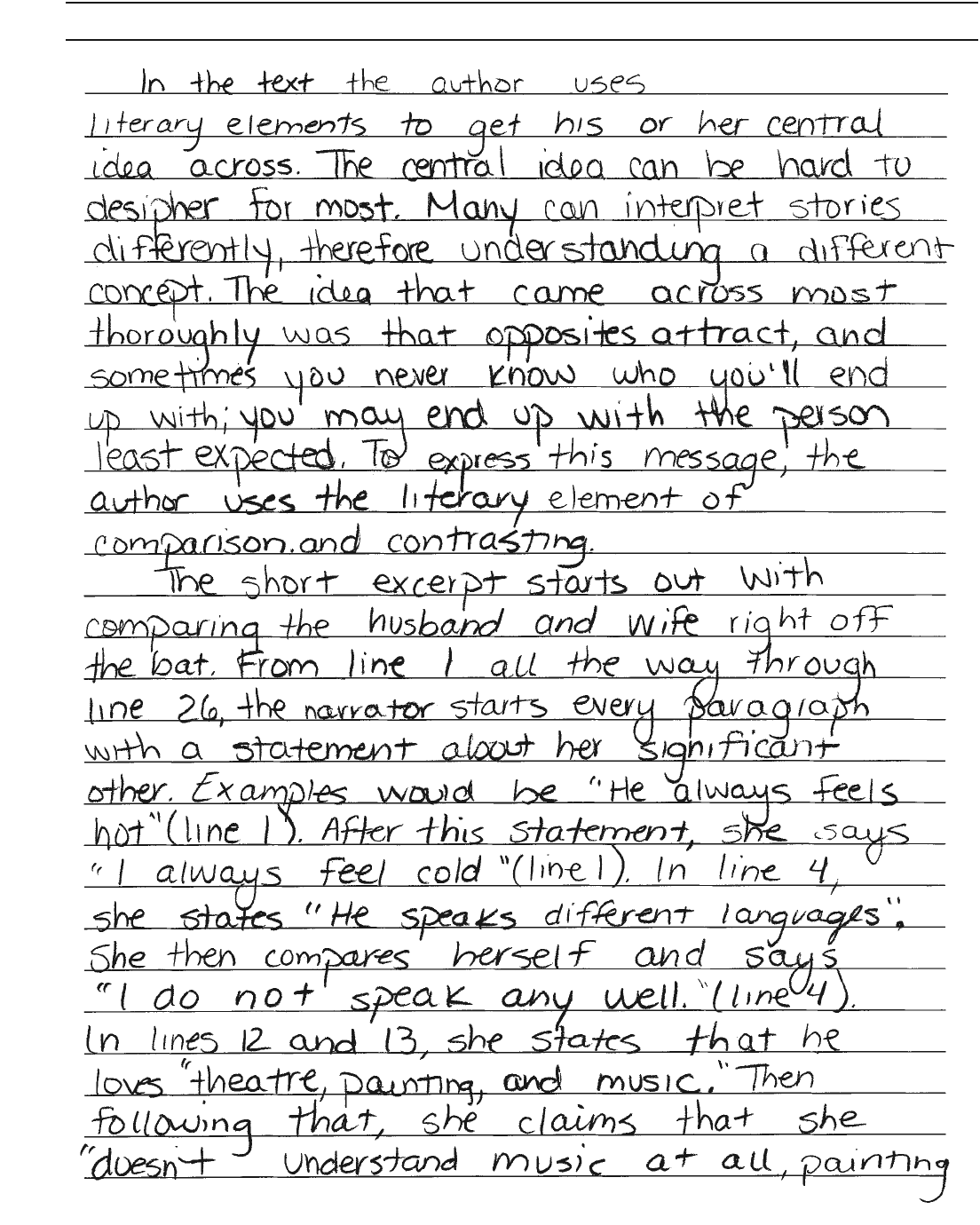
Regents Exam in ELA Rating Guide — June ’18 [62]
Anchor Paper – Part 3 – Level 3 – C

Regents Exam in ELA Rating Guide — June ’18 [63]
Anchor Paper – Part 3 – Level 3 – C
Anchor Level 3–C
The response introduces a clear central idea (The idea that came across most thoroughly was that opposites attract, and sometimes you
never know who you’ll end up with) and a writing strategy (To express this message, the author uses the literary element of comparison
and contrasting) that establish the criteria for analysis. The response demonstrates an appropriate analysis of the author’s use of
comparison and contrast to develop the central idea (she uses contrasting to show that her and her husband do not seem very similar,
but still are together). The response presents ideas sufficiently, making adequate use of relevant evidence to support analysis
(Examples would be “He always feels hot” … “I always feel cold”, “He speaks different languages” … “I do not speak any well”,
Then following that, she claims that she “doesn’t understand music at all”), making use of some evidence that may be irrelevant (she
goes on about how her and her husband met and she talks about her first impression of him). The response exhibits inconsistent
organization of ideas and information with one paragraph that introduces a central idea and writing strategy, a second paragraph that
provides examples of the author’s use of comparison and contrast and a third that strays from the main focus, failing to create a
coherent response. The response lacks a formal style, using language that is basic, inappropriate or imprecise (you may end up with the
person least expected and comparing the husband and wife right off the bat). The response demonstrates partial control of conventions
with occasional errors (desipher, comparison and contrasting; herself and says, any well, that her and her husband) that do not hinder
comprehension.

Regents Exam in ELA Rating Guide — June ’18 [64]
Anchor Paper – Part 3 – Level 2 – A
Anchor Level 2–A
The response introduces a central idea (The central idea of the text is to show how a bond can form even between the two most unlikely
people) and a writing strategy (This is shown through the text with the authors use of irony). The response demonstrates a superficial
analysis of the author’s use of irony to develop the central idea (also very ironic how they like complete oposite things and this also
shows the irony of how completly opposit people would marry each other). The response presents ideas inadequately in an attempt to
support analysis (As shown when the woman is talking about the man as she says. “He loves travelling … I would like to stay at
home.” This shows how unlikely there bond would be), relying on only two quotes from the text. The response exhibits acceptable
organization of ideas and information to create a coherent response with an opening paragraph which introduces the central idea and a
writing strategy, and a body paragraph that addresses the irony of how unlikely there bond would be. The response establishes and
maintains a formal style, using appropriate language and structure that is sometimes imprecise (there for “their” and would be but also
very ironic). The response demonstrates emerging control of conventions with some errors (authors use; Thats; irony. As; complete
oposite; met she says “I; Me.” this; completly opposit) that hinder comprehension.
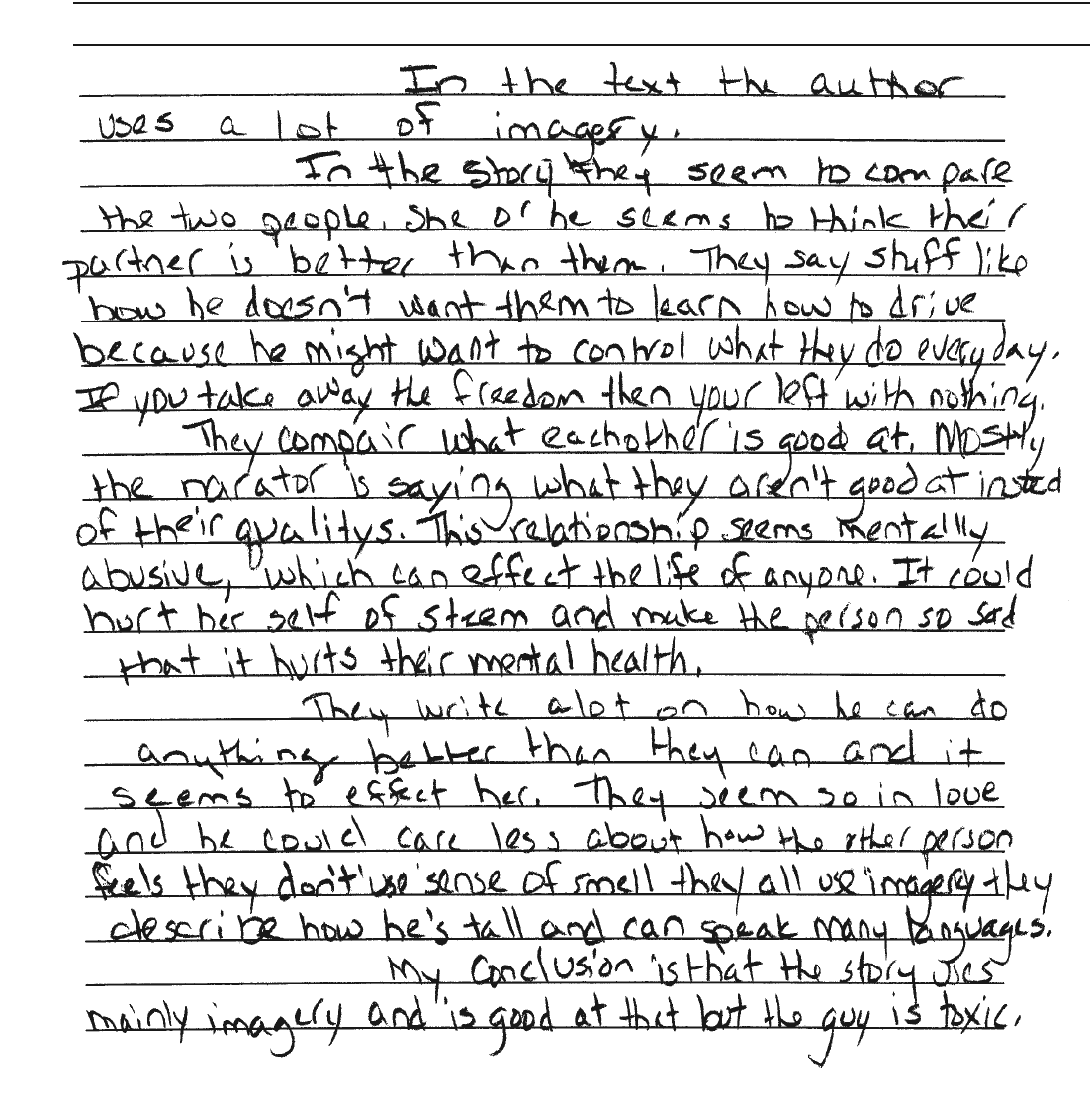
Regents Exam in ELA Rating Guide — June ’18 [65]
Anchor Paper – Part 3 – Level 2 – B
Anchor Level 2–B
The response introduces a writing strategy (In the text the author uses a lot of imagery), but a central idea is implied rather than
identified (In the story they seem to compare the two people). The response demonstrates a superficial analysis of the author’s use of
imagery to develop the central idea (they don’t use sense of smell they all use imagery they describe how he’s tall and can speak many
languages). The response presents ideas inconsistently and inadequately in an attempt to support analysis, relying more on general
observations than specific facts (This relationship seems mentally abusive, which can effect the life of anyone and They write alot on
how he can do anything better than they can), making use of some evidence that may be irrelevant (If you take away the freedom then
your left with nothing). The response exhibits inconsistent organization of ideas and information, failing to create a coherent response.
The lack of pronoun antecedents and the reliance on plural pronouns to denote a single character interferes with the text’s coherence.
The response lacks a formal style, using language that is basic, inappropriate and imprecise (they say stuff like, your for “you’re”, is
saying what, effect for “affect”, “the guy is toxic). The response demonstrates emerging control of conventions with some errors (She
or he … their … them. they, compair, narator, insted, qualitys, self of steem, alot, love and he, feels they dont, smell they, that but) that
hinder comprehension.
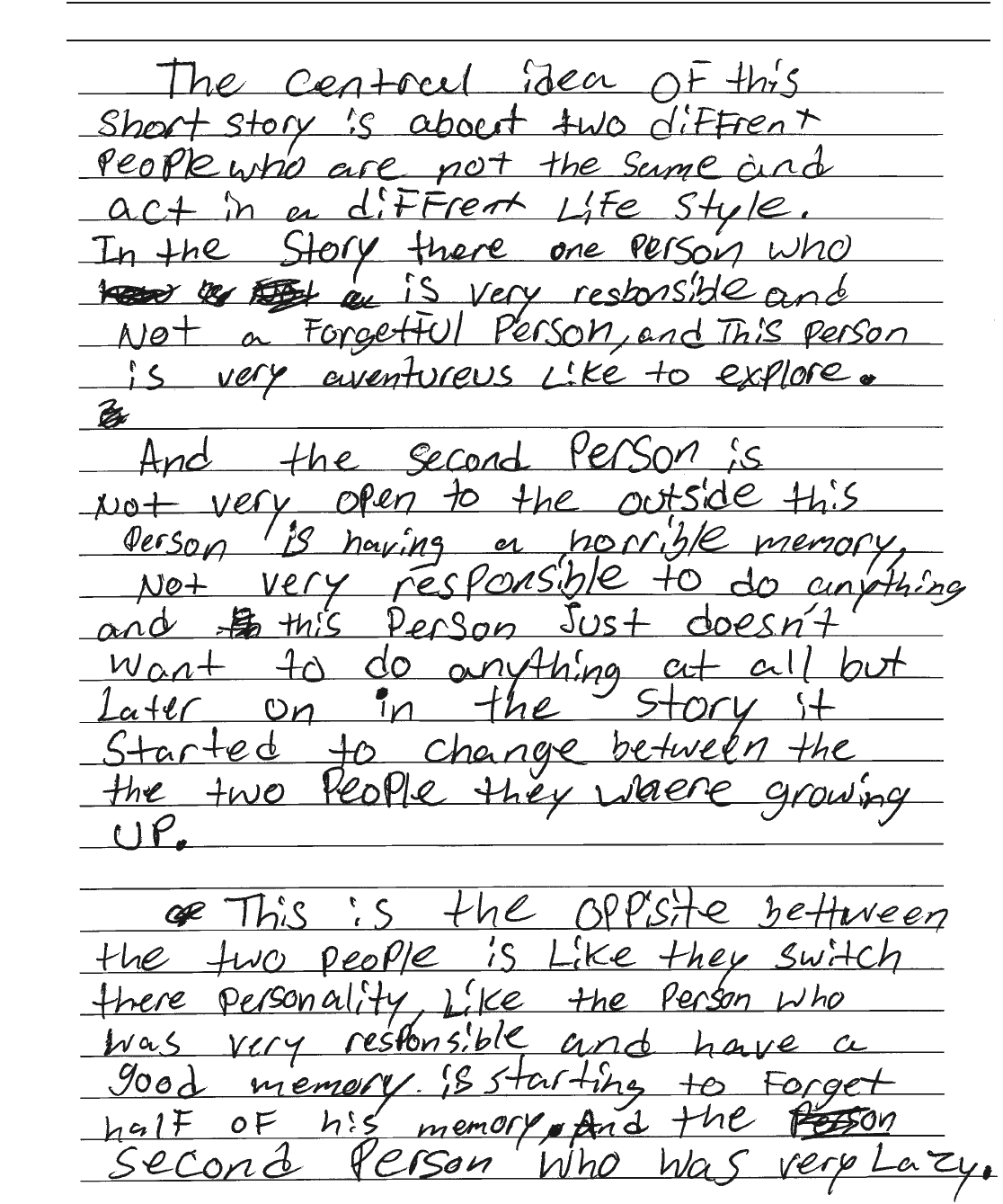
Regents Exam in ELA Rating Guide — June ’18 [66]
Anchor Paper – Part 3 – Level 2 – C

Regents Exam in ELA Rating Guide — June ’18 [67]
Anchor Level 2–C
The response introduces a central idea (The central idea of this short story is about two diffrent people who are not the same and act in
a diffrent Life style). Although the writing strategy is not identified, there is a superficial analysis of characterization to develop the
central idea (And the second person is Not very open to the outside this person is having a horrible memory, Not very responsible to do
anything). The response presents ideas inadequately, making vague references to one person and to a second person and doing so
inaccurately (this person Just doesn’t want to do anything at all but Later on in the story it started to change between the the two
people they where growing up) in an attempt to support analysis. The response exhibits little organization of ideas and information,
providing an opening paragraph that contains a central idea and reference to a person who is very resbonsible and Not a forgetful
person, a second paragraph that speaks of another person who Just doesn’t want to do anything at all, and a concluding paragraph
which contains vague and incoherent ideas. The response uses language that is predominantly incoherent (people who are not the same
and act in a diffrent Life style and This is the oppisite bettween the two people is Like they switch there personality Like the person who
was very responsible and have a good memory is starting to forget half of his memory). The errors in sentence formation affect
coherence. The response demonstrates emerging control of conventions with some errors (diffrent, there one person, aventureus like,
outside this, people they where, person who … have, memory. And) that hinder comprehension.

Regents Exam in ELA Rating Guide — June ’18 [68]
Anchor Paper – Part 3 – Level 1 – A
Anchor Level 1–A
The response introduces a central idea (Opposite types of people tend to attract and help each other), with no analysis of the author’s
use of a writing strategy to develop the central idea. The response presents little or no evidence from the text. The response exhibits
acceptable organization of ideas and information although it consists of only one paragraph that describes how peoples differences can
make them closer, and ends with a single concluding statement. The response lacks a formal style, using language that is inappropriate
(Even though the saying is cheesy and They could help you get out of your comfurt zone). The response demonstrates partial control of
conventions with occasional errors (Cheesy it is; Yourself you; comfurt; in every way peoples; someone but, it) that do not hinder
comprehension. The response can be scored no higher than a 1 since it is a personal response.
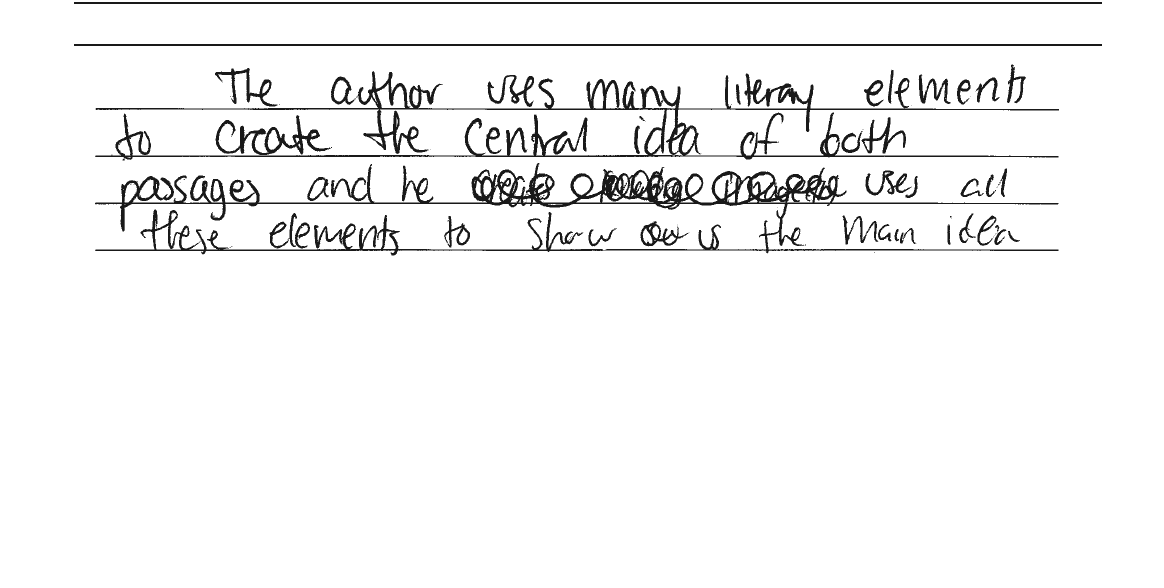
Regents Exam in ELA Rating Guide — June ’18 [69]
Anchor Paper – Part 3 – Level 1 – B
Anchor Level 1–B
The response does not introduce a specific central idea or writing strategy and demonstrates no analysis of the author’s use of a literary
element, merely mentioning the author uses many literary elements to create the central idea. The response presents no evidence from
the text. The response is minimal, consisting of one sentence, making assessment unreliable.
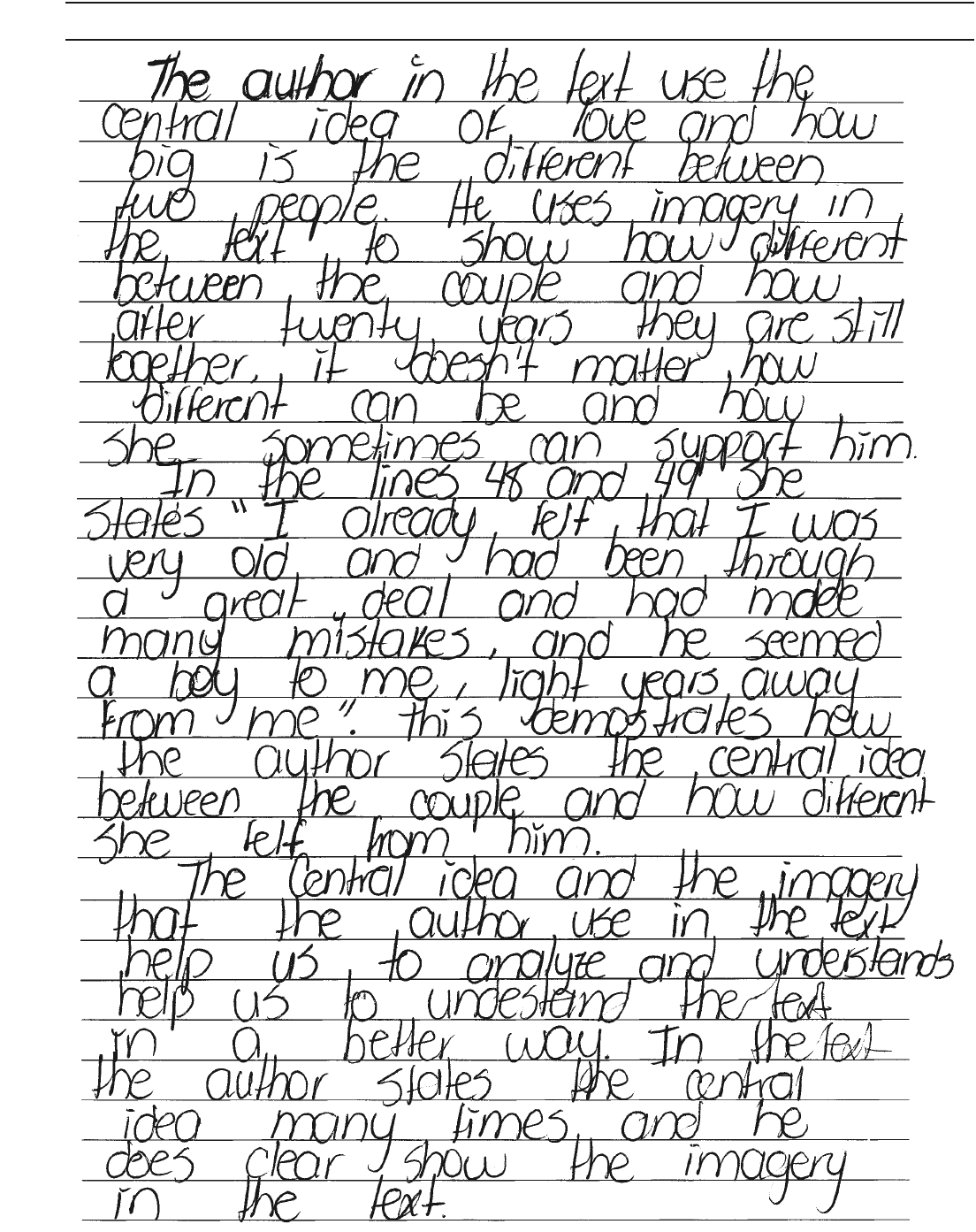
Regents Exam in ELA Rating Guide — June ’18 [70]
Part 3 – Practice Paper – A
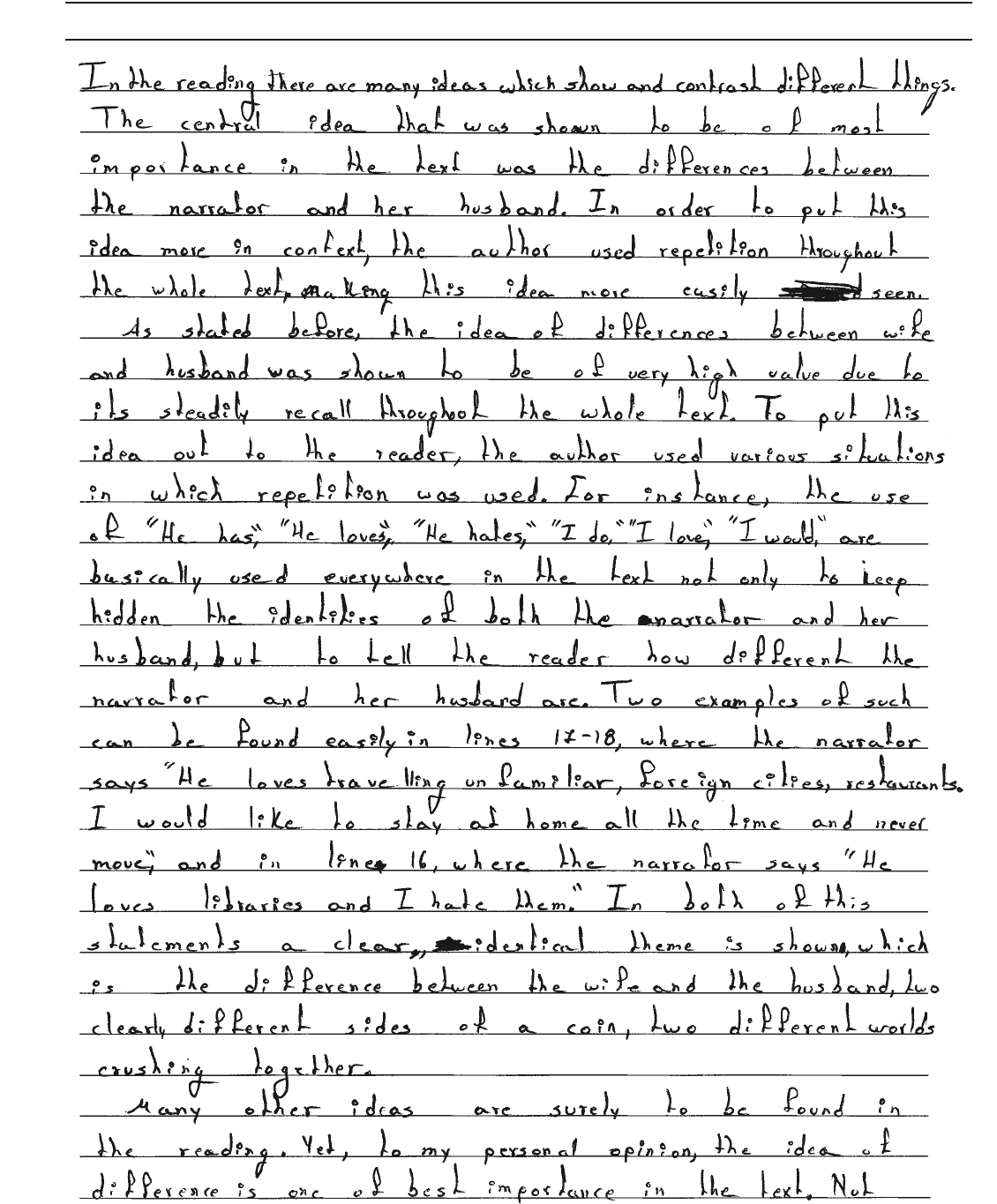
Regents Exam in ELA Rating Guide — June ’18 [71]
Part 3 – Practice Paper – B

Regents Exam in ELA Rating Guide — June ’18 [72]
Part 3 – Practice Paper – B
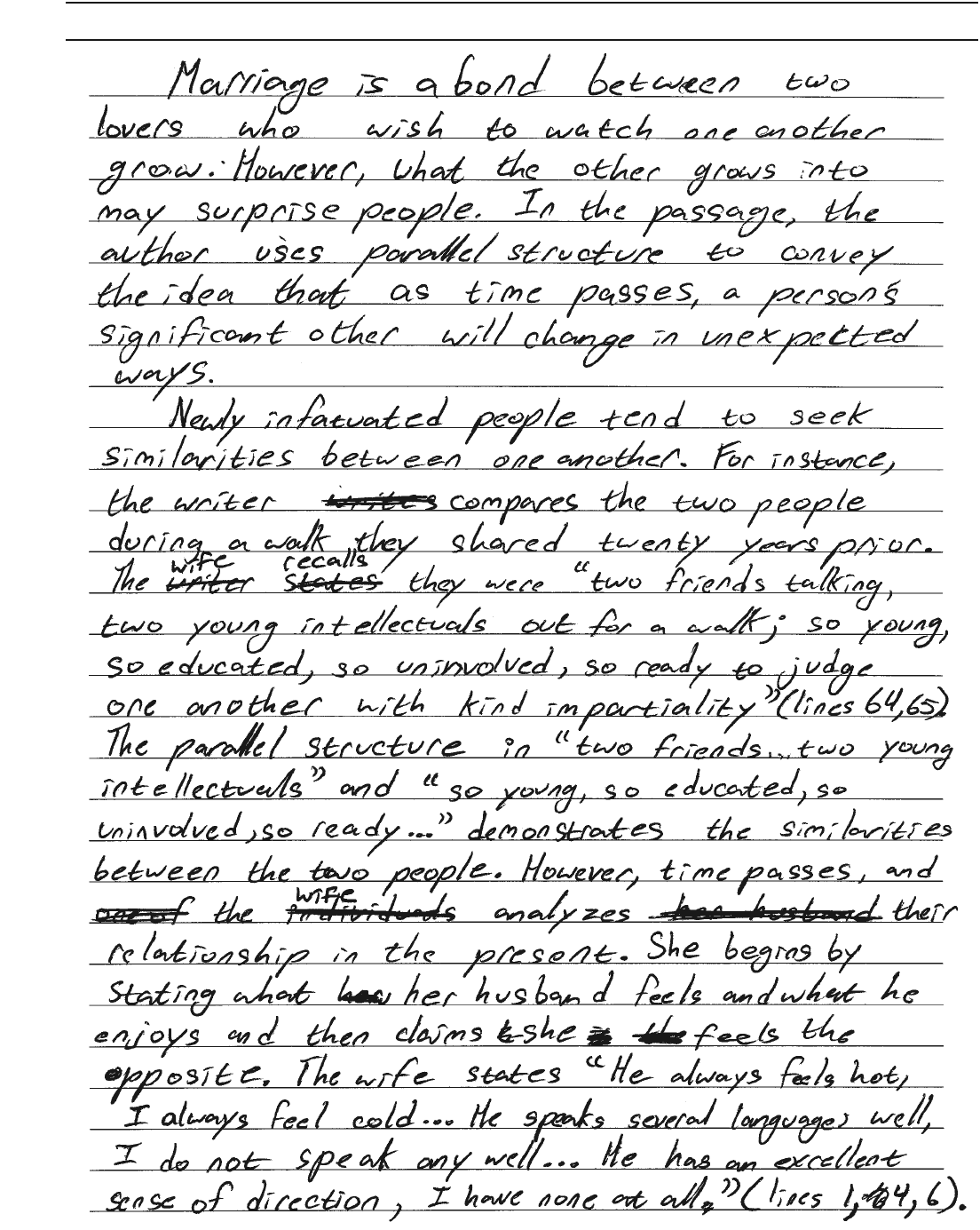
Regents Exam in ELA Rating Guide — June ’18 [73]
Part 3 – Practice Paper – C
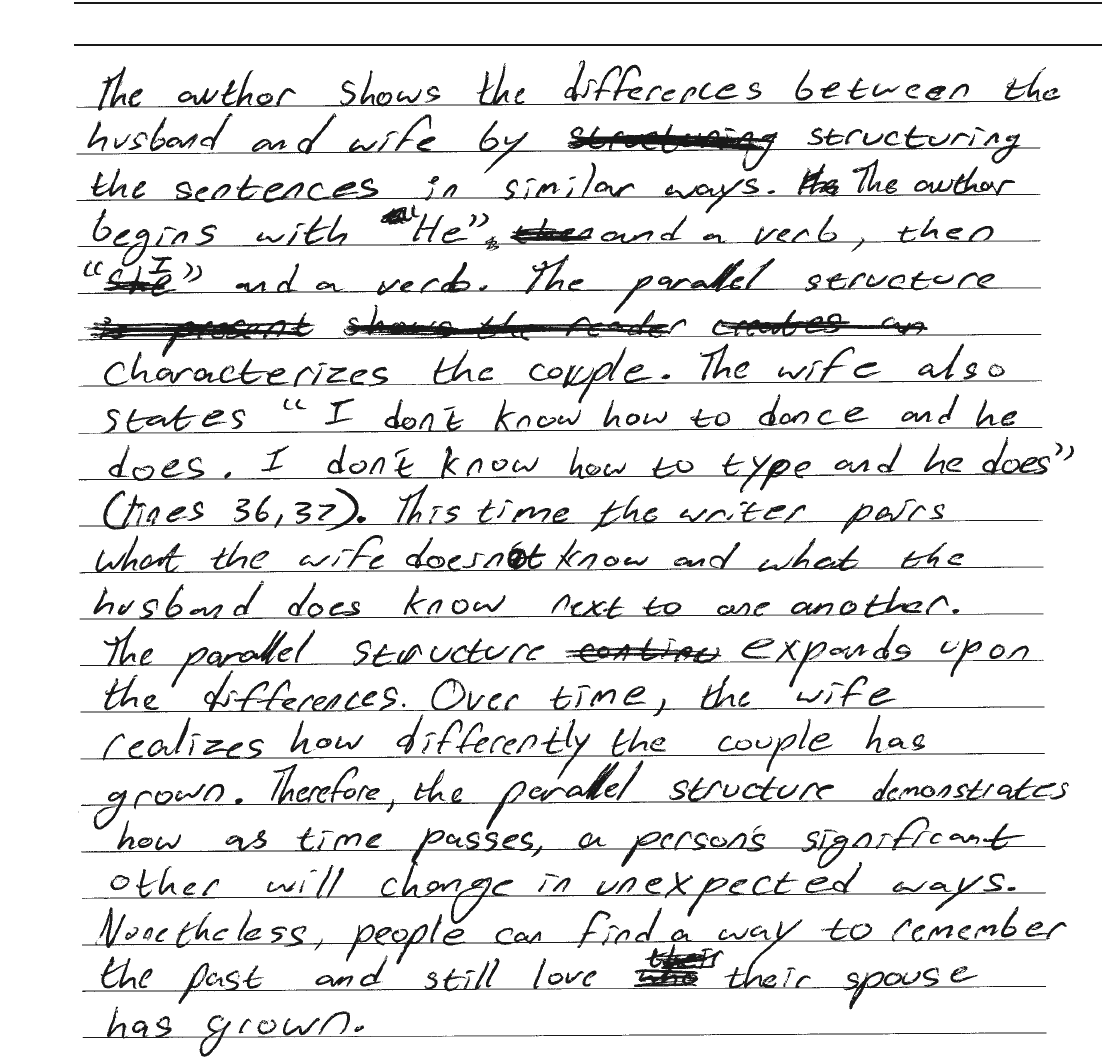
Regents Exam in ELA Rating Guide — June ’18 [74]
Part 3 – Practice Paper – C
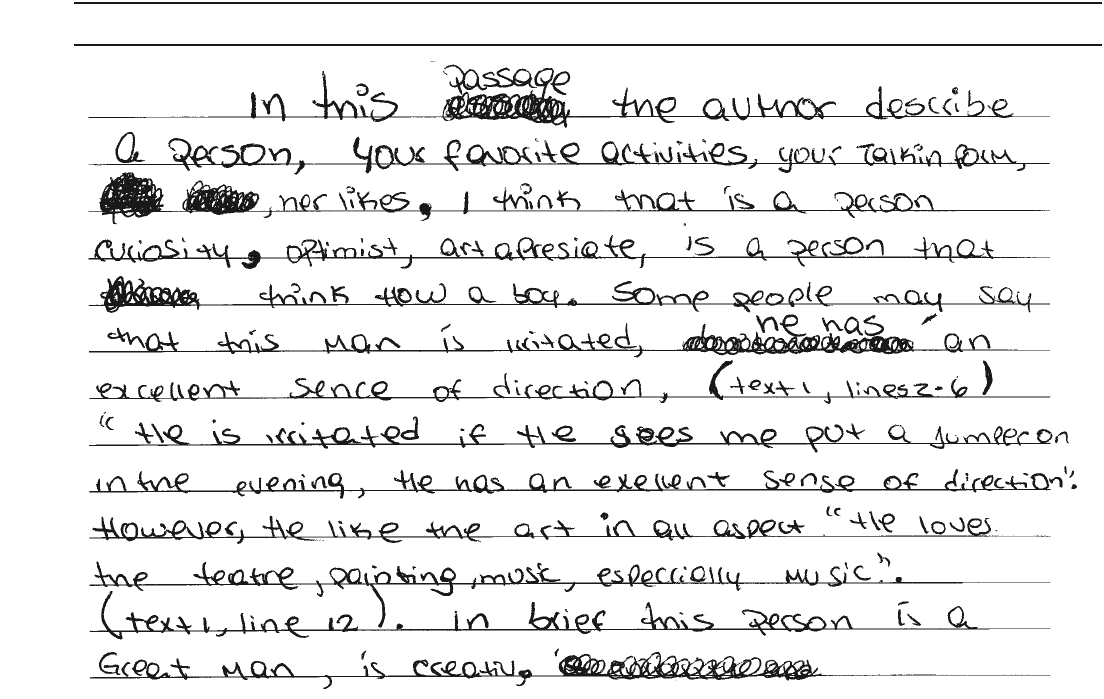
Regents Exam in ELA Rating Guide — June ’18 [75]
Part 3 – Practice Paper – D

Regents Exam in ELA Rating Guide — June ’18 [76]
Part 3 – Practice Paper – E

Regents Exam in ELA Rating Guide — June ’18 [77]
Practice Paper A – Score Level 2
Holistically, the response best fits the criteria for Level 2.
Practice Paper B – Score Level 3
Holistically, the response best fits the criteria for Level 3.
Practice Paper C – Score Level 4
Holistically, the response best fits the criteria for Level 4.
Practice Paper D – Score Level 1
Holistically, the response best fits the criteria for Level 1.
Practice Paper E – Score Level 3
Holistically, the response best fits the criteria for Level 3.

Regents Exam in ELA Rating Guide — June ’18 [78]
Map to the Learning Standards
Regents Examination in English Language Arts
June 2018
Question Type Credit Weight Standard
1 MC 1 1 RL.3 (11-12)
2 MC 1 1 RL.3 (11-12)
3 MC 1 1 L.4 (11-12)
4 MC 1 1 RL.4 (11-12)
5 MC 1 1 RL.3 (11-12)
6 MC 1 1 RL.6 (11-12)
7 MC 1 1 RL.2 (11-12)
8 MC 1 1 RL.4 (11-12)
9 MC 1 1 RL.5 (11-12)
10 MC 1 1 RL.6 (11-12)
11 MC 1 1 RL.4 (11-12)
12 MC 1 1 L.5 (11-12)
13 MC 1 1 L.4 (11-12)
14 MC 1 1 RL.2 (11-12)
15 MC 1 1 L.4 (11-12)
16 MC 1 1 RI.6 (11-12)
17 MC 1 1 RI.5 (11-12)
18 MC 1 1 RI.3 (11-12)
19 MC 1 1 RI.2 (11-12)
20 MC 1 1 RI.3 (11-12)
21 MC 1 1 L.4 (11-12)
22 MC 1 1 RI.4 (11-12)
23 MC 1 1 RI.4 (11-12)
24 MC 1 1 RI.2 (11-12)
Part 2
Argument
Essay
Essay 6 4
RI.1–6&10(11–12)
W.1, 4&9(11–12)
L.1–6(11–12)
Part 3
Expository
Response
Response 4 2
RL.1–6&10(11–12)
W.2, 4&9(11–12)
L.1–6(11–12)

Regents Exam in ELA Rating Guide — June ’18 [79]
The Chart for Determining the Final Examination Score for the June 2018 Regents
Examination in English Language Arts will be posted on the Department’s web site at
http://www.p12.nysed.gov/assessment/
on the day of the examination. Conversion charts
provided for previous administrations of the Regents Examination in English Language
Arts must NOT be used to determine students’ final scores for this administration.
Online Submission of Teacher Evaluations of the Test to the Department
Suggestions and feedback from teachers provide an important contribution to the test development
process. The Department provides an online evaluation form for State assessments. It contains spaces for
teachers to respond to several specific questions and to make suggestions. Instructions for completing the
evaluation form are as follows:
1. Go to http://www.forms2.nysed.gov/emsc/osa/exameval/reexameval.cfm
.
2. Select the test title.
3. Complete the required demographic fields.
4. Complete each evaluation question and provide comments in the space provided.
5. Click the SUBMIT button at the bottom of the page to submit the completed form.

56
100
5
27
52
1
55
99
5
26
48
1
54
99
5
25
45
1
53
99
5
24
42
1
52
99
5
23
38
1
51
98
5
22
35
1
50
97
5
21
32
1
49
96
5
20
29
1
48
94
5
19
25
1
47
92
5
18
22
1
46
91
5
17
19
1
45
89
5
16
16
1
44
88
5
15
13
1
43
87
5
14
11
1
42
86
5
13
9
1
41
85
5
12
8
1
40
83
4
11
7
1
39
81
4
10
6
1
38
80
4
9
6
1
37
79
4
8
5
1
36
76
3
7
4
1
35
73
3
6
3
1
34
71
3
5
3
1
33
69
3
4
2
1
32
66
3
3
2
1
31
65
3
2
1
1
30
60
2
1
1
1
29
57
2
0
0
1
28
55
2
The State Education Department / The University of the State of New York
Regents Examination in English Language Arts – June 2018
Chart for Converting Total Weighted Raw Scores to Final Exam Scores (Scale Scores)
To determine the student’s final exam score (scale score) find the student’s total weighted raw score in the column labeled
“Weighted Raw Score” and then locate the scale score that corresponds to that weighted raw score. The scale score is the
student’s final exam score. Enter this score in the space labeled “Scale Score” on the student’s answer sheet.
Weighted
Raw Score*
Scale
Score
Performance
Level
Weighted
Raw Score*
Scale
Score
Performance
Level
(Use for the June 2018 examination only.)
High School General Information
(http://www.p12.nysed.gov/assessment/hsgen/)
* For guidance in calculating the total weighted raw score see the Information Booklet for Scoring the Regents Examination in English
Language Arts found at:
Schools are not permitted to rescore any of the open-ended questions on this exam after each question has been
rated the required number of times, regardless of the final exam score. Schools are required to ensure that the
weighted raw scores have been calculated correctly and that the resulting scale score has been determined
accurately.
Because scale scores corresponding to weighted raw scores in the conversion chart change from one administration to
another, it is crucial that for each administration the conversion chart provided for that administration be used to determine
the student’s final exam score. The chart above can be used only for this administration of the Regents Examination in
English Language Arts.
RE ELA 1 of 1
